 "Under the Greenwood Tree"
"Under the Greenwood Tree"
The Project Gutenberg EBook of Campward Ho!, by Unknown
This eBook is for the use of anyone anywhere at no cost and with
almost no restrictions whatsoever. You may copy it, give it away or
re-use it under the terms of the Project Gutenberg License included
with this eBook or online at www.gutenberg.org
Title: Campward Ho!
A Manual for Girl Scout Camps
Author: Unknown
Release Date: September 20, 2010 [EBook #33767]
Language: English
Character set encoding: ISO-8859-1
*** START OF THIS PROJECT GUTENBERG EBOOK CAMPWARD HO! ***
Produced by David Edwards, Emmy and the Online Distributed
Proofreading Team at https://www.pgdp.net (This book was
produced from scanned images of public domain material
from the Google Print project.)
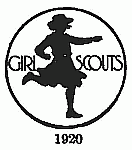

| I | A Girl Scout's Honor is to be Trusted |
| II | A Girl Scout is Loyal |
| III | A Girl Scout's Duty is to be Useful and to Help Others |
| IV | A Girl Scout is a Friend to All, and a Sister to Every Other Girl Scout |
| V | A Girl Scout is Courteous |
| VI | A Girl Scout is a Friend to Animals |
| VII | A Girl Scout Obeys Orders |
| VIII | A Girl Scout is Cheerful |
| IX | A Girl Scout is Thrifty |
| X | A Girl Scout is Clean in Thought, Word and Deed |
Someone has said, "We camp to live with Nature." If living is knowing, let us then while we camp, learn to know the great out-of-doors, and at the same time take advantage of being together, and learn to live as Scouts.
It is hoped that this little book will help to solve many problems which arise when planning for and running a camp, particularly a Girl Scout camp. The material in this manual is supplementary to that in the official Handbook, "Scouting for Girls," and is intended to be used in conjunction with it.
The information given is the result of experience gained not only as a camp Director and a housekeeper, but as a co-worker with hundreds of Scouts whose needs are very real.
Credit is due Miss Emily McClure for her article on Activities, and Miss Catherine Wilkeson for her account of A Deschutes River Fishing Trip.
We are glad to have permission to reprint "Water Front Protection for Summer Camps" by Captain Fred C. Mills of the Red Cross Life Saving Corps. The Life Saving Corps is giving the Girl Scouts the most active sort of cooperation throughout the country.
Sincere appreciation and thanks are given to Dr. Louise Stevens Bryant, Educational Secretary of the National Girl Scouts, for making the charts and editing the manuscript.
| Foreword | 7 | |
| I | Planning for Camp | 9 |
| II | Camp Directors and Counsellors | 15 |
| III | The Camper | 22 |
| IV | The Camp House | 28 |
| V | General Routine from Opening to Closing Camp | 40 |
| VI | Camp Records and Accounts | 50 |
| VII | Equipment | 64 |
| VIII | The Camp Program | 93 |
| IX | General Camp Activities | 98 |
| X | Hikes | 127 |
| XI | Camp Health and Camp Safety | 140 |
| XII | Feeding the Multitude | 152 |
| XIII | A Day in Camp | 174 |
| Some Books on Camps and Camping | 178 | |
| Index | 183 |
Planning for a camp is a matter of hours of thought and pipe dreaming, every item receiving its due amount of consideration, first in general terms, then in detail, until the whole scheme is so well formulated and all needs so well recognized and provided for that the actual camp comes into existence quite easily and successfully.
It is much more economical and satisfactory to change an idea than a building, and it behooves us all to learn the trick as soon as possible. Start to think in the winter; the fall is even better. Begin at the beginning and let no step of the way be slighted.
Shall we have a camp, and where shall it be, are the first questions that come to mind. Of course have it, even though it be for a small group only, and very simple as to equipment. The benefits derived by body, mind and soul cannot be over-estimated. The joy of finding and seeing for the first time the things that can only be found and seen in the open, living away from stilted civilization, flings open a door which rarely closes again for any length of time. Most people, and especially children, are not so far away from nature but that love and appreciation of it can be easily awakened by its beauty of color, form and sound, or its prodigality which cannot be rivalled.[10] Then to realize that all humanity is a part of this great system is to love all living things, to know they are good, and that it is fear which calls forth their antagonism, as has been proved time and time again. If such things as these can be learned by living in the open, have we not sufficient reason for providing the means to the end? Someone has said that "cutting the camp out of the Scout year is like leaving the yeast out of the bread."
A well ordered camp is built and run on the same lines as a well ordered house, as regards fundamentals. Whether it is made to accommodate a small group or an army, all who gather in it must have certain dominant needs provided for. They must eat, sleep, work, play, keep themselves and their surroundings clean, and live the group life. How these needs are met depends on the individual who makes and executes the plans. One knows how to make his camp comfortable, practical and hospitable wherever it is, and regardless of materials used, meeting all of his daily needs, while another, glorying in simplicity for a while, does without comforts which could easily be obtained. Still another casts off all law and order, to say nothing of many necessities, during his stay in the open.[11]
But when planning a camp for girls who are to receive the greatest benefits from living out of doors, and living together, there is no reason why their environment should not be made pleasing to the eye, of benefit mentally, a comfort to the body, and in accord with the best known laws which govern camping.
There are specific responsibilities to be borne by Councils or Committees who undertake to promote and establish a Girl Scout camp. The most important of these are first, to secure the money for the initial cost, and second, to obtain a Director. The subsequent work of the Committee will be determined almost entirely by the character and capacity of the Director chosen.
The prime requirement for a Camp Director is that she be able to manage a camp and the children. This means first of all, a strong reliable character, with enthusiasm and love and understanding for people, and particularly for young people. She must also have an understanding of the Scout program, as well as the aims and purposes of the Scout organization, for the children in these camps are Scouts. She must have a practical knowledge of the administration of a large household.
If in addition to these qualities she is capable of organizing and planning, the Council can feel itself lucky, because their specific work in regard to the camp is ended, and they can with assurance turn over to the Director such questions as choice of location, the camp site, arrangements for transportation, price of board, determining and selection of equipment, the type of children, and the length of the camp year.
They must not forget to give the Director not only the responsibility but the requisite authority to act, and[12] perhaps most important, be ready to give her financial backing.
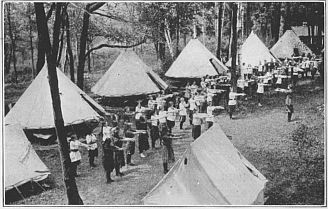 The Tent "Green." Conical wall tents accommodating eight cots. Not easy to put up and give little head room.
The Tent "Green." Conical wall tents accommodating eight cots. Not easy to put up and give little head room.
It must be remembered, however, that many women who are quite capable of running a camp do not have the particular kind of organizing ability or business training needed to establish one in the first place. It may be necessary therefore, for the Committee to divide the work among its members, or even to engage a professional buyer, or business manager. In the rest of this book it has been assumed that the Director is of the former type, and will carry the initial responsibility.
The question of transportation is the first thing to be thought of when considering locations for a Girl Scout camp. The cost, facilities, accessibility and time required would all be determining factors which when settled make[13] it possible to investigate locations within a given radius without waste of time.
There are many Scouts who would not go to camp if the cost of transportation equalled the price of one week's board, but who would on the other hand spend two weeks in camp with a smaller transportation cost. The question of shipping equipment and provisions is also to be considered, for these things can be bought to better advantage in large centers and transported by boat or rail to the camp site, than purchased from stores in a small community.
Travelling and shipping by boat is cheaper than by rail, and is often more satisfactory. Boat companies will give reduced rates to an organization sending many members on its line, while railroads rarely if ever do so.
Suburban trolley lines offer advantages over both boats and railroads, and often take one quite beyond the crowded settlements to spots of real beauty. Unless absolutely necessary do not plan for any transportation that requires a change of cars or boat. A motor or stage ride, or short hike is always to be planned for.
Having investigated transportation facilities and charges various locations would next come to mind.
Waste no time on those which do not afford a lake, a river, the sea, or a brook of good size, if the camp is to be for a large group and open for several weeks. The daily swim is as essential to the happiness of the average Scout as is her mess, and the adequate water supply for washing purposes is an essential thing to the housekeeper.
A village or town which has a post office, telegraph office, a doctor, a store or two, a railroad station or boat landing, is often the camp Director's best friend, and such a place[14] should be within hiking distance of every camp. It is there that arrangements should be made when possible, for supplying the camp with fresh milk, fresh vegetables, bread, and so forth. The risks taken by older people, or the small group that wish to be indeed far from all civilization, cannot be taken by the Director of a camp who has in her care a hundred or more children for every one of whom she is responsible. It is possible, as has been proved, to find a camp site so in the heart of the country or woods that one feels miles away from everything, and still be within reach of modern facilities.
The finding of the actual site when once the locality is determined is really quite exciting. So many lovely spots attract one's attention, but as natural beauty often deceives the unknowing, a thorough investigation is the only safe course to pursue.
The necessity for a road to the camp site is not to be forgotten. Transportation of people and supplies by row boat is too difficult.
Follow the river or brook, search the rim of the lake, or scan the edge of the sea for high ground, a knoll will do, for well drained ground, for the adequate drinking water supply (which must be tested), for fuel in abundance, if wood is to be used, for trees among which tents can be pitched or cabins built for sleeping quarters, for space for the main building, for an open space where games and drill can be enjoyed. Forget not the sun, the prevailing winds, and the western clearing where at the end of the day all the beauties of the sunset can be enjoyed, or the safe place for the campfire where songs and the real Scout Spirit bring the day to a happy end.
No one doubts for a moment that camping is a good thing for children as well as for grown people, but like many so-called "good things" the results accruing from it depend upon the person or persons in charge.
For a Girl Scout camp the Director is generally engaged by a council or a committee and is made responsible for the camp as a whole, including the health, safety and happiness of the group, the standards established and the furthering of Scout principles and aims. The Director may engage as assistants, volunteer or paid counsellors. They may be Scout Captains or people who know little about the Scout work, but whoever they are all should qualify as to character, willingness to cooperate, love for children, ability to teach or to do well one or more things, and possess a personality which will make for happiness and success.
The number of counsellors will depend on the size of the group and the work to be done. One counsellor for sixteen girls or for every two patrols is none too many. There should be a head counsellor who takes the Director's place when necessary, and who assists her in many ways; a nurse who is responsible for the personal health of the Scouts and who teaches First Aid and Personal Health; a counsellor to have charge of each subject listed on the program, a handy-man if the camp is large and there is much heavy work to be done; a cook and cook's helper, and last but not least, someone to do all that no one else does—keep records of all kinds, write letters, arrange for the coming and going of campers, supervise the canteen, and be helpful generally.[16]
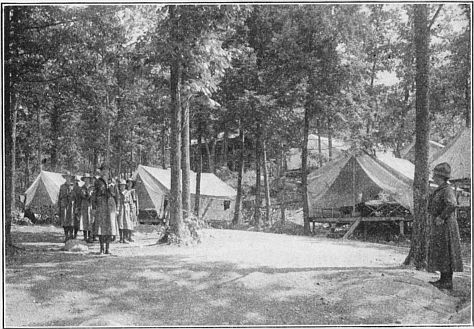 Well-built floors keep out ground damp, and make level and steady supports.
Well-built floors keep out ground damp, and make level and steady supports.
It is most desirable when possible to engage Scout leaders as counsellors, but they should qualify as do all other counsellors, for the camp specialties.
The Director must think in universal terms and put personal feelings to one side. She must aim for oneness of purpose and solve all problems that seem to block the way. She must be an example always and her imagination, understanding, resourcefulness, strength, and devotion to her work are her tools. She should understand the necessary requirements of the various groups as concerns their religious training and make provisions for helping the girls to live up to these requirements. Those who must go to church every Sunday, observe Feast Days and Fast Days, should have a counsellor of their own faith to be responsible for them. For those girls whose belief makes it necessary to abstain from eating certain foods and being[17] particular as to the dishes they use, arrangements must be made to meet their needs.
Because it is not always possible to allow each member of a large group to attend church on Sunday, especially as camps as a rule are not near communities, a simple Scout service should be arranged at which the Scout Promise and Laws are repeated, purely non-sectarian hymns are sung and a short talk given on Scout-like subjects. Great care must be taken to keep this service in accord with the policy of the Scout organization, which is absolutely non-sectarian.
A Director's specific duties vary according to the size and type of the camp and the number and duties of her assistants. She should, however, in all cases see that the program adopted is being lived up to, that the camp is in a sanitary and safe condition in every respect, that the proper food is being served, that camp regulations are being obeyed and that any illness is being cared for. She should improve every opportunity to give the children something of usefulness and value by calling their attention to the best and diverting it from all that is not helpful.
She should cultivate the ability to read the temperature of the group and when necessary to forestall difficult situations, discuss with it squarely, fairly, openly and truthfully any misunderstanding or dissatisfactions and do away with them as soon as possible.
If a Director is responsible for the money spent in running the camp she should see that there is no waste and that the greatest possible returns are procured for all expenditures. These will include such items as food, cartage, labor, salaries, canteen supplies, materials for occupational activities, necessary replenishing of household equipment, and telephone calls.
It is hardly possible to equip and run a camp on the income[18] from a low rate of board, but the running expenses should be met and the children will help by cooperating to this end if encouraged to do so, even to the point of cheerfully foregoing some of the things they like and want and are accustomed to having at home.
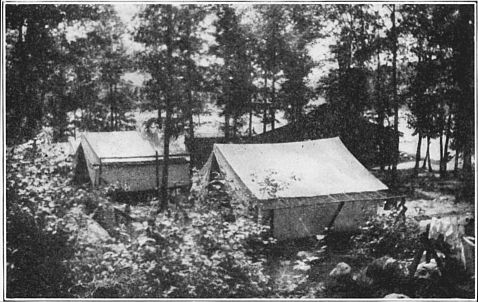 "A Slack Rag of Canvas 'Twixt You and the Stars." Shipshape tents secure from wind, set up with stakes.
"A Slack Rag of Canvas 'Twixt You and the Stars." Shipshape tents secure from wind, set up with stakes.
The condition of the equipment during and at the end of the camp season is largely in the hands of the Director. Careful supervision, and a few rules that are carried out, make it possible to use the same equipment for many seasons before it begins to show wear. An occasional accident may happen but this is unusual. It is well to remember either when working with an individual or a group that it is only possible to form habits by constant repetition. To tell a child to do something and not to see that it is done, is of little value to the child or anyone else. One of the chief duties of a Director is to know that the things are done which have been mapped out as essential to the welfare of the camper.[19]
Counsellors should meet often, even daily, with the Director and report on the work being done, make suggestions for improvements and establish a basis of cooperation. At such meetings plans for any special occasion should be made and duties assigned. If the children need time to themselves and entertainments for relaxation and to break the routine, it is also true that the Director and Counsellors must have free time to work out their individual problems and indulge in some form of play. An occasional afternoon out of camp or the opportunity to have a little party by themselves is suggested. In a large camp near the city, a full day a week should be allowed to each Counsellor.
The Director's work is unending from the opening to the closing of camp, but she has a rare opportunity to work with girls, to help them in many ways, some of which are quite personal, and perhaps to be an influence for great good in their lives. All depends however, on what she is herself, and what she considers is the purpose of the camp.
No one is fitted to be a counsellor in a Girl Scout camp who does not like to work with girls and who does not in a measure understand children. The desire to be with them, to learn from them, and to help them, is the only reason for accepting such a position. In addition one should be equipped to teach at least one subject and able to make it of such interest that it opens the mind to a new world. The ability to cooperate is another essential quality, for when living with a group, we may interpret individually, but what we interpret must be of common understanding. While patience and sympathy are both needed in group living, sentimentality is to be avoided.[20]
Hours of work have nothing to do with the duties of a camp counsellor. She is on duty in one sense twenty-four hours out of every day, but her work need not be arduous. If she becomes aware of anything which seems to be, or is likely to become, a detriment to the camp it is her duty to report the matter to the Director. There is a great deal of work which can be done by counsellors which cannot be stipulated, but which rests with them as individuals.
The right word at the right moment always bears fruit. A suggestion of tidiness to an untidy girl, a suggestion of kindness to the girl who is quick and impulsive, a suggestion to use better language, or to lower her voice or to improve her table manners, or to be more Scout-like, if made to a child alone, and at an opportune moment, means much and is appreciated. The best results are obtained when we can realize that each child holds within herself the perfect Scout ideal and that because of her limited ideas, lack of understanding, environment, the negative[21] suggestions constantly being made to her, she fails to express it. One work of the camp counsellor is to help her by example, and by word, to give up these erroneous ideas, and to stress being a Scout.
Nearly all children have a dramatic instinct and love to act. Help them to act the part of a Scout. In this way they are forming a habit that means something.
A Girl Scout camp is the Scout's own camp, and she should feel the responsibility of making it and keeping it in as Scout-like a way as possible. There are two things for her to work for, the Camp spirit and the maintaining of Scout standards. It is said that with a group, "morale" is in importance to work, as three is to one. This theory has been proved by experts who have experimented with small and large groups. It is well to make the Scout Laws the Laws of the camp. They must, however, be understood and lived up to to be effective and for this reason time must be taken each day to talk about them, discuss them and make them of practical value.
Fortunately in every Scout camp a group of girls will be found who are born leaders. Those in that group who are awake to the Scout ideals are of the greatest help in all matters and should be encouraged. They can accomplish much by way of example and in some cases can handle a situation as well if not better than a Director. Work delegated to them should be explained carefully and inspected for their sake as well as others, and any lack of thoroughness or judgment pointed out and explained that they may learn the better way.
Those girls who are negative in thought and action, should be watched and every effort made to help them to come into line. They are bound to have followers and this group causes trouble generally through misunderstanding and ignorance. There should be but one interest on the part of each camper and that is to be a Scout, not only in looks but in thought and deed. This is sometimes hard, for conditions are not all as they are in one's home, and[24] to adjust one's ways of living, especially in regard to eating, is not easy.
It might be well for the camper to realize that the object of a Scout camp is to give the best and as much as can be paid for by the income from board, and that the price of board is small in order that all Scouts may share in the joys of living in the open. With these facts in mind it is easier to accept conditions that may not be just to our liking. Wherever we choose to live, indoors or out of doors, alone or as one of a group, we have to face certain facts which must be dealt with and not ignored if we would be healthy and happy and have our surroundings livable.
In dealing with these facts there is certain work to be done which a good many people call "drudgery," but if this work were neglected those very people would be the first to complain.
We must eat to live, therefore, food must be prepared, cooked, and served, dishes washed and wiped, tables set, and kitchen and mess hall kept clean in every respect.
We must sleep to maintain health so beds and bed-clothing are necessary. These need care as well as the sleeping room, and all personal belongings in it.
We must be clean to be decent, and try as hard as we will, trash collects and must be properly disposed of. Wash houses and latrines are necessary and they must be kept clean.
Who should be more interested in doing this work and in doing it well than the Scout herself? She should take the greatest pride in keeping her camp up to the highest standard always. It can be done without great effort on the part of any one Scout if each one tries to remember a few things, among them:
1. That thoughtfulness reduces the amount of work to be done and saves time and money.[25]
2. That unless the work is done conditions will be unbearable and camp will close.
3. That the work she does benefits herself as well as others. It is the waste and trash thrown or laid down where it does not belong, work half done that has to be done over, thinking of our own desires instead of the Scout standards, that are at the root of any trouble. Do not call the camp duties drudgery, call them opportunities for service.
4. The fact that the Girl Scout pays board does not absolve her from this work. If the Scouts do all that they can to be of service, and serve cheerfully, many opportunities are offered them that otherwise would be prohibitive.
Every girl entering a Scout camp has placed before her a camp program which if taken advantage of offers her the[26] best the camp affords. There are always girls who accept the program and use it in full. They know that in order to BE PREPARED they must grasp every opportunity to develop along Scout lines. On the other hand there are girls who seem too lacking in interest, too blind to the opportunities, too inert to take advantage of it, and they leave camp having missed the very things for which they came.
The helpful Scouts who belong to the former group are real camp helpers, and the Director can always depend upon them, the Counsellors can depend upon them, and they are the power which makes or mars the success of the camp.
It is in camp that girls have the opportunity to express themselves along lines quite different from those used during their ordinary daily life. Entertainments are always hailed with delight, and any Scout who does a good stunt, takes part in a play, or gives expression through dancing, reciting, or singing, is contributing to the fun and joy of all.
Aside from parties and plays and other fun-giving times, there is Scout work which can be done in camp better than anywhere else. This work includes the study of nature lore, woodcraft, certain forms of handicraft, swimming, and hiking. The advantage of spending a part of each day on these subjects as well as the Grade Tests and Merit Badge tests, is found in the fact that the Counsellors are prepared to give the work in the best possible way and under the best conditions.
Also there is inspiration in seeing what other girls do and in trying to do as well if not a little better. Then too, what is learned in camp is taken back home to the girls who have not been privileged to go to camp, and they gain through the camper's experience. There are a few things which every Scout should know after living in the open[27] for a few weeks. One is that we are dependent upon people, and that people are dependent upon us; therefore, we must equip ourselves to give; another is that the great out of doors is full of interesting things which can give us far greater happiness if we learn to know them and try for a time for each year to live with them, than the things to which we turn during the winter for recreation and excitement.
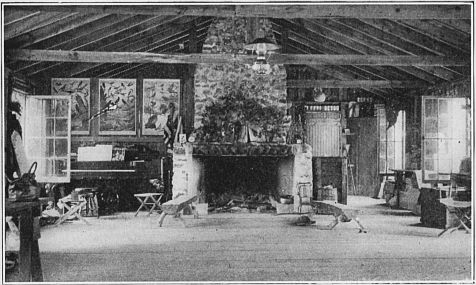 The Camp Living Room
The Camp Living Room
The kind of shelter which will be suitable and practicable for your camp depends more or less upon the number of people to be accommodated, the length of the camp season, and the camp site. For short time camps, for small groups, or for older people, or when building is impossible, tents only can be used. In such cases there would be need of a tent for a mess and assembly room, a tent for the kitchen, a small waterproof tent in which to store provisions, a small tent for covering a latrine and tents for sleeping quarters.
The main tent for a mess hall and assembly room combined, should be large, placed with some regard for a view of the surrounding country, sun, air and general camp scheme. (p. 25.) It should be furnished with tables, benches, and so forth, all of which can be moved out of the way when the room is to be used for recreational purposes. The kitchen should not be too far away, but back of the main tent and should be so placed that all of the air possible may blow through it. There should be a long cook table with a shelf over it, if possible, hung from the ridge pole, or supported with uprights fastened to the table. Also a table which can be used for dish washing.[29] It would be well to have in addition to the kitchen stove which is in this tent, cooking fire places outside of the tent which could be used in pleasant weather. One of the most practical of these is built of stone, with a back wall and two sides, with two rods, the ends resting on the side walls and near enough together to hold the average size pots and kettles. If stones are not available two large logs can be placed V shape not quite meeting at the narrow end, 1½ feet apart at the other end, and the fire built in between. Cross bars of iron or a grating can be put over the fire to hold the pots and kettles. While it is convenient and practical to use out of door fire places for cooking when the group is very small it is most difficult to do so when the group is large. The work can be done, however, with greater ease by the use of the iron bars already spoken of.
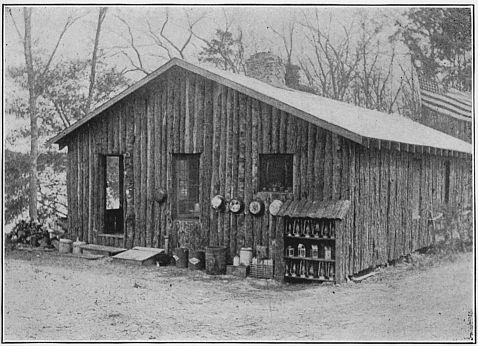 Business End of the Camp Hall
Business End of the Camp Hall
The storage tent can have portable shelves and a low platform on which to place barrels, boxes, and so forth. This tent should be pitched under a large tree where it will be in the shade all of the time. A good store closet can be made by digging into the side of a hill, boarding the inside or facing it with stone and putting in shelves, and having a very thick, well fitted door.
A more simple storage room, but not advisable except for a small camp, is to dig a hole in the ground, line it with stone, place boards over the top, leave a small opening for a lid or a hinged trap door and cover the boards with earth, leaving the door free. If ice is available a piece put into a pail can be set in this compartment.
In all of these out of door store places great care must be taken that no animals, insects or flies get at the provisions. Covered tins, or dishes and bags can be used for safety. When the camp is to be opened only for a short period it is quite possible to put provisions into pails tightly covered and set in running water in the shade.
Whenever tents are to be used in a camp, they should be purchased with care and pitched properly. There are on the market several different types of tents: the army wall tent (p. 10.) which should always be pitched with a fly and be opened at both ends, the conical and the pyramidal tents. The two latter are not recommended for general use. They are erected with one center pole, which is always in the way, and have to be pegged to the ground, thus making guy ropes a nuisance rather than a convenience. These tents are, however, picturesque in effect. (p. 12.)
When ordering tents always stipulate the size and the weight and width of the material to be used. Army[31] duck, 10 oz. double fill for the tent and 8 oz. double fill for the fly, width 29 inches, will give the best satisfaction.
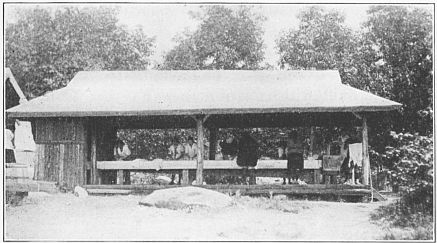 The Wash House for Personal and Laundry use. Faucets hang from above. Inclined trough between two shelves, the whole, zinc covered, runs length of house. Two soapstone tubs for extra hard scrubbing at right. Special compartment at left for officers.
The Wash House for Personal and Laundry use. Faucets hang from above. Inclined trough between two shelves, the whole, zinc covered, runs length of house. Two soapstone tubs for extra hard scrubbing at right. Special compartment at left for officers.
The size of the tents for sleeping will depend somewhat on the character of the site. Where the ground is very sloping, trees close, space limited, small tents will have to be used; either 7 x 9 or 9 x 9's. These tents which will accommodate two people, should always be used to house counsellors, but are not recommended for children as a general thing. The larger tents, 14 x 14 or 14 x 16 will accommodate eight cots and give ample space for personal equipment.
For short trips there are small lightweight, waterproof tents which can be rolled so that they take up very little space in transportation. They are pitched over ground cloths, with one pointed rod and metal spikes for pegging the tent to the ground. These tents hold two people. (pp. 78, 80, 82.)[32]
Tents should always be pitched over wooden floors which are raised well from the ground. (p. 16.) They should be built with square corners and braced on the under side. The dimensions of each floor should be the same as the length and width of the tent to be pitched over it. They should only be put into place after considering the direction of the sun, the prevailing winds, their relation to each other and the general camp plan.
Large floors should be raised several inches from the ground and supported with posts or flat stones at each corner, at the center of each side and at intervals under the center of the floor to keep them from sagging. When putting up a wall tent instead of using pegs, build a frame work running parallel to the sides of the tent to which the guy ropes can be fastened. (p. 18) This frame is made by driving into the ground opposite the two sides of the tent floor, and 3 feet from it, three posts, each 3 or 4 inches in diameter, and long enough to extend when set, above the tent floor a distance equal to the height of the tent wall, plus five inches. One post should be placed opposite the center of each side, the others on a line with it and opposite the corners of the floor. Nail securely to the outside of the posts and two or three inches from the tops a strip which will extend beyond the end posts 6 or 8 inches. Unless the ground is rocky the posts need not be braced. If care is taken to measure and place the posts correctly the frame will be evenly made and look trim. Small tree trunks can be used for posts and strips, where wood is plentiful; otherwise 2 x 4's can be used.
Where tent floors are found to be prohibitive, tents must be pitched over dry, well drained ground. In addition[33] a ground cloth should be used and a ditch dug on either side of the tent to carry off rain water.
Tents without floors are of course used when hiking or camping for a short time only, or in exceptional climates. (p. 20.) Specific directions for pitching tents are given in a later section.
A small group of girls wishing to build their own camp could make two or three lean-tos, using trees five or six inches in diameter, saplings, boughs and vines, the latter for binding the thatch roof to the beams. The lean-tos should be faced so the sun will shine into them some part of the day, turned away from the prevailing winds and each one should have in front of it a fireplace to be used for cooking as well as for keeping the lean-to dry and warm. (pp. 105, 110, 112.)
A group of girls could also build a slab house with a good floor, a wooden roof covered with tar paper, windows, door and even build a fireplace, the completed building giving them permanent camp quarters. (pp. 96, 118, 122.)[34]
Whenever possible it is most desirable to erect for the main camp building a house, rustic in design if built in the woods, (p. 23.) which includes a large room for mess hall and recreational purposes, kitchen, store closet, ice room. (Cut A.) The types and floor plans of such houses vary greatly, but certain things are essential in all. They should afford protection in bad weather, some warmth in cold weather, ample space for serving mess, room for entertainments, meetings and so forth; a conveniently arranged kitchen, and proper facilities for the care of food. Some of these houses are built with the main room simply roofed over and railed in. As delightful as these open mess halls are in pleasant weather, they are not altogether practicable in all climates, and under all weather conditions.
Some protection is gained by enclosing the room to a height of 3½ or 4 feet and having the eaves overhang for 3 feet, or by having canvas curtains which can be raised or lowered in bad weather. If the room is enclosed entirely it should have many large windows, and wide outside doors.
The main feature in the room should be the fireplace. (p. 27.) The larger it is the better so long as it is in keeping with its surroundings. The benches and tables should be made and arranged so they can be easily moved out of the way when extra floor space is needed.
There should be a door leading into the kitchen and a serving window near the door, with a broad shelf on either side of it. The kitchen needs many windows and a back door conveniently placed. (p. 29.)
The kitchen should be equipped with a good stove having ovens and hot water tank and be large enough[36] to admit of holding big boilers and kettles. If there is no hot water tank a large boiler can be kept on top of the stove in which to heat water. Better still, when possible, use a Standard Oil oil heater and boiler, and have hot water pipe connections. This of course is only possible when there is a tank and power of some kind to pump up the water. There should be in the kitchen ample table space, convenient places for keeping all pots and kettles, hanging spoons and other small articles, a generous wood box that there may always be dry wood at hand, and if there is running water a sink conveniently placed.
The store closet should open out of the kitchen and be on the north side of the house. It should have a raised platform 18 or 20 inches wide, against the wall on one side of the room, on which should be placed all barrels, large boxes, etc. holding food. There should be ample shelf space, a broad table, plenty of ventilation, and all windows should be covered with netting.
If possible to have an ice box it can stand in this room. Better than a portable ice box is an ice room which is built into one corner of the store room, the walls, floor and ceiling of which are double, lined with tar paper and the space of four inches between them filled with sawdust or cork. The door into the store room should be very heavy, made double and fitted closely. The small ice door can be on the outside of the building, made like the large door, fitted closely and opening into the ice compartment. The ice compartment should be lined with zinc and a slatted door should open into it from the ice room. The bottom of the ice compartment should tip slightly to one corner from which an overflow pipe should be run to the outside of the building. A slat bottom made in sections and placed in the compartment protects the zinc and helps to preserve the ice. The ice compartment can be high enough from[37] the floor to admit of large milk cans, tubs of butter, etc., being stored under it. Shelves can be placed along the sides of the walls. The ice room should be ventilated by means of a vent pipe up through the roof to the open.
Such a building as described makes housekeeping for a family of one hundred and fifty or two hundred possible, with only one cook and a squad of Scouts.
In place of tents for sleeping quarters small cabins made of wood and screening, or wood, canvas and screening, can be used. They add greatly to the expense of building the camp, but being permanent do away with the expense and labor of taking down and storing.
It is sometimes possible to find an old house or a barn which can be utilized for camp quarters, and with a little ingenuity made most attractive and practical.
There is a great deal to be learned by living in a well-planned, well-ordered house or camp, much of which is of lasting value. For this reason no opportunity should be lost to give these advantages to the Scouts.
A wash house for general use is most desirable. Where there is no running water a long table covered with zinc and placed under a tent fly, a board walk either side of the table, and three or four large pitchers for water is a good arrangement. This equipment should be placed in an open, sunny spot where the drainage is good, and away from the tents if the waste water is to be thrown out on the ground.
Where a group is small every six or eight girls may have a shelf placed between two trees, which would serve as a wash stand. Pitchers must be provided for each stand and a system for keeping them filled worked out.
A type of wash house which is most satisfactory[38] where there is plumbing, is made as follows. (p. 31.) Build an oblong platform and over it a roof supported by posts and covered with tar paper. Through the center of the house build a trough, with inclined bottom, and a shelf slightly tipped toward the trough, either side of it. Cover the inside of the trough and the shelves with zinc. At the lower end of the trough have a waste pipe which runs into a cesspool. Over the trough supported from the roof run a water pipe from which depend at intervals, pipes with automatic faucets. At the low end of the trough two wash tubs can be placed at right angles to the wash table both of which should connect with the trough drain pipe. Enclose the other end of the house and make two small private wash rooms, the partition between them being over and under the center of the trough, a faucet in each. These rooms are to be used by counsellors, or by children when given special permission.
The Scout Laws are the Laws of this camp: apply them at all times and see what happens.
Camp boundaries are for a purpose, do not go beyond them without permission from a counsellor or the Director.
Rest hours, from taps to reveille and after dinner, are a necessity to health; observe them by sleeping. Do not talk, it disturbs others.
For the sake of cleanliness take no food of any kind, or liquids of any kind into any tent used for sleeping quarters.
Keep the Health Record of the camp high by reporting at once to the nurse or Director any sickness, accident or ill health.
First aid supplies when required can be obtained from the nurse, no one else is to touch them.
Trash boxes are labor saving devices, use them for all trash, rather than throwing the trash on the ground.
Food sent or brought to camp for individual Scouts will not be delivered.
After the site is obtained, necessary buildings finished, grounds cleaned, stove in place, water tested and connections made if there is to be plumbing, the equipment and provisions should be sent in to camp. A week is none too long a time to allow, even if there are many hands to unpack, put the camp in running order, make out the program, camp regulations, etc., and select sites for classes.
If possible have the counsellors spend this week in camp with the Director and help in doing this work. Being together for work and some play will prepare them to take up the duties of the summer and if any of them are not Scouts then is the time to tell them of the Scout work, its aims and so forth. Without this information it is difficult to have true cooperation.
When opening a large camp be sure, when the campers arrive, to have it in the condition in which it is to be kept. First impressions are deep impressions as a rule, even though unfair many times.
Perhaps the most difficult work to be done, especially for one who knows little about it is the pitching of the tents, yet when simple rules are followed the task is not beyond a group of young women even when the tents are large. Remember that the beauty of a tent lies in its trimness. It should look smart. The canvas must have no wrinkles, poles must be straight, ropes taut and properly fastened.
First of all see that the tent floors and frame work are as they should be, or lacking a frame work, that pegs are[41] at hand. Examine poles and make sure they are of the right height and length for the tent. If a wall tent is to be pitched lay it on floor, inside down, the fly on top of it. Run the ridge pole under the center of the tent from end to end curved side next to the canvas; at either end of the tent at right angles to the ridge pole and parallel to each other place a tent pole which is the right length for the height of the tent. Put the spindle in the end of each pole through the holes in the ridge pole, and the eyelets in the tent and tent fly ridge.
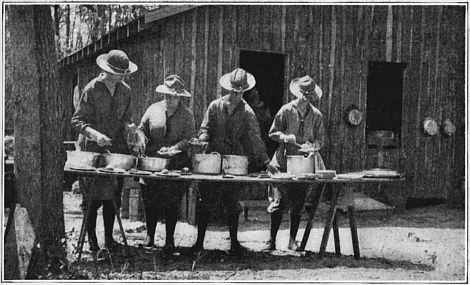 Serving Table
Serving Table
Two people, one at each pole, on signal, raise the tent into position by lifting the poles and carrying them into place. They should stand opposite each other, at the center of either end of the tent floor. While the poles are held in place, two other people should fasten temporarily the corner ropes of the tent and fly. Tie the flaps into position, fasten the corner rope loops in the bottom edge of the tent to nails in the edge of the floor, and proceed to adjust the guy ropes. Do not pull the tent out of line[42] or have one rope tighter than another. Use a clove hitch for tying the ropes to the strips. The ropes of the tent should go under the strip for the first turn, the fly ropes over. By so doing the roof of the tent and the fly will be kept apart, a most important point; in fact they should never touch except at the ridge.
Fasten the tent to the floor by putting the rope loops in the bottom of the tent over long nails driven into the edge of the tent floor at the proper places. When all ropes are fastened and the tent looks as it should, loosen the bottom at each end, untie the flaps, and hold them back by fastening one of the ropes in the bottom of the flap into the loop at the top corner of the tent wall.
Put the tent number on each pole. Cots can now be opened and placed, blankets shaken, sunned, folded and put on the foot of the cots with a pillow inside of each blanket. Basins go under the cots toward the head.
While four or five people are attending to the sleeping quarters others should be washing, wiping and putting away all table ware, and the cook arranging the kitchen, store room and ice house. All small equipment must be put in place; a tent or room provided for the nurse's quarters and First Aid supplies unpacked, an office equipped with all necessities, counsellors' tents put in order, firewood stacked, lanterns cleaned and filled, wash houses, latrines, bath house, boats in readiness, program and camp regulations posted, in short, everything in order, for when one hundred or more Scouts descend upon a camp, everyone is kept busy helping them and there is no time to be given to equipment.
Special mention must be made of two things: first, the precautionary need of fire extinguishers to be hung in the kitchen, mess hall, and other wooden buildings, (buckets of water not being advised unless chemical extinguishers[43] are not obtainable); second, the importance of the Director's office being equipped with record books, files, stationery, and a money box; all very simple, but there.
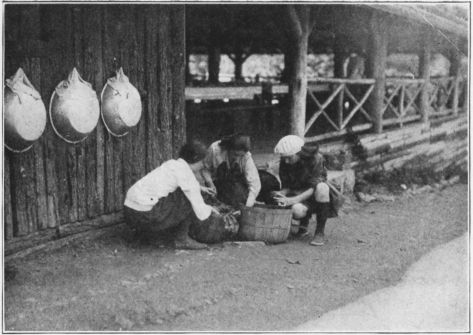 Sorting the Vegetables
Sorting the Vegetables
A small group of Scouts can make ready their own camp in many cases, but it does not seem feasible for a large group to do so.
Because in camp we live in the open, and away from the conventional surroundings of city life, is no reason why we should feel that anything is good enough, as concerns the table and the serving of meals. The way the table is set, the food brought to it, served, dishes removed, washed and wiped, does make a difference to everyone of us whether we are conscious of it or not. Certain work has to be done and it is far better to do it in an efficient way and in a way which will help us, than it is to do it in an[44] easy way, and perhaps get into very bad habits. It makes no difference of what material dishes are made, or what the tablecloth is, there is no excuse for not having everything clean and orderly and attractive in its very simplicity. The camp table should be as well set and according to the same rules, in as far as possible, as those a Second Class Scout follows in her test. Those who act as waitresses should do so with as much care and understanding of the right way to do the work as do those Scouts who work for the Hostess Badge.
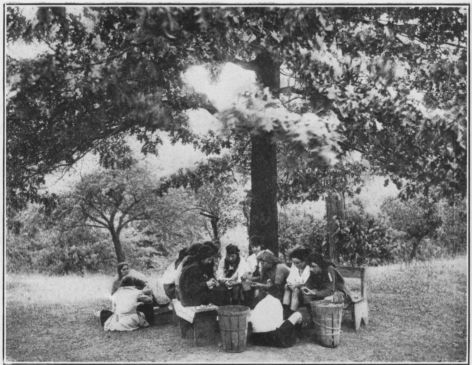 Team Work in Potato Paring
Team Work in Potato Paring
Dishes should be washed and wiped and dish towels washed according to the rules laid down by the best authorities. (p. 61.)
A good housewife throws away nothing that can be utilized. Therefore, what is left in the serving dishes after a meal is over should be taken to the kitchen, all of one kind[45] put into a dish and kept for future use. If quantities are well gauged and each Scout eats all that she takes on her plates, there should be very little waste from the table.
There are two ways of clearing a table, washing the dishes, and so forth, which are used in camps. One is considered easier than the other because it divides the work among the entire group, but there is a question as to whether it is as sanitary a way as the other, or as helpful to the Scout. It is the method of having eight campers scrape their dishes, stack them, fall in line, dishes in hand, and in succession wash, rinse and wipe them in pans and with towels common to that one group. As can readily be seen this methods breaks the rules being taught to Scouts as to the proper way of washing dishes: namely, to wash glass, first, silver next, change the water and wash saucers, cups, plates and so forth. No mother would think of having each member of the family stack her dishes, take them to the sink, wash and wipe them and put them away. This method would be considered most inefficient and confusing.
A better way is to have two girls from every table of sixteen, responsible for the dining room work, this work to be done under supervision and according to the most approved standards. Of course, this work is relayed so that each girl has a chance to learn it.
There are many young women with homes of their own whose houses are badly run because they have no idea how the daily housework should be done. They cannot do it themselves and they cannot direct another. The camp is the one place where the Scout can learn what to do and how to do it, and use for the benefit of a large group the training which she receives. There is not a mother who is not anxious to have her child know how to do these homely tasks in the right way.[46]
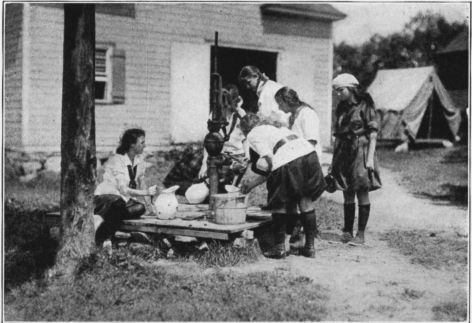 The Town Pump
The Town Pump
With a counsellor presiding at each table to help in serving and maintaining order, there is no reason why each girl should not learn if she has not already done so, the simple table manners which add so much to her attractiveness. People are not born with good table manners; they acquire them by being taught and by watching others, and sometimes a good appetite and being hungry makes them unmindful of others and of what they do, even if they have been taught. There is no desire on the part of any Director to make of her camp a finishing school, but she should be filled with a keen desire to make the most of every opportunity to give what will be of help to the girls as Scouts and as women. The time spent at the table can be most profitably filled by guiding the conversation into interesting channels and by being merry, while eating.
The Mess Hall should always be kept swept, either a fire burning, or a fire laid on the hearth if there is one,[47] fresh flowers on the tables. If the room is used also as a recreation room it may be possible to have a writing table with writing materials on it for the benefit of all campers.
As the camp days begin to draw to a close prepare for that last day when every bit of equipment must be packed away, every nook and corner left clean and the last camper silently steals away.
Use what provisions are on hand, buy only what is needed from day to day. Begin to pack and clear out wherever possible, but do not let this work interfere with the program which should be continued to within a day or two of closing, or the giving of a last grand party, a fancy dress or masquerade affair with "eats," as campers would say.
The Scouts can be most helpful after their personal equipment is packed and out of the tents. They can assemble blankets, pillows and basins, sweep tent floors, collect and burn all trash, leaving the grounds clean. When all is ready for their departure let Assembly sound and with every Scout in line on the field, have the colors lowered. Then come goodbyes and general leave-takings.
It is well for the Director personally to inspect the Scouts before they leave camp, that she may know in a general way their condition. This can be done after they assemble and before the flag is lowered.
If arrangements are made with the counsellors to remain for a few days after the Scouts leave, all working part of the time and playing some of the time, camp can be closed without much difficulty.
Tents must be taken down, folded and numbered to correspond with tent pole and ridge pole numbers. No[48] tent should be folded till dry, as it is sure to mildew if put away damp.
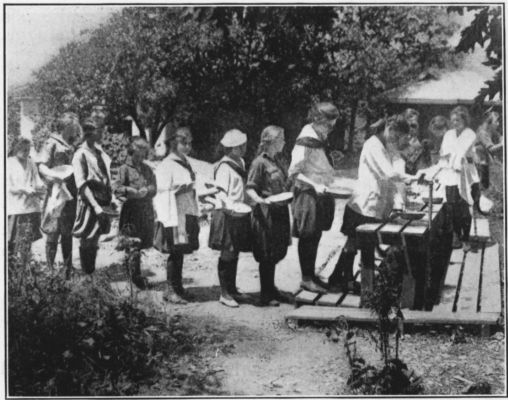 Scrubbing Up Before Meals
Scrubbing Up Before Meals
Blankets must be carefully inspected, shaken, brushed and allowed to hang in the sun all day before folding evenly, counting and packing for the winter. If there are any signs of soil they should be cleansed before storing. If boxed or laid on shelves or benches and covered snugly they can be kept in perfect condition.
Pillows should be treated in the same way as blankets as regards care and storage.
Lanterns should be emptied and cleaned. All dishes should be washed, wiped, counted, packed in barrels. All kitchen ware should be treated in the same way.
Any provisions left—there should be practically none—can[49] be disposed of by selling or giving away. Amount and kind will determine that question.
The kitchen stove must be cleaned and if it is to remain in camp should be covered with grease and boarded up unless it is to be used during the winter by campers. Store all equipment in a dry, light room and do not fail to have it insured.
The Director should be the last one to leave camp. She should make a round of inspection and be sure all is well before closing the camp doors for the long winter months.
Not only is the keeping of camp records a necessity, but certain records are of great value in planning future camps. Also personal records are of value during the winter to Local Councils and Directors, and in some cases to the National Headquarters.
Every Scout entering camp should have a record tag similar to the one shown in Cut B, which when filled out is kept on file during her stay in camp, and transferred to another file the day she leaves camp. Her height and weight should be taken in camp the day of or the day after her arrival, and if possible when she is in her bathing suit. Similar measurements should be taken the day she leaves camp. A personal record of all tests passed may be kept on the back of the card. It would be of interest to parents and of value to the Director when making out a camp report.
A tent record in convenient form is absolutely necessary. Scouts entering camp in large groups on a given date must be placed with as little delay as possible. Those approximately of one age should be in the same tents. Also friends like to be together. To know at a glance what cots are Vacant in any one tent is of help. Also at a glance the length of time a child has been in camp can be told, the date of coming and going being recorded. The accompanying Cut C shows a system which has served its good uses in more than one camp. Perhaps it will be of service to others. A sheet of fairly heavy paper for each tent record can be used, and all sheets put in a cover and held in place by clips. The dates of the month when groups can enter camp are placed at the left. Every square means a[51] week. Ditto marks mean "remaining in camp," and X means leaving camp and signifies an empty cot. At a glance three cots are seen to be vacant on August 6th, and when new Scouts arrive, as they should after the outgoing group has gone, it is not difficult for the Director to place them.
The following must be filled out by a physician within three days of the time the girl enters camp. It should preferably be done by someone who has known her for some time. The object of this certificate is: (1) to safeguard child and others against contagious diseases; (2) to make a basis for judging the suitability of camp life for her, and make possible any necessary precautions, particularly in regard to exercise.
As a general summing-up of recommendations in regard to whole
condition outlined above, I recommend the following:
Another record of great importance and interest is the Health Certificate shown on page 52, which should be kept on file in camp and later in the office of the Local Council for a period of three months, and then forwarded to the National Headquarters, Girl Scouts, Education Department, for use in compiling a Scout Health record. If during a Scout's stay in camp she is ill, meets with an[53] accident or needs the attention of a nurse in any way, the date, a note stating the trouble, and what was done for the child, as well as her height and weight at entrance and leaving, can be entered on the back of the certificate. The form shown was made by the Education Department of National Headquarters of Girl Scouts, and it is expected that it will be on sale and available for use by all Local Councils.
The petty cash record is an important department of record keeping. A day book, balanced each day, should be carefully kept noting all income and expenditures, and if much money passes through the cash box the Director should have a petty cash bank account in order properly to care for it.
The canteen record is perhaps the most difficult as it is a combination of a wholesale and a retail transaction and more or less involved in the general house expenses. Not only should a record be kept of all goods purchased at wholesale, as to quantity and price and when bill is paid, but a record of daily sales is absolutely necessary. Canteen cash at the end of each day should be handed over to the Director and entered in the petty cash book.
The accompanying Cut D is a suggested form for keeping the canteen accounts.
| Date | APPLES | CHOCOLATE BARS | Day Total | Rec'd | Short | Over | |||||||||
| Rec'd | Ret'd | Sold | Price | Total | Rec'd | Ret'd | Sold | Price | Total | ||||||
| July | 6 | 50 | 30 | 20 | $0.05 | $1.00 | 30 | 10 | 20 | $0.07 | $1.40 | $2.40 | $2.28 | $0.12 | |
| 7 | 40 | 20 | 20 | .05 | 1.00 | 20 | 0 | 20 | .07 | 1.40 | 2.40 | 2.45 | $0.05 | ||
| 8 | 60 | 20 | 40 | .04 | 1.60 | 40 | 5 | 35 | .07 | 2.45 | 4.05 | 4.05 | |||
| 9 | 50 | 25 | 25 | .05 | 1.25 | 30 | 10 | 20 | .07 | 1.40 | 2.65 | 2.72 | $0.07 | ||
| 10 | 40 | 10 | 30 | .05 | 1.50 | 20 | 0 | 20 | .07 | 1.40 | 2.90 | 2.90 | |||
| 11 | 30 | 0 | 30 | .05 | 1.50 | 20 | 0 | 20 | .07 | 1.40 | 2.90 | 2.90 | |||
| Wkly. Total. | 270 | 105 | 165 | $7.85 | 160 | 25 | 135 | $9.45 | $17.30 | $17.30 | |||||
| Received in July | Paid in July | ||||||||||||||||||||
| Date July |
3 5 |
3 bbls. Apples @ $5.00 2 boxes Oranges @ $3.00 1 case Tomatoes 4 boxes Chocolate Bars @ $1.20 |
$15.00 6.00 2.50 4.80 |
|
$15.00 6.00 2.50 4.80 |
Notes Try Russets next Indian Brand Too small | |||||||||||||||
| Monthly Total | $28.30 | $28.30 | |||||||||||||||||||
A very careful record must be kept of all provisions ordered, and when the goods are delivered the lists should be checked. No bills for food should be paid that have[55] not been viséed by the Director. A record of all equipment and notes as to the condition it is in should be made at the close of each camp season.
Where there are materials furnished for any camp activities such as raffia and reed for basketry there should be a separate record kept for this department. Many times the Scouts who make baskets are anxious to buy them and by charging a small price beyond cost the department can pay for itself and possibly show a small profit.
A general day book, sometimes called the Camp Log, is not only of interest at the end of the season, but if a few comments are added to facts the book may be of real value another year. It is always a good plan to make a note of any occasion which particularly pleases, or is of special benefit, for these notes are of service particularly when circumstances do not seem the brightest. Many times a suggestion is all that is necessary to turn the tide of the whole day. Such a book is of help in writing a report.
It is sometimes interesting for the children to keep a record of the different kinds of wild flowers found and the birds seen in the vicinity of the camp.
Field day programs and records are also of interest.
Another record is of hikes taken by campers during the summer. The route, the time of starting, the hour of returning, the number of girls who took the hike and any special point of interest noticed on the way, may be recorded.
The keeping of the Scout's application, deposit, board and transportation record plus the responsibility of so planning that there is never a vacant cot in camp is a matter which takes a great deal of time at best, but which can[57] be more easily done if a good system is used. The records are generally kept in the office of the Local Council under whose direction the camp is opened and run. Application blanks, (Cut E) should be filed according to date of entering camp and kept on file under the heading "In Camp," as long as the Scout is there, then transferred to the "Left Camp" file and kept for reference.
Ten days prior to the date of entering camp a follow-up notice should be sent to each Scout who should report to the local office, pay for transportation, receive tickets for same, pay for first week's board and receive a receipt for same.
The identification tag which must be taken to camp and given to the Director upon arrival should be filled in and given to the Scout, when she leaves.
In addition to the individual account card (Cut F.) record, all money received for deposits, transportation or board should be entered in a camp day book and deposited under camp account.
Any donations received for camp may also be entered in this book and deposited as "Donations."
| Name................................................................................... Address.............................................................................. | ||||||||||||||||||||
| Filed Application, Paid Deposit Enters Camp Leaves Camp Paid for Transportation Paid for first week's board Paid for second week's board Paid for third week's board |
Money Order 1.00 5.00 6.00 | Check 6.00 |
Cash 2.00 | ||||||||||||||||
The Local Office should notify the camp Director at[58] least two days before sending Scouts into camp, as to the number and the names of Scouts who will report to her, and thus give the Director time, if space allows, to arrange for any girl or girls who may desire to remain in camp for an additional week.
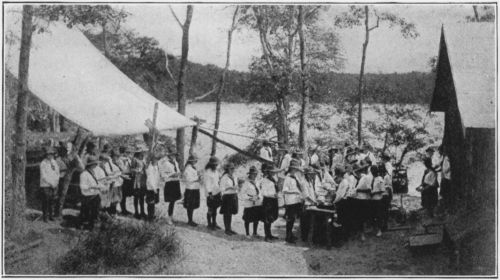 The Bread Line
The Bread Line
The Director in turn must send to the Local Office a list of all Scouts leaving camp that any unexpected vacancies may be filled from the waiting list and accounts adjusted.
Every camp should be run on a budget; that is, according to a plan of expenditure made on the best information available. Even if circumstances alter the original plan, as they are apt to do, each dollar whose expenditure is planned for will be found to bring in considerably more return than the casually disbursed one.
The following items to be considered in any camp budget are given in order of their numerical importance:
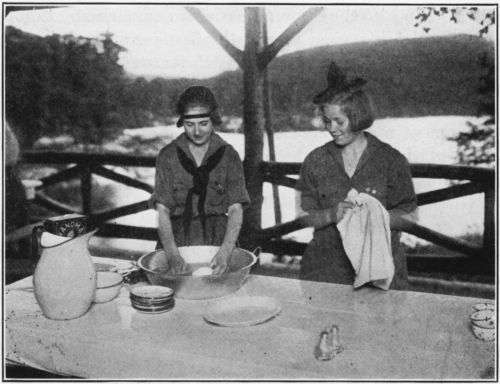 Race Between Washer and Dryer
Race Between Washer and Dryer
The actual cost of a large camp near New York is computed in Cut G, all figures being given in round numbers and based on three years' successful running. Absolute numbers mean little when considering conditions throughout the country, particularly in this age of rapidly shifting and climbing prices. Therefore, the figures are also expressed in terms of the distribution of one thousand dollars, during the first and also the following years.
It will be noted that food is always the most expensive[62] item. It is also the common basis for comparison. Equipment which is second in cost the first year, drops to fifth place in the following years. With reasonable care equipment should last seven years, upkeep and renewal taking one-seventh each year. With exceptional care the life of equipment may of course be extended and one of the important things to be learned at camp is thrift and consideration for the common property.
Girl Scout camps should aim at becoming self-supporting or even sources of revenue as soon as possible. It is good policy to charge a rate of board that will cover all costs, and then to raise money by Scout rallies and entertainments to provide for individuals unable to meet the full rate. Councils might well offer "scholarships" in the form of two weeks' camping expenses. Money for original equipment should be borrowed and paid back at interest in yearly sums.
In the camp whose budget is shown a board rate of $6.00 would more than cover expenses after the first year as with 134 Scouts paying for ten weeks it would yield an income of $8,040. At this rate the initial expense could only be paid off in about five years.
A board rate of $7.00 would not only cover current expenses, but would serve to pay off original cost of equipment in two years' time. Thus, 134 Scouts paying $7.00 a week for 10 weeks would make an income of $9,380 a season. This would leave a deficit the first year of $620. The second year with the current expenses $7,600 plus the deficit of $620 the total would be $8,220. The income of $9,380 would therefore give a balance of $1,160 at the end of the second year.
This does not include any of the income to be legitimately expected from the canteen, telephone charges, or special rates charged to guests, or from funds raised by entertainments.[63] Taking these things into consideration the board rate might be considerably reduced.
The balance that should accrue at the end of the second year might be used for reducing rates or extending time to individuals, or for paying instructors for extra service, or perhaps best of all to start new camps.
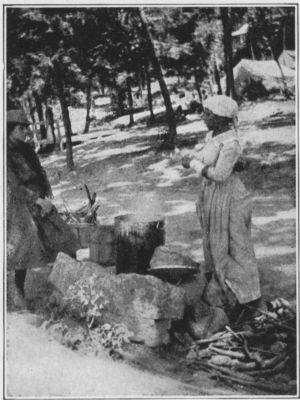 The Sunday Dinner. A serious and weighty undertaking. Sixty pounds of beef ready for the pot.
The Sunday Dinner. A serious and weighty undertaking. Sixty pounds of beef ready for the pot.
In organizing a permanent camp the following things must be supplied: beds, bed coverings, pillows, pillow cases, wash basins, lanterns, trash boxes, tables, benches, scales, dishes for mess hall and kitchen, table flatware, kitchen utensils, stove, household implements, camp implements, game equipment, incinerator, boats, a flag, and ropes for halyards.
A bed of some description is necessary to every camper. It is foolish not to have it dry, warm and comfortable. The most durable and economical are the canvas and wood cots which can be folded and packed into a small space during the winter. One is the government standard folding army cot, the other the telescope cot. Still another is the camp made cot fashioned of posts and strips of wood, with rope interlaced between the strips, and a sack filled with clean dry hay for a mattress. Spring cots and mattresses can be used but require a great deal of storage space during the winter and for many other reasons are not practical. An old sheet, a piece of heavy cotton cloth or bed ticking made into a bag and filled with hay can be used as a mattress on top of a canvas cot and makes a very warm comfortable bed, especially for cold nights.
Woolen blankets are the only covering to be considered for camp use, as they absorb less moisture than any other material, and even if damp are warm. They should be[65] long enough to cover the cot and turn under at the bottom, and wide enough when doubled to fall over the edge of the cot for a few inches. Those measuring 66 x 84 inches, weighing from 4 to 5 pounds, and being 70 to 90 per cent wool, are recommended. If only one blanket for each cot is provided in the general equipment each child should bring to camp either a sleeping bag, one heavy and one lightweight blanket, or one blanket and a heavy bath robe.
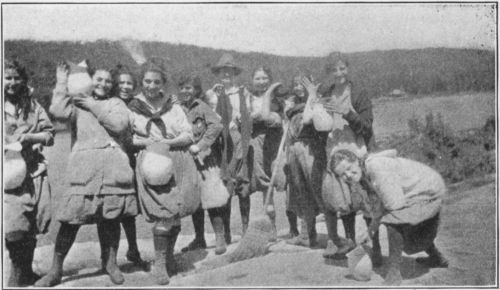 Cleaning Squad
Cleaning Squad
Great care should be taken that the blankets are kept clean. This can be done if the rule permitting no eatables, water or ink in the tents is adhered to. When making the camp bed whatever the method, care should be taken that blankets do not touch the floor. One way is to fold the camp blanket lengthwise, lay it on top of the cot, the top nine inches from the head of the cot. Open the blanket and lay into it the camper's folded blanket, the top of which comes to the head of the cot. Draw the camp blanket over it, fold both under at the foot, and turn in the[66] open side half of the length of the cot. If a pillow is used place it between the folds of the inner blanket. A bed made in this way will keep the camp blanket clean and it will be in proper condition either to use another summer or to use the same summer by another child.
Another way is to fold the camp blanket lengthwise and place it on the cot and fold the camper's blanket lengthwise placing the two openings in opposite directions, one blanket inside of the other.
Still another way is to fold the blanket lengthwise in thirds and lay it on the cot, turn it under at the foot and get into it as into a sleeping bag.
Quilts are not advised for camp use. All blankets should be shaken every day and thoroughly shaken and sunned at least two or three times a week. For this purpose it is recommended that long bars be erected in a sunny spot on the camp grounds where blankets can be thrown over them during a part of the day. If the camp is divided into sections a few blankets could be done at one time, and done regularly. The tent posts can be used if care is taken that the ropes are not loosened. Low brush or an available fence will also serve the purpose.
It is well to remember that it is more essential to have plenty of clothing under the body than over it if one would sleep comfortably. A wrapper worn over the night gown will keep the body warmer on a cold night than an extra blanket on top.
The camp blankets should never be used next to the body. The personal blanket should be used for that purpose. During the day the camp blanket can be folded lengthwise once, crosswise once, laid on to the foot of the cot, the fold toward the bottom, the personal blankets, night clothes, bath wrapper and pillow neatly folded, laid on the blanket and the border ends drawn over and[67] tucked under, thus making a neat roll. The foot of the cot is toward the center of the tent.
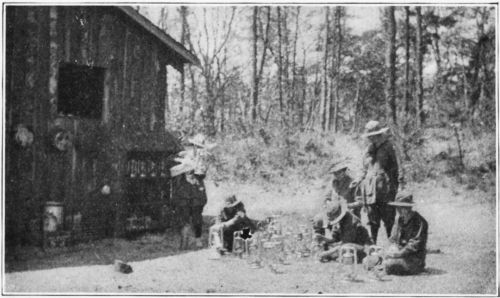 The Wise Virgins. They clean and fill their lamps outdoors.
The Wise Virgins. They clean and fill their lamps outdoors.
The best pillows for camp use are those filled with kapok which is impervious to germs, light, and possesses a cork-like quality which in case of necessity can be utilized by making a life preserver of the pillow.
Every child should be provided with a small agate or enamel hand basin in which she can keep her toilet articles when not in use. The basin can be kept under the head of the cot and is one of the things to be thoroughly inspected each day.
Each camper should have a dinner plate, a bowl, a cup and saucer of either white enamel ware, which is the best,[68] crockery, which is not recommended, aluminum, or if these are too expensive, tin. There should be serving dishes such as one platter and three serving bowls for each table, extra plates for bread, sugar bowl, butter dishes, large and small pitchers, salt cellars; and do not forget the vase for flowers.
The table flat ware should consist of a fork, knife, a large and small spoon for each child, knives for butter, serving spoons and extra serving forks. Nickel, re-tinned, or tin-plated steel gives excellent service.
In so far as is possible use no tin in the kitchen. Use agate, aluminum, porcelain or iron. When necessary to have very large boilers buy those made of re-tinned steel with copper bottoms. For a camp of fifty or more the following equipment is necessary: two large boilers, two feet high and from twelve to fourteen inches in diameter, with handles and with closely fitted covers; one large open boiler with a bail; three agate boilers with bails, holding from twelve to fifteen quarts; two smaller boilers and one sauce pan holding three quarts; four, three quart pails with covers; one large and one small tea kettle; one colander, two sieves (one with a handle and one large one without a handle); three or four iron pans, the largest size that will fit into the oven; one quart measure, one pint measure, one measuring cup; three large mixing bowls, four milk pans, four milk bowls, and dishes in which left-overs can be kept; one bread board, rolling pin, toaster, two iron pot rests, two frying pans, a tea pot, a long-handled dipper, a long-handled skimmer, six spoons with handles of different lengths, a bread knife, a meat knife, a cleaver, a dozen vegetable knives, two can openers, one large serving tray for each table, three dish[69] pans, a bread cutter, a flour sieve, a sugar scoop, an apple corer, scales, a meat grinder, and an ice cream freezer.
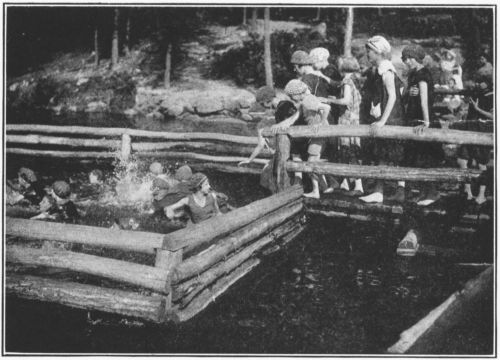 The Swimming Crib
The Swimming Crib
General camp implements are needed as follows: two flat irons, brooms for the mess hall and kitchen, and small brooms for tent use, dust pan and brush, stove brush, four galvanized pails, a garbage pail not too large, a hammer, hatchet, axe, a wheel barrow, saw, fork, spade, shovel, rakes, trowel, screw driver, a pair of pliers and nails and screws.
The kitchen will have to have a good stove large enough to hold two or three large boilers at one time. If there is plumbing and a hot water boiler, either the stove can be[70] furnished with a hot water back, which is not desirable, for the fire need not be kept all day when wood is used, but hot water is needed at all times, or a Standard Oil kerosene heater can be installed. Without plumbing, a stove with a hot water tank is desirable. If this is impossible a large boiler must be kept filled with water on the top of the stove.
An army range, set on a concrete base, gives the greatest satisfaction in a large camp. The ovens are large, an important point, and the top of the stove large enough to care for all necessary pots and kettles. When buying a stove for camp use make sure that it is made for the kind of fuel which will be used in it.
The kitchen sink should be conveniently placed and large enough to hold a large dish pan. Again if there is no plumbing a long table for dish pans, draining pans, etc., should be provided.
Other tables, benches, shelves and a wood box are necessary.
Tables and benches are necessary in every camp. The more simple they are the better. Tables made of pine boards, and tops covered with white oil cloth are very serviceable, or better, tables with planed tops can be used. Table tops and rests are feasible also. Benches can be made in various ways but should be firm and of the right height. Chairs are not really a camp necessity and on the whole could well be left out of the list of camp furniture.
Every camp, large or small, needs lanterns. Lamps are not advised as a general rule. There should be enough to have sufficient light in the mess hall, in the kitchen, at least one in the wash house, one at each latrine, and for stormy and very dark nights one for every two tents, or[71] group of tents. The tent lanterns can be hung on the tent posts outside of the tents which method will prevent mosquitoes from being attracted inside. Latrine lights should burn all night and it is advisable to leave one burning by the mess hall in case of emergency. Never allow children to bring candles into camp. Flash lights are a convenience and harmless.
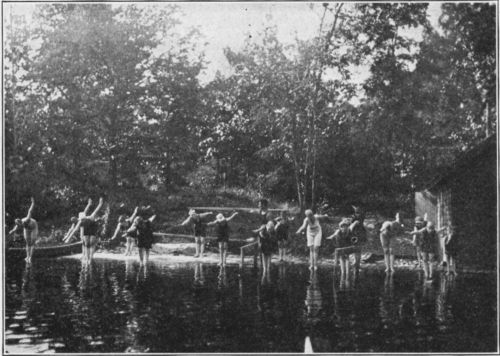 Land Drill
Land Drill
A lantern which is not clean and shining and ready for use is a disgrace to any camp. Every morning chimneys should be washed and wiped, lanterns filled, wiped clean, wicks wiped off with a piece of newspaper and turned down. They do not need to be trimmed every day. Have a place for the lanterns to hang or stand during the day. The lamp cloths should be washed, dried in the sun and hung where they will not be caught up and used for other purposes.[72]
A very good double boiler can be made by using a large outer boiler in the bottom of which is placed a pot rest and a small amount of water. Stand on the rest either one kettle well covered, or if necessary, two kettles, one on top of the other, both tightly covered and the outer boiler tightly covered. This arrangement forms a kind of fire-less cooker which is exceedingly satisfactory, especially for cooking cereals.
Each tent or group of tents should have a conveniently placed trash box. These can be made of wooden frames covered with screening, can be small half-barrels or kegs, painted, or small portable incinerators. These boxes should be emptied every twenty-four hours and the contents burned.
Another piece of furniture is a pair of personal scales, for the weight of each child entering and leaving camp is of interest and value. Do not use form with springs.
The game equipment must not be forgotten. Basket balls, volley balls, water polo balls, baseballs and bats, quoits, bows and arrows, and tennis sets are all valuable.
If in the general equipment pillows are provided it is well to have a few pillow cases other than those which the child brings to camp. There should be sheets and pillow cases for use in the bed making test. Three sets of dish towels and a set of dish cloths, holders, stove cloths and[73] kitchen hand towels. Cheese cloth is of great value in camp in the kitchen and out of it.
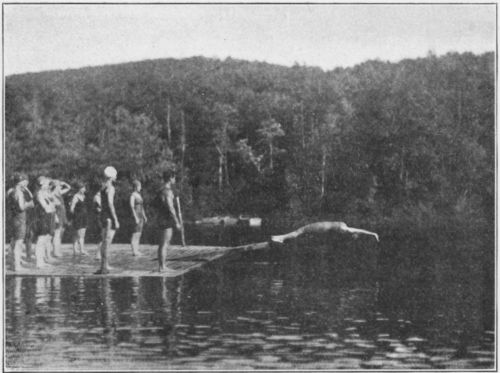 The Diving Lesson
The Diving Lesson
Do not throw away any clean whole newspapers; they are of too great value. Wet shoes stuffed with pieces of newspaper and stood not too near a fire, will dry in good shape and be soft. The newspapers help to absorb the moisture out of the leather and keep the shoes in shape.
Newspapers can be used to sit upon if benches or ground are damp.
Nothing is better for cleaning the top of a stove after each meal, than a newspaper crunched into a wad.
Folded pieces of newspaper make an excellent holder for lifting pots and kettles. Several thicknesses placed on the end of the kitchen table on which to set pots and cans, will[74] keep the table clean. Hot water pipes or a boiler can be covered with several thicknesses of newspapers held in place by twine, thereby conserving heat. Cover the ice cream freezer with newspapers after the dasher is removed and while the cream is getting stiff. They help to keep in the cold. Newspapers laid on a cot under the blankets help very materially to keep one warm on a cold night. After sweeping a floor put the dust and dirt from a dust pan in a newspaper, roll it carefully and burn in the incinerator. The wind cannot then blow the dirt about.
When picking flowers do not pull the plants up by the root. Do not pick a blossom with too many buds on the stem. Do not pick what you are not going to use either as a decoration or to press for nature study work. Do not pick short stems, and do not crowd too many flowers into one vase. Be sure that the vase is clean and the water fresh. All dead flowers and leaves should be burned and not thrown out to disfigure the looks of the camp grounds.
If you do not know poison ivy when you see it get someone to point it out to you and then keep away from it. It is more apt to poison when the leaves are wet.
| Clothes: | Scout uniform and Scout hat
Bloomers: dark wool or khaki
Middy blouses, at least 3; plain, strong, white
Coat
Rubber coat or poncho
Sweater
Shoes (stout, low heels, round toes; two pairs if possible) [76]
Rubbers
Underwear: Plain and strong. The one-piece athletic garment made for women and girls is preferable to separate chemise or drawers. Woven shirt or union suit of cotton or light wool is desirable. No petticoats.
Stockings: at least four pairs, heavy ribbed cotton or wool preferred. No silk.
Nightgown or pajamas, three, heavy cotton or canton flannel.
Bath wrapper and slippers
Bathing suit and cap
|
| Bedding: | Plain woolen blankets, light-weight, for use next body Pillow cases, (three) |
| Toilet Accessories: | Bath and face towels, two each Face cloths, two Comb and brush Tooth brush in holder Soap and tooth paste Soap box Small cup Scissors Nail file or cleaner Sanitary napkins and belt |
| Desirable General Accessories: | Musical Instruments Flashlight Note book or pad and pencils Sewing kit |
There have been objections made to the camp canteen or store, but there seem to be no very good reasons against it. By buying large quantities and at wholesale[77] and selling at the market price in small quantities there can be a perfectly legitimate profit on a camp canteen. This helps to pay camp expenses. It is also possible to make an arrangement with local stores to supply merchandise, fruit and candy to be sold at the store price, and receive from the store a ten per cent discount which is clear profit to the camp. A greater profit, however, can be obtained if the camp purchases these things for itself from wholesale dealers.
The price of board in the average Scout camp is so low that it is impossible to supply campers with many of the things which they want and which they may have. Fresh fruit in some localities is very expensive and quite beyond the possibility of serving. But most parents make no objection to their children purchasing the fruit, one or two pieces at a time, at the canteen counter. The same is true of simple candy such as sweet chocolate, Hershey Bars, Neccos, etc. One piece a day is not only perfectly harmless; it is, in fact, beneficial.
Other things that can be sold in the canteen are stationery, stamps, plain postal cards, picture postal cards, hair pins, pins, shoe laces, needles and thread, kodak films, bathing caps, soap, and pencils.
The best time for having the canteen open is determined by the rule that Scouts do not eat between meals. For this reason it is better to sell fruit and candy either directly after dinner or directly after supper. For many reasons it is much more convenient and fully as well for the child to have the canteen open after supper, especially when that meal is served at half-past five.
The question as to whether Scouts should be allowed to receive packages of food from home is one which every camp Director has to decide. Probably nothing causes more unhappiness than the fact that some girls[78] receive no packages while others have many. The most serious phase is that boxes often contain food which is not best for the girl. Then, too, packages have been sent by parcel post so badly wrapped and packed that when received at the local post office the authorities have complained to the camp Director. The condition of fruit or other food was such as to be a menace.
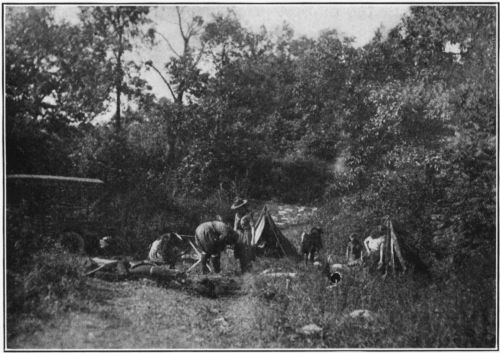 Making Camp on an Overnight Hike. Tents and other equipment come by trek cart.
Making Camp on an Overnight Hike. Tents and other equipment come by trek cart.
The problem of caring for the boxes of food which are sent to campers is sometimes a serious question. If labelled and put into the storeroom they take up valuable space; also much time is spent taking them out at canteen hour and in putting them away. If a child is allowed to keep food of any kind in her tent, it is quite impossible to have the blankets, cots, or pillows in absolutely perfect condition.[79]
All things considered, it seems best not to allow food including fruit or candy to be sent or brought into camp.
The average child who enters camp does not know how to swim and knows less about boating. What is more, it is probably the only place for many to learn to do these things. Taking a dip for the sake of having a good time, splashing in the water, and so forth, is one thing, but to really learn to swim, to dive, to throw a life line, to rescue, to resuscitate, is quite a different matter. These things must be learned, for as a matter of fact, human beings do none of them naturally.
When possible a crib for beginners is a very desirable thing to have. (p. 69.) Unless there is a safe beach or shallow water and a good bottom there is more or less danger attending the teaching of swimming to a group of children even though the group be small. With the crib, for use especially in deep lakes and ponds, this danger is practically overcome, and in consequence much anxiety on the part of those in charge of the camp eliminated. The child seems to fear less, therefore learns to swim sooner. A crib 20 x 85 feet is large enough for a group of twenty children (Cut H.) It is built partially on land by the water's edge, is made of logs and planks and pulled into the water over logs used as rollers. A floor is made of 6 inch planks placed half an inch apart and nailed on to a rectangular frame work of logs with lengthwise supports under the planks. Uprights of logs are placed at intervals along the sides and ends and at the corners. Two and a half feet from either end a second row of uprights is placed. The sides and inner ends are built up to a height of 5 feet, the outer ends to 3 feet. The crib is pulled into the water and towed to its position by a pier or wharf.[80] It is sunk with stones between the double ends until the floor is 3½ feet below the surface of the water at the pier end, and 4 feet below the surface at the other end. It is held in position by being fastened to piles placed at intervals around the edge. Steps lead down into the crib either from the end of a pier, or from a wharf. As soon as a child can swim three times around the crib without touching her foot to the bottom of the crib or her hands to the sides, and can demonstrate three strokes, she should be allowed to go into deep water, but should be carefully watched for a while.
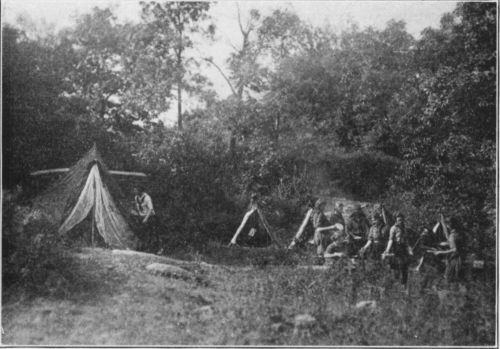 "Eats"
"Eats"
Land drill preceding the swimming lesson is very helpful. An expert person should be made responsible for not more than twenty girls at one time unless the girls are competent swimmers, and no one should be allowed to interfere with the rules and regulations laid down by the person in charge. Absolute obedience to all signals, rules[81] and regulations must be observed. An assistant counsellor should always be in attendance at swimming lessons.
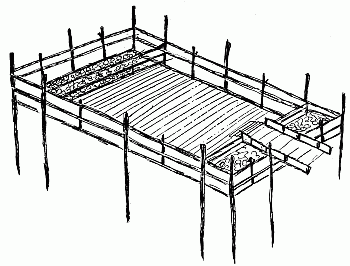 H. Swimming Crib as it would appear out of water. The crib is 35' by 20', outside dimensions, with end pockets for stones, 2½' each, leaving a swimming space of 30' by 20'. The idea for this was planned and executed by the Engineers of the Park Commission of the N.Y. and N.J. Interstate Park, for use in the camps in the Palisades Park.
H. Swimming Crib as it would appear out of water. The crib is 35' by 20', outside dimensions, with end pockets for stones, 2½' each, leaving a swimming space of 30' by 20'. The idea for this was planned and executed by the Engineers of the Park Commission of the N.Y. and N.J. Interstate Park, for use in the camps in the Palisades Park.
Deep water swimmers should be able to pass the following requirements: demonstrate three different strokes, breast, overarm and back stroke. Swim under water. Demonstrate resuscitation. Throw a life-line twenty-five feet for accuracy. Demonstrate diving, shallow, deep and fancy diving. Rescue a drowning person twenty-five feet away from a raft. Swim 50 yards with clothes on.
It is always advisable during a swimming period to have a boat well manned near at hand. Bathing in fresh water, especially in spring-fed lakes is not as exhilarating as salt water bathing, and twenty minutes is considered the[82] longest time a girl should stay in fresh water. Great care should be taken that no child is allowed to get chilled. At the first sign of pinchedness, shivering, or blue lips the child should be called out of the water, and instructed to rub herself briskly and dress at once.
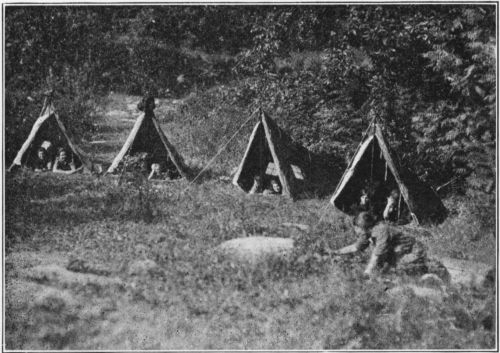 The Morning After
The Morning After
Bathers should always be counted immediately before going into the water, and immediately after being called out. It is well to have assembly and roll call for this.
A word as to bathing suits may not be amiss. Care should be taken that the shoulder straps are tight enough and the under arm seam sewed up high enough to keep the top part of the suit in place. It is recommended that camps adopt a uniform style of bathing suit and that all classified groups wear bathing caps of the same color, as for instance,[83] first class swimmers wear white caps, second class blue caps, third class green caps, and fourth class, red caps.
Probably there is more fun experienced by the Scouts who are privileged to use a raft or float, than by all the other campers put together. To get out of the crib group and go for the first time to the float is a thrilling experience and one that is much discussed and enjoyed. Water sports without a float cannot be imagined, neither can a camp really be called a Girl Scout camp unless it possesses this important piece of floating property, which may be large or small, but must be properly built to be safe. For a camp of 150 or more, a float 20 x 40 feet is none too large. It should be equipped with spring board, diving tower and life lines, and moored in deep water, not too long a swim from shore.
Bath houses are not always considered necessary to campers but the use of them does much toward keeping tents and tent equipment in good condition. Wet floors, cots, blankets and so forth are always a detriment and should not be allowed. If bath houses are impossible, erect a large tent with a clothes line running from pole to pole and low benches under it to serve as racks for clothing. Have pails at hand for holding rinsing water. This kind of bath house is easily arranged.
Where possible it is an excellent idea for girls to be able to take a quick dip before dressing for breakfast, but in a large camp this is not always possible, and other arrangements have to be made for the morning ablutions, as have been suggested in another part of this book.
Only first class swimmers should be allowed the use when alone, of boats of any kind. The flat bottomed[84] boats are the safest and it is almost impossible to tip them over. They are, however, much heavier and harder to manage than the round bottomed boats. Care should be taken that not too many girls go in one boat at one time and that whoever is put in charge of the group must be obeyed. Girls should be taught to row, how to enter a boat and leave it, how to tie it, how to seat passengers so that the boat will be well balanced, how to row alone, and how to keep stroke with another.
A list of firms handling approved equipment for camps will be furnished upon request to National Headquarters Girl Scouts, Inc.
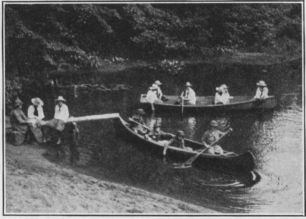 Setting Out for the water Hike
Setting Out for the water Hike
Every camp that is situated on water or has a near-by bathing place, should organize its water front protection system before the camp opens.
The swimming place should be so chosen as to combine, if possible, deep water swimming for the experienced swimmers and a shallow bathing place for beginners. The non-swimmers' pool should never be over four and one-half feet deep at its deepest point.
For Beginners. The non-swimmers' pool should be enclosed on three sides by life lines, (1" to 1½" manila rope, depending on weather conditions), buoyed up every fifteen feet by cork floats or balsa wood buoys, painted white and made fast at the corners to piles driven into the sand, or to buoys moored with rocks or cement moorings. No beginners should be allowed to go beyond these lines.
For Swimmers. The area to be used by Swimmers should then be plainly marked off with white floats moored to the bottom, with a flag placed at top. No swimmer, no matter how expert, should be allowed to go beyond these floats, unless permission is obtained from the Master of Aquatics.
Great care should be taken that all diving platforms[86] and spring boards are safely situated and that the water surrounding these diving arrangements is clear of all rocks, stumpage, etc., to the depth of at least 10 feet. Ladders should be placed at the float to allow swimmers to climb from the water easily.
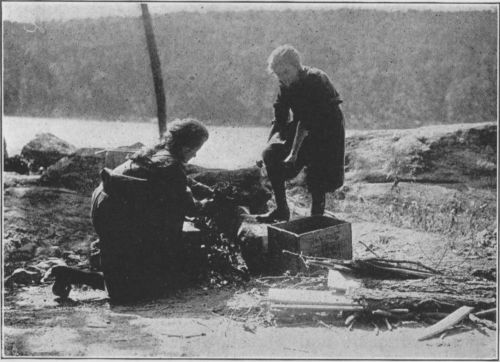 Laying the Fire
Laying the Fire
Tower. A small tower, eight to twelve feet high, should be erected on the shore so as to overlook the bathing place. A warning signal, such as a bell or gong, should be placed in the tower.
Life Boats. Two or more boats, depending on the size of the camp, should be set aside for life-saving patrol. These should be equipped with life lines looped around the outside of the gunwhale, ring rowlocks, and an air tank placed under the bow and stern seats. A hole should be cut in the top of the stern board for sculling.
Life boats should be chosen that are light and easy[87] to handle, and care should be used in picking boats that are sea-worthy and have good beam.
One life boat should always be at the dock, ready for instant use, while the other boat or boats are on patrol.
Under no circumstances should these boats be used for anything but life-saving duty.
Ring Buoys. Ring buoys should be placed on every dock. These should not be over nineteen inches in diameter, and should be equipped with sixty feet of ¼" line with a float or "lemon" on end. Ring buoys are valueless unless ready at all times for use, so should be mounted on a rack the shape of a cross, painted red, having a peg, 5" long, on the end of each arm, for the rope to be loosely coiled around. The top loop of the buoy hangs on the top peg. By this arrangement, the buoy is always ready for use.
Water glasses, first aid equipment, grappling irons, and extra boat equipment, such as oars, rowlocks, and boat hooks, should be kept on hand ready for instant use.
Row Boats and Canoes. All row boats should be placed in first class condition and tested out to find their safety capacity. The way to determine this is to fill the boat full of water and find out how many it will support in the water holding on to sides; this then is the safe number to carry in the boat when free from water. If boats are equipped with a small air-tight compartment of metal in bow and stern, it will increase their buoyancy to a great extent. Every boat should be plainly marked: THE CAPACITY OF THIS BOAT IS..., with white paint on both sides.
Choosing the Crew. Every camp should build up around its Master of Aquatics a Life Saving Corps from[88] among the campers. Choosing the personnel of the Corps is a very important matter. The applicants should understand that it is an honor to be a member of this unit.
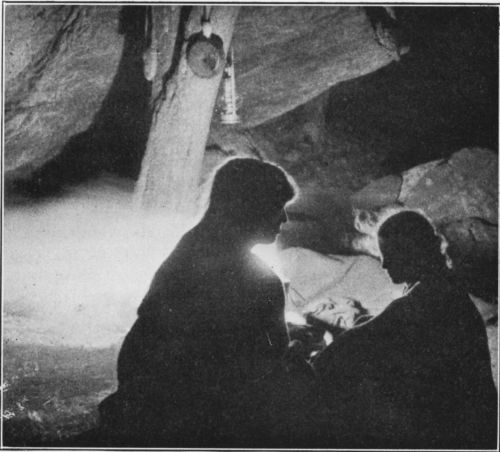 The Goodnight Story
The Goodnight Story
It will be found that if the members of the Corps are allowed to have separate sleeping quarters, near the water, over which they fly the Red Cross Life Saving Corps flag, mess together and be relieved of K. P. duty, that they will develop an esprit de corps which will make for efficiency in their work and be of great value to the general morale of the camp.
Everyone trying for membership should first have a[89] medical examination to prove that he is physically able to stand the very difficult work which he may have to perform at any time. The group of applicants should then be tested out as to their swimming ability, especially being required to swim on back without hands, and on side with one arm only.
Training. After your applicants have been culled out, the ones that you decide to use should be given a thorough course of training, first being obliged to pass the Red Cross life saving test. They must be instructed in boat handling and the methods of taking another person into the boat, in the proper method of throwing the life buoy, using a 60-foot line and a 19-inch buoy. They should be capable of tying knots needed in their work, such as a square knot, clove hitch, two half hitches, bowline, short splice and eye splice. Much emphasis should be placed on instruction in resuscitation by the Schaefer method, and no attempt should be made to instruct them in the use of any mechanical respiratory devices as they are practically useless.
During the camp season, if possible, members should have thorough instruction in first aid, especially as it applies to water accidents, the most common of which are abrasions, sun burn, seasickness, broken arms from backfire of gasoline engines, sickness from gasoline fumes of motor boat engines, and submersion.
Duties of Crew. The Life Saving Corps should be familiar with the water at all points and should buoy any especially dangerous spots, such as submerged tree stumps or very deep holes. This can be done with a line, anchor, and float painted red.
The Life Saving Corps should be in charge of Mates under the command of the Master of Aquatics who is the Captain. A log of each day's work should be kept,[90] recording such events as concern the Corps, such as weather report, officer in charge of day's watch, number of swimmers, name of day's swimming instructor, number taught to swim, etc. Watches should be so arranged that members of crew are not on duty more than two days out of three.
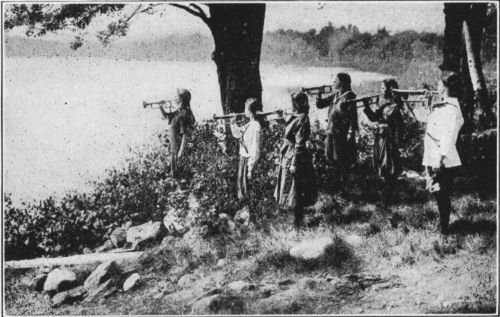 "Good Morrow, Lord Sun!"
"Good Morrow, Lord Sun!"
During the bathing periods, which should be at least two hours after meals, the Corps members will be in charge of the protection and discipline of bathers, the instruction of swimming, and supervision of diving.
The following is suggested as a good distribution. Two in each life boat, oarsman and coxswain, one person on the dock, two lookouts and messenger in the tower, one at diving board and one or two instructing swimming (change instructors every third day).
The Swimming Test. After every camper has had a medical examination he should have a test in swimming and be graded in one of three classes: Non-Swimmer,[91] red knot on right shoulder; Beginner—the ones that will still bear watching—white knot on right shoulder; Swimmer, American Red Cross Junior Life Saving Corps emblem.
Check your list up every once in a while to see that everybody is in the right class. Hold frequent tests to re-classify two lower grades. The graded Red Cross tests are recommended and arrangements can be made for Red Cross awards.
A Non-Swimmer should never be allowed to take out a boat unless accompanied by a swimmer. The Beginners should be limited in the distance they can go and only the Swimmers should be allowed to go where they please. At least two-thirds of every boat load should be able to swim and take care of those who cannot swim.
Under no circumstances allow more than one boat to be towed behind a motor or sail boat, and then only if boat being towed is in hands of an expert coxswain.
No boating should be allowed during bathing periods.
Detail one of the crew to give instructions in boat handling if necessary.
Have all boats in by "Mess gear" unless special permission is given.
No boating after dark without special permission.
Every camper should know how to tie up a boat, if he wishes to use them. See that he does it.
A simple set of rules may be drawn up and posted in prominent places so that every camper will know exactly what the bathing regulations are. The following are a few suggestions. No one is allowed to swim for at least two hours after meals. No swimming allowed in the heat of the day. No one is allowed to swim if he has[92] any stomach disorder. A limit set on number allowed in boats. No boats loaded with campers allowed to be towed behind motor boats. Absolutely no swimming to be permitted unless life boat is on hand for protection of bathers.
Of course these rules may be modified to suit each camp's local problems, but if these suggestions are adhered to in the main, it will be almost impossible for any accidents to happen.
One accidental drowning case may ruin the reputation of a camp. Build up the confidence of your campers and their families by making your safety system as near foolproof as possible.
Send every camper home a swimmer; and, if possible, able to swim for two.
For information about life saving, write American Red Cross Life Saving Corps, 44 East 23rd St., New York City.
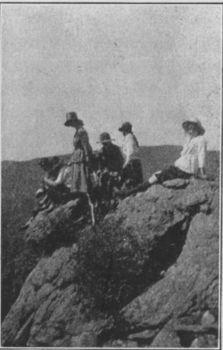 Monarchs of all they Survey
Monarchs of all they Survey
The program is one of the most important factors in the well-organized camp and must be given much thought. It is the thing which gives continuity to the summer's work and holds the entire group together. Without it there would be disorder and confusion.
While including as many activities as possible without causing any feeling of hurry, rush or forcing, it must be planned so that repetition will not prove monotonous. It should provide for periods of work and play, rest and leisure; it must afford ample opportunity for self-expression and development. Parts of the program must necessarily be obligatory for all, others optional, still others optional as to time only.
The fact that the group is composed of Scouts and is living out of doors should bring to the fore, subjects for study which are particularly in keeping with the Scout program, such as nature lore, simple astronomy, woodcraft, campcraft, carpentry, gardening, hiking, map-making, swimming and boating; Scout grade test requirements, and some of the Merit Badge work. Specific directions for teaching these subjects are not given here, as they are covered in the Handbook, "Scouting for Girls," and other publications.
Periods for play may include games, group singing, rowing, hikes, entertainments, and so forth. Leisure moments are for the individual. She should be allowed to follow her own inclination so long as she does not infringe upon the rights of others or break the necessary camp rules which protect the safety and health of the group. Hours of rest which all observe at stated periods are, of course, most essential. While a daily program is[94] absolutely necessary as a basis of work, it should occasionally be put one side to allow the entire group to take advantage of particularly propitious weather conditions for walking and hiking, or for an entertainment or field day. The daily program in every Girl Scout camp should always include the formal ceremony of raising and lowering the flag, inspection, a period of rest directly after dinner, a period for the discussion of the Scout Promise and Laws, and a short period for Setting-up Exercises, preferably the first thing in the morning. On Sundays a simple Scout service should be held.
 A Sun Clock never runs down. Stake five feet high driven firmly in ground in open space. Peg is stuck in at end of shadow every hour during the day. From article in "Scouting", Dec. 15, 1917
A Sun Clock never runs down. Stake five feet high driven firmly in ground in open space. Peg is stuck in at end of shadow every hour during the day. From article in "Scouting", Dec. 15, 1917
A feature of the day's routine is the coming on duty of the housekeeping squad which for a period of twenty-four hours keeps the camp clean, orderly and safe, and[96] performs most if not all of the necessary household duties which must be done in every home or camp. The squad should be under the leadership of a counsellor who is particularly fitted to direct and instruct the squad and be responsible for the work it does.
Going on duty in the middle of the afternoon gives the members an opportunity to have a swim earlier in the day, and after going off duty the next day, which is a privilege not to be despised. The work which this squad does is for the benefit of the entire group and raises or lowers the camp standard each day.
The general program should be posted on the bulletin board and explained to each new group that enters camp. It should be given in detail as to hours, activities and requirements. Whether the program is planned for the group divided into two or three units or for the group as one unit, depends upon the size of the camp. No counsellor can do justice to her work if she has too large a group, and on the other hand, the group if too large will lose interest in the subject. The accompanying program has been tried and may be of value as a suggestion.
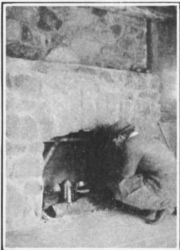 Fireplace in the House the Scouts Built
Fireplace in the House the Scouts Built
| Bugle | M. | Group I | Group II | Group III |
| 6.30 | 10 | Revielle | ||
| 6.40 | 10 | Setting-Up Exercises | ||
| 7.15 | 15 | Assembly and Morning Colors | ||
| 7.30 | 30 | Breakfast and Announcements | ||
| 8.30 | 30 | Inspection | ||
| 9.00 | 30 | Nature Lore | 2d Class Work | Games |
| 9.30 | 45 | Drilling, Games | Swimming | First Aid, Bed Making |
| 10.15 | 45 | Basketry | Health, First Aid | Swimming |
| 11.00 | 30 | Scout Laws | Basketry | Health |
| 11.30 | 30 | Health, Adv. First Aid | Scout Laws | Scout Laws |
| 12.00 | 30 | Free Time | ||
| 12.30 | 60 | Dinner | ||
| 1.30 | 60 | Rest Hour | ||
| 2.30 | 45 | Mail Distributed, and Free Time | ||
| 3.15 | 30 | 1st Class Work | Nature Lore | Knots and Signalling |
| 3.45 | 45 | Swimming | Games, Drilling | Nature Lore |
| 4.30 | 60 | Free Time | ||
| 5.30 | 30 | Assembly, Retreat, Supper | ||
| 6.00 | Canteen, Boating, Short Walks, Games, Dancing, Etc. | |||
| 7.30 | Camp Fire, Singing, Stunts, Etc., for the Whole Camp | |||
| 8.20 | First Call | |||
| 8.45 | Taps | |||
Every girl who goes to a camp in the summer is interested in some form of sport. But perhaps swimming and boating head the list for popularity.
There are many interesting ways in which to run your swimming program so that it is taught systematically and leads to real progress and efficiency.
One method that has been tried successfully in a very large camp, but which would apply equally well in any camp, is the arrangement of the entire camp into groups designated as "Swimming Classes" and indicated by a[100] special color bathing cap for each group or class so that they may be easily distinguished in the water.
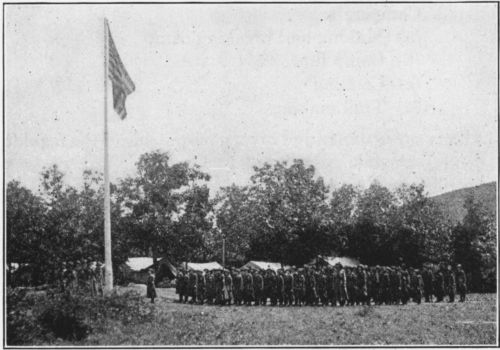 The Top of the Morning
The Top of the Morning
Class Number 4, Red Cap.—All who have not passed the canoe test which is explained under the heading "Class Number 3."
Class Number 3, Green Cap.—Pass the canoe test which consists of swimming, floating or otherwise staying above depth for fifteen minutes, and swimming in from an overturned canoe 20 yards from shore.
Class Number 2, Blue Cap.
| Strokes: | Breast stroke—25 yards |
| Side Stroke—25 yards | |
| Back stroke—25 yards | |
| Single overhand—25 yards | |
| Double overhand—25 yards | |
| Dives: | Standing or running dive from spring board (3 perfect out of 5). |
| Dive from a low tower 4 feet high. (3 perfect out of 5).[101] |
Class Number 1, White Cap.
| Strokes: | Crawl |
| Trudgeon | |
| Dives: | From spring board, running plain |
| From spring board, running jack knife | |
| From spring board, running angel | |
| From spring board, standing side | |
| From spring board, standing back | |
| From float standing from high tower (10) and | |
| 3 optional dives from the following: | |
| Hand stand (spring board, high or low tower). | |
| Back somersault, spring board | |
| Front somersault, spring board | |
| Sailor running, spring board | |
| Back dive, high tower | |
| Jack knife, high tower | |
| Double dive, high tower |
Another method is to record the swimming achievements on a chart under the following headings:
Form swimming, ornamental swimming, speed swimming, canoe tests, life saving and dives.
Did you ever work to become a member of the Women's Life Saving Corps of the American Red Cross? The purpose of this organization is to train women in all coast cities, and cities bordering on lakes and rivers, to be able to meet emergencies in the water and save lives.
There are six tests which have to be passed before a girl is considered worthy of a W. L. S. C. certificate.
Boating, of which we shall first consider rowing, may also be worked out according to classes, such as:
In your own camp when grouping sports for classification although you may get good suggestions from other methods, it is best to work out a way which meets your own particular need.
Remember that the swimming and boating should be in charge of competent and responsible people or instructors and that every precaution should be taken against accident.
Remember it is better to emphasize good form rather than speed or long distance swimming and the ability to meet emergencies in the water rather than stunts.
Honors or recognition should be given for skill, form and improvement rather than for endurance.
The interest in Water Sports is further stimulated by weekly contests or a day set apart at the end of the season called the Water Sports Day.
In weekly contests enough competition takes place to keep the girls' interest in improvement constantly keen.
For Water Sports Day here is a typical and comprehensive program:
| Canoe race |
| 25-yard dash |
| 50-yard dash |
| Dives; an option of 2 out of 3 |
| Boating race |
| Relay swimming race |
| Obstacle race |
Practical demonstration such as taught by the Women's Life Saving Corps of the American Red Cross. |
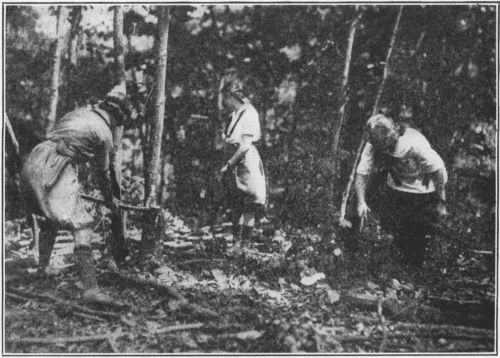 Wood Cutters
Wood Cutters
If you do not wish to have too strenuous a time for Water Sports Day a carnival is suggested which is more festive and makes for a very gay and picturesque time. The carnival can be worked out in a variety of ways, but the main feature is the decking of boats and costuming of the participants, prizes being given for originality. A short program of water sports can be added.
If there is adequate equipment Basket-ball, Baseball and Tennis become the outstanding or major games in a camp. These games should never be indulged in for the idea of winning at all costs, but for the fun that one gets out of them.
Of course there will be competitive games with qualified teams and high standards of playing, but there will[106] also be the impromptu and unexpected challenge games played in fantastic costumes, accompanied by many antics and songs composed on the inspiration of the moment, games apt to be remembered long after the other kind of competition has been forgotten.
Baseball for girls or children who cannot get used to the paraphernalia of hard balls, bats and mitts, can be played with a softer ball such as a playground ball, a light bat and if necessary the simpler rules of Indoor Baseball can be adopted for out-door playing. In most camps, however, enthusiasm for real Baseball generally outweighs every handicap.
Tennis does not take in the same number of players at one time as does Baseball or Basket-ball, therefore in order that everyone may get a try at it a schedule may be made out so that the courts will not be monopolized by one set of players to the exclusion of beginners or other enthusiasts.
Ladder tournaments, both for singles and doubles, solve this problem somewhat and create interest, especially when the final try-outs are on.
There are any number of group games, Volley Ball, Captain Ball, Relay Races and Ball Games, which are played in camps when there is adequate equipment for Basket-ball and Tennis, but more especially where there is a lack of it.
Individual games, such as Archery, and Quoits make the time pass pleasantly and profitably for a few who like to go off by themselves.
Dancing is an interesting pastime for camp and fills in many gaps.
It is a help in entertainments and if you are to have an end of the season pageant, it is well to hold dancing[107] classes regularly so that there will not be endless rehearsing for the last days.
There are three types of dancing which can be presented. The Aesthetic or Classic, the Folk Dancing and the Social Dancing. For the most part, the Folk Dancing is freer, easy to learn and more suited to the community as a whole than the Aesthetic work.
It is better not to attempt much dancing in your schedule if you have no piano or stringed pieces, for although there are phonograph records to be had, the supply is too limited to be entirely satisfactory.
A collection of English Country Dances by Cecil Sharpe are dances that everyone can do and enjoy.
The joy of horseback riding does not find its way into every camp, mainly because of the expense and responsibility entailed, but if it does there are many facts to know and master in horsemanship. For instance, one should know how to take care of a horse, which means feeding, watering, saddling, grooming, shoeing, tying and general care necessary under different conditions.
The requirements for riding are to know:
The requirements for driving are:
But sports are not the only side to the camper's program. Another very large and absorbing part is the Crafts, inclusive of Handcrafts, Woodcraft, Campcraft, and the distinct Scout occupations, such as First Aid, Home Nursing, Gardening, Signalling, and Homemaking, treated in the Girl Scout Handbook.
The handcrafts are more numerous than your fingers and can be defined as anything that is done with the hands. It is possible to have almost any branch of the Fine Arts and the Applied Arts as dyeing, batik, stenciling, woodblock printing, pottery. Then there is basketry, weaving, rug-making, leather work, and metal work in copper, or jewelry in silver, woodcarving and carpentry. The first problem is: "Who will teach it?" The choice of what handcrafts you will have then, depends somewhat on whom you can secure to present them properly.
But closely allied is your second problem, "What can we afford?" Jewelry, metal work and leather are the most expensive. Pottery is fascinating, but you must have a kiln to finish the product.
Try to choose the crafts which will suit the capacities. It is better not to attempt jewelry at the outset.
Relating your craft work to the camp makes it doubly interesting. So much can be done in this way with carpentry which produces anything from docks and canoe paddles to furniture and toothbrush holders.
Delightful problems in the interior decoration of a camp living room can be worked out by combining the efforts of all the craft workers. The carpenters build the[109] furniture; the weavers make rugs and materials; the dyers dip the materials and carry out the color scheme and other workers supply the accessories.
It is well to have an exhibition to look forward to for the end of the season when appointed judges decide upon the merit of the work.
Night is a dead monotonous period under a roof; but in the open world it passes lightly with its stars and dews and perfumes, and the hours are marked by changes in the face of Nature. What seems a kind of death to people choked between walls and curtains, is only a light and living slumber to the man who sleeps a-field. All night long he can hear Nature breathing deeply and freely; even as she takes her rest, she turns and smiles; and there is one stirring hour unknown to those who dwell in houses, when a wakeful influence goes abroad over the sleeping hemisphere, and all the outdoor world are on their feet. It is then that the cock first crows, not this time to announce the dawn, but like a cheerful watchman speeding the course of night. Cattle awake on the meadows; sheep break their fast on dewy hillsides, and change to a new lair among the ferns; and houseless men, who have lain down with the fowls, open their dim eyes and behold the beauty of the night.
At what inaudible summons, at what gentle touch of Nature, are all these sleepers thus recalled in the the same hour to life? Do the stars rain down an influence, or do we share some thrill of mother earth below our resting bodies?... Towards two in the morning ... the thing takes place.
Woodcraft in the beginning was the first science of man. As applied to camping we most frequently think of it as anything which pertains to the woods or forests and as a turning away from the more artificial side of camping, and as in pioneer times learning to do everything[110] ourselves, which is after all the keynote of real joy in camping.
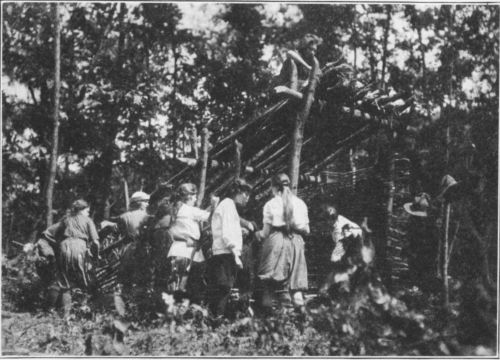 The Lean-To Going Up
The Lean-To Going Up
To acquaint ourselves with the woods we can begin with our immediate surroundings. Short walks to search for flowers or ferns and to know the different varieties of trees, or early morning trips to a bit of swamp land where we can study the coloring and habits of birds or sit quietly while patiently listening to distinguish them by their songs.
We can lie out on the grass when the stars have come out, and study the heavens or take trips at night with an experienced woodsman, who perhaps shows us that Nature by night is very often different from Nature by day, or of how we can find a trail through a dense wood by the light of a star—the North Star.
Woodcraft includes what we may merely for convenience[111] classify as campcraft, which is to know all there is to know about camping in the open.
For most purposes a good knowledge of how to make out-door fires; (both from the standpoint of heat and the kind of food to be cooked) cooking; trailing; and how to make and break a camp, are sufficient.
Beginners in this lore would do well to get a thorough knowledge of campcraft by going about it one step at a time. For instance, it is advisable to confine oneself to short trips at first and learn about the sensing of directions, trail cutting and blazing, cooking, pitching tents or building lean-tos; thus taking the various branches which are preparatory to the actual experience and real adventure of a camping-out party, and it is then and there that our real knowledge is tested.
The topics to be considered either when learning about campcraft or when actually doing it, are briefly:
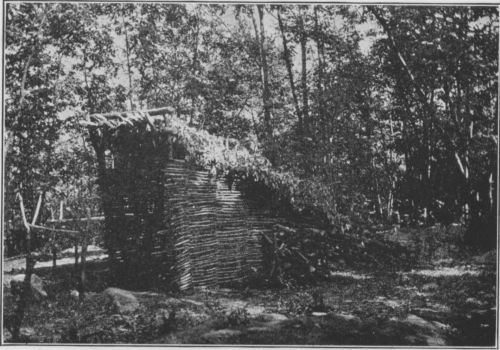 The complete lean-to, showing fire place, wood pile and table to right. Cache is in back.
The complete lean-to, showing fire place, wood pile and table to right. Cache is in back.
The basis for quite a comprehensive knowledge of woodcraft in all its branches, camping and Nature Study, is to be found in the Girl Scout Handbook, "Scouting for Girls."
Entertainments or shows of which there are an overwhelming variety are a great aid in keeping everyone in a cheerful frame of mind.
In the dramatic line we have the play, pantomime,[113] vaudeville, minstrel, "take offs," charades, the circus and dramatization of stories.
With musical talent in a camp it adds much zest to form an orchestra and then there is the possibility of musical evenings and concerts. Added to these are the Stunt Parties, Dances and Masquerades, Marshmallow and Corn Roasts, and if it is a seashore camp, the clam bake.
The play requires an amount of preparation and time not always to be spared in a camp unless the season is long. The most enjoyable shows are bound to be the more spontaneous expressions in the form of impromptu affairs.
There are celebrations which take place on particular days such as the Fourth of July or any other event which you wish to commemorate, just as the pageant can be presented to display your camping or community activities.
One of the finest things to cultivate if you are in close proximity to other camps is an inter-camp relationship, either in the forms of inter-camp contests or frolics, or any demonstration which you think betokens friendship. This may even go so far as the building of inter-camp shacks and the making of inter-camp trails.
It is not only illuminating to come into contact with another camp besides your own—it is a source of great diversion and enjoyment, if there is plenty of fun and friendship, and an absence of group jealousy.
Singing is a great and important part of camp life, for it reflects every phase and meets all the situations of that life.[114]
Songs are generally composed by the individual or by groups, being the expression of their feelings, or results of their experience in camp. The songs are quickly adopted by the camp as a whole because people like to sing their own songs, especially songs about fresh, actual happenings.
Some of the songs which reflect universal experience live on through the years and become traditional, while others drop out and are never heard of again. The following are Girl Scout Songs that have weathered more or less satisfactorily.
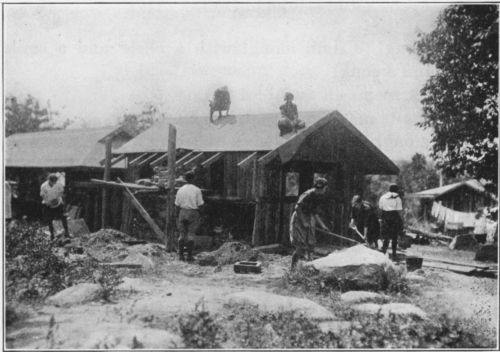 The Builders. House built entirely by Girl Scouts
The Builders. House built entirely by Girl Scouts
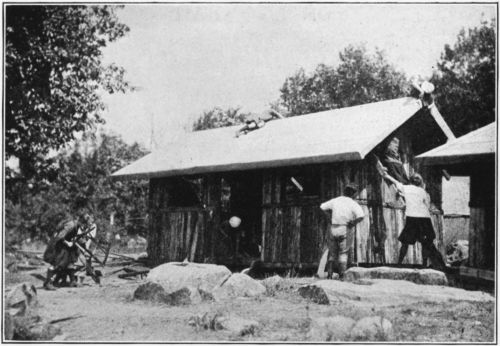 Nearly Finished
Nearly Finished
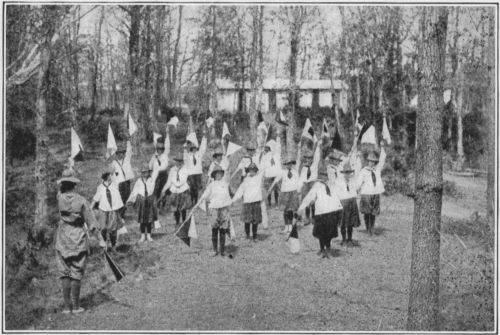 "Be Prepared." The Signalling Class
"Be Prepared." The Signalling Class
Whether you receive prizes or honors, points or merit badges for the attainment of a definite achievement in your camp work, it is more systematic to keep some sort of record of each individual's progress and accomplishment.
A very simple way is a book record, but a far more interesting and successful method is to make a chart placing it on a conspicuous wall space where all may study it. On the chart will be found the names of all the campers together, with the names of all the activities. In a space under these activity headings and opposite the girl's name, a space will be reserved for recording her points.
Take for example a proposed section of a chart such as the accompanying one.
For every girl who has received a point on such a[126] chart it means that she has satisfactorily complied with the standards imposed. For example, in Nature Study we may say that Scout Jane identified perfectly 20 flowers and 15 birds.
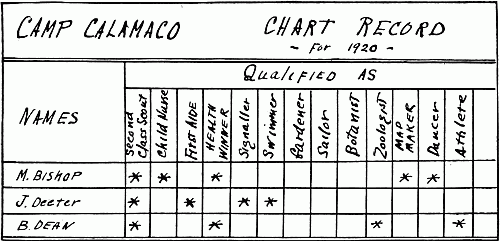 I. Section of a Chart for recording achievements of Scouts. In a large camp, a permanent backer with headings can be made, and strips for each Scout pinned on and removed when she leaves camp.
I. Section of a Chart for recording achievements of Scouts. In a large camp, a permanent backer with headings can be made, and strips for each Scout pinned on and removed when she leaves camp.
Girl Scouts would work out such a chart in relation to and on the basis of the winning of merit badges in the fifty-seven-odd Scout subjects.
Recording is not the only means of recognition given to a girl who has made a definite achievement along some given line. But awards and honors are often given at the end of the season in many camps. However, only the merit badges will be discussed here, as this is primarily a Manual for Girl Scout camps.
It is to be remembered that the chart does not record everything about a girl. When reviewing the chart or record book before deciding who deserves the final honors, or merit badges, there are other things to be taken into account, for instance, the effort and the progress or improvement and the kind of spirit that went with the material achievement.
Now away we go toward the topmost mountains. Many still, small voices, as well as the noon thunder, are calling, "Come higher!"
The daytime hike gives the camper an opportunity to see something of the surrounding country, and to have the experience of following paths and trails, of climbing and coming into touch with the deep woods, and all of their beauties. Also the necessary routine and rules of an organized camp would prove unbearable to the all-summer hiker if she did not get away from them once in a while. The very purpose of the camp would be thwarted. All children are not so constituted or trained that they can go off and sleep in the woods even for one night, but they should be encouraged to take hikes varying in length from five to twenty miles according to the child's ability to endure.
The daytime hikers should leave camp by ten o'clock, each one properly shod and clothed and for convenience carrying her own luncheon either in a knapsack or in a little, well-wrapped parcel. She should have her individual drinking cup, and if the hike is to include a swim in some far-off lake, a bathing suit and bath towel should be taken. There should be an objective for these daytime hikes and the paths and roads should be well known by some member of the party. Two hours is none too long a time for the noon rest and luncheon and the return trip should be planned to bring the campers into camp before supper. It is never wise to start out with a group of girls who cannot keep about the same pace. Nothing is more fatiguing than exerting oneself to keep up to a pace or on the other hand to[128] slacken one's pace for the accommodation of the lagger. There should always be one person in charge of the entire group and she should have as many assistants as the size of the group requires. One counsellor to every ten girls is none too many for a daytime hike. Under no circumstances, even though there were but six girls, should one counsellor assume the entire responsibility for a week-end or overnight hike. There should always be at least two older people. The great opportunity for studying Nature should be taken advantage of and if possible a nature study teacher should accompany the girls. All hikers on return to camp should be examined, and any blisters, bruises, cuts or strains should be reported and properly attended to. There have been cases where from neglect, a blister on the foot has become infected, causing serious trouble.
Girl Scouts when hiking along highways should walk in single file on the left hand side of the way, thus giving them an opportunity to see approaching vehicles.
There are many interesting signs that can be made by Scouts when hiking, to mark the trail or note conditions observed. These signs and their uses are given in the Girl Scout Handbook and should be learned and put into practice. The use of them develops the powers of observation and makes for alertness.
No child should be permitted to start out on a week-end hike unless her physical condition is such as to withstand any unexpected weather conditions which might arise or prolonged exposure in the open. Also she should be properly clothed; preferably in thin woolen clothes, wearing as little as possible, yet being comfortable. Her shoes should be stout, low-heeled and[129] round-toed. She should take with her a sweater, extra underwear, stockings, nightclothes, toilet articles, and blankets.
Only sufficient food should be taken to last during the time planned for. This food should be packed in small bags, preferably waterproof. Two and a quarter pounds for one day's rations is sufficient. Cereal in some form, many prefer flour in order to make bread, a fat—such as bacon or butter—rice, for bulk, something to drink, cocoa or tea, a sweet, preferably chocolate, a small amount of sugar and raisins are suggested. Eggs can be added to the above; also salt, baking powder, evaporated milk and dried egg.
Never start for a week-end hike late in the afternoon. Plan to make camp not later in the day than five o'clock. At once build the campfire and start to prepare the supper. Select suitable places on the ground for sleeping. Make sure that the ground is dry, and if possible spread a poncho under the blankets. A hole dug so that the body will fit into it and touch the ground at every point makes sleeping more comfortable. Keep the campfire burning all night, different members of the party, two at a time, being on guard. Do not have the fire too large. One of the signs of a tenderfoot woodsman is a big fire for cooking or the night watch. Not only are they dangerous, but when using them for cooking the cook as well as the food is apt to be burned. Before building the fire, scrape all leaves and dried grass from the ground, leaving a foundation of bare earth. Make sure that every vestige of fire is out upon breaking camp. Also that no evidences of a camp save the matted grass are left behind.
In carrying a pack, place the load high on the back and move the body forward to keep the center of gravity.[130]
. . . And when the airs is warming, it's then yourself and me should be pacing . . . in the dews of night, the times sweet smells do be rising, and you'd see a little shiny new moon, may be, sinking on the hills.
The overnight hike is more of a lark than the week-end hike. Its principal features are sleeping in the open and cooking one's food in the most primitive manner. The same requirements as for week-end hikes should obtain as to the number of counsellors and the child's physical condition. Also she should be properly clothed for the trip as to shoes, stockings, underclothes, and so forth. The necessary equipment for an overnight hike such as nightclothes, toilet articles, etc., can be neatly laid in a blanket and the blanket rolled from end to end. It should be tied in the center, about four inches from either end and between the ends and the center with a stout string. Bring the ends together side by side and tie tightly. Throw the blanket over the head, the ends under one arm, the center of the blanket on the opposite shoulder.
The hiker can take more food than is strictly necessary, for as a general thing she walks only a short distance and can thus carry a quite heavy pack. The trip should be so planned that the hikers reach their destination by five o'clock in the afternoon. The following day can be spent in exploring the surrounding country, finding as many points of interest as possible, studying the trees, the flowers, the birds, and following up any trails, paths or streams which look interesting. The day should be so planned that the return to the main camp will be accomplished in the late afternoon or early evening.[131]
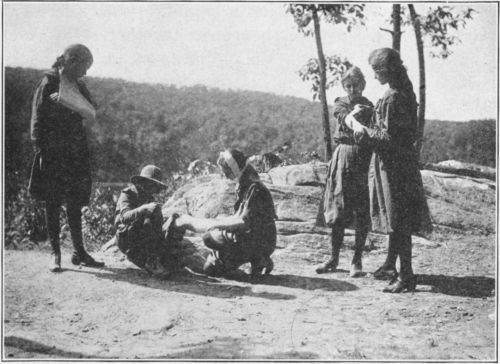 First Aides. Several Kinds of Bandages
First Aides. Several Kinds of Bandages
There are various kinds of camp fires that can be made and experimented with while off on a hike. The log cabin fire, in which two sticks are laid parallel to each other about nine inches apart, two more laid in the opposite direction on top of the ends of the first two sticks, the square made about three sticks high. In the center of this is laid a small fire of dried leaves and small dried twigs. When the fire is well started larger twigs should be slowly added until there is a bed of coals on which can be put short sticks of wood. The cooking utensils can be stood on the log cabin foundation if it has been made of wood sufficiently large to withstand the heat of the fire, or they can stand on a grating placed over the fire. Never cook over a blaze. Wait until there is a bed of coals.[132]
Another way of building a campfire is to select two large green logs; place them near together at one end, the other ends 18 inches or more apart and facing the wind. Build the fire in between the logs. Smooth off the top of the logs with an axe to form a support for the cooking utensils.
Where large stones are available make a fireplace by putting two stones about ten or twelve inches apart at right angles to a large back stone, or place three stones to form a hollow square, building the fire in the center. Cooking utensils can be stood on a stone placed over the top of the fireplace or on a grating placed across the top, or rested on two iron bars laid on top of the fireplace.
Another fire can be built by placing three medium sized sticks in the shape of an Indian tepee or wigwam. The sticks must be of about the same size and placed so carefully that they will not fall into the fire which is built underneath them. When the dried leaves and twigs have started to burn well, add a little wood of a larger size, thus gradually building up the fire. Over the fire three larger sticks can be placed—those which are three or four feet in length—brought to a point, fastened with rope and a kettle hung over the fire from the center.
One of the best woods to use is scrub oak which is distributed quite widely over the United States. It burns slowly and gives out an even heat.
Another fire, especially useful in the case of high wind, is built in a trench, one end of which is deeper than the other, also wider. Start the fire with dried leaves, twigs, etc., gradually adding larger wood, finally using logs placed lengthwise in the trench. This type can be used very effectively for burning garbage, particularly if the garbage is placed in the trench and the fire built on top of it.[133]
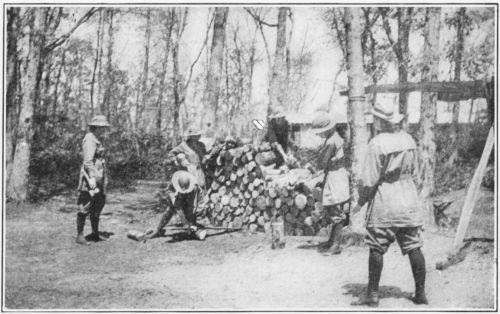 To "Keep the Home Fires Burning," Keep the Wood Pile High
To "Keep the Home Fires Burning," Keep the Wood Pile High
Another type of fire which can be used for warmth even better than for cooking is built in front of three large logs placed one on top of another in slightly slanting formation. The logs serve to reflect the heat.
A few suggestions may be helpful to the young camper. Before lighting your fire have at hand all of the necessary material, dried leaves, tiny dry twigs, twigs of a larger size, small sticks, and finally your heavy fuel. Do not smother the fire by starting with too much material and do not put it out by putting on too much wood at one time. The object is to have a bed of hot coals over which you can do the necessary cooking without either smoking the cooking utensils, burning the food, or burning oneself, or being choked with smoke.
There are various cooking utensils and appliances made especially for campers which are both interesting to use and most serviceable. One is the grate with folding[134] legs which can be stuck into the ground, the grate placed over the fire. Another is the reflector oven made of tin with a shelf holding a pan, the whole to be set in front of the fire, and can be used for baking bread, apple cake, etc.
The greatest test for the camper is the building of a fire in rainy weather when leaves and twigs and wood are far from dry. It can be done and the greatest joy derived in the doing. Choose an old log which is not water-soaked. Split it with an axe; split one-half of it again. With a sharp knife make a little pile of shavings whittled from the heart of the log. Put them in the center of the log cabin formation. Light them from underneath (which is the way all fires should be lighted), and coax the blaze by adding dry shavings as required until there is sufficient blaze to light the small wood which has been collected. This fire takes patience and perseverance.
It is sometimes possible in very wet weather to pick up small wood that has been protected from the rain; also to break off the dead wood of trees or the small twigs on the ends of the limbs to start a fire.
Under no circumstances should a camper use artificial tinder of any kind. No paper, excelsior or oil should be used in building a campfire, and a Scout should need only one match.
Always build a fire where the wind will blow the smoke away from the camp, and never fail to build it on the bare ground where there will be no possibility of its creeping through the grass or underbrush into the woods.
After a meal when necessary to burn garbage, do not throw a quantity right on top of the fire to smoulder and cause a disagreeable odor. Rather sprinkle it[135] around the edges that it may dry before being shoveled onto the coals. When necessary to burn papers, be careful that a burning paper does not blow into nearby brush or woods.
The questions of fires and provisions for hiking are treated at length in the Girl Scout Handbook.
We are now in the mountains and they are in us, kindling enthusiasm, making every nerve quiver, filling every pore and cell of us. Our flesh-and-bone tabernacle teems transparent as glass to the beauty about us, as if truly an inseparable part of it, thrilling with the air and trees, streams and rocks, in the waves of the sun—a part of all nature, neither old nor young, sick nor well, but immortal.
There were ten of us—our chaperones, a man and his wife; a good all-round camp man, capable of instructing in camp life, fishing and wood knowledge of all kinds; our Captain and four Girl Scouts.
We left Tacoma at seven A. M. by automobile, driving three hours to the foot of Huckleberry Mountain from which point we were to hike to camp. Here we were met by a native of the parts who was to carry a pack, as we had not enough men to manage supplies. Pack ponies are out of the question, for the trail leads for six miles over fallen trees and through dense growth. After half an hour, our packs and bed rolls adjusted, we started off at a good even pace for the river.
For one mile hiking was comparatively easy. Then we had to cross the river over a fallen tree. The girls could not do this and carry their packs, so the men made several trips after which we all crossed. The time taken in[136] crossing the river was equivalent to, a good rest, so as soon as the last member of our party was over, we readjusted our packs and started on our way.
The trail now led through a dense fir forest with its scattering spruce and hemlock. For a mile it led along the high bank of the Deschutes River where we could look far down into myriads of jade-colored pools; then for a mile into the very heart of the woods among masses of glassy, dark-green ferns, and clumps of feathery, tossing maiden-hair; through Oregon grape, bright arsenic green and brilliant red. Here and there we came to a fairy-like dell, carpeted with red and green moss, starred with hundreds of flat five-petalled white blossoms. At the far corner of this nook, more unprotected where the sun shone, was a clump of the blue and white butterfly blossoms of the Mountain Lupine. In one of these dells we stopped for our luncheon. It was just past that silent hour of the woods and we could hear twigs snapping under the feet of moving animals. Birds were singing and it was the one time of day when there is a perfume in the dense woods such as we were in; a drugged perfume of sweet clover, the flowered mosses and scattered Lupine. Before leaving we each ate an orange we had been told to bring, as mountain water taken on a hike winds one too quickly. During the hike we could chew dried prunes at any time, but absolutely no water could we have until we reached camp.
The trail then led back to the river bank and along it over fallen logs and among trees deeply laden with hanging silver grey moss. This lasted for two miles, until the river split, forming a small island easily reached by stepping stones, where camp was made.
The very first thing done was to teach the girls how to make beds, which we did, while the men cut hemlock[137] boughs; our extra man remaining long enough for that. The second thing was to pick out places for our beds and as soon as there were enough boughs we placed our bags, already made, upon them. The men then gathered enough wood for that night and the following morning. Pitch torches were made and stacked where we could get them. While they were busy with this heavy work that had to be accomplished before night the girls gathered rocks for the oven, and dug a hole for the cache. This hole was lined with one of the small tarpaulins, all food placed in it, tarpaulin drawn over, and slabs of bark then placed over the hole. This protected food, both from weather and animals. A shelf was made on the side of one of the trees on which the baking powder tins were placed with salt, sugar, part of flour, such things as coffee, jam, milk, etc., that were already in tins were also kept on this shelf.
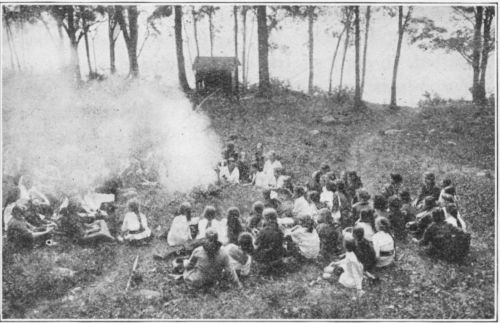 Around the Campfire
Around the Campfire
This work was completed by five-thirty, the cook oven[138] constructed and second fire made around which the beds were placed. Dinner over, we turned in early, being exhausted, in spite of the good condition we were all supposed to be in for the trip. We slept in our clothes with cap and bed socks for extra warmth and comfort. The two men did not sit up all night, but took turns keeping up the fire as it needed attention. The only animals are deer and cougar, the former harmless, while the latter seldom come near camp except when it is deserted. They cause little trouble in the woods, as we never go alone, but always in couples. They will track a single person, but never two.
Morning routine commenced with a dip in the river and change of clothes. As we wear our breeches when out fishing and our skirts in camp, no extra heavy wearing apparel need be carried. Immediately after breakfast the beds are always taken apart, blankets folded and placed on second small tarpaulin in lean-to which had been constructed from large slabs of bark against a tree. This lean-to kept bedding protected from the atmosphere and animals, as well as serving a second purpose of camp orderliness and neatness. A second lean-to was made for wood, bark and pitch torches. The first morning it was necessary to complete camp construction before the fun commenced. Shelves were made on the river bank for toilet articles, nails placed for towels, etc., and saplings formed as a screen for fear of a chance fisherman or game protector passing by. On the other side of the island a place was made for washing dishes.
Camp made, we were free to go fishing. So taking a can of unsalted salmon eggs in our pockets, our rods, and a v-shaped twig to carry our fish on, we were off until lunch.[139]
We all assist in making and cleaning up after this meal. Then an hour of rest is followed by fishing, learning woodcraft methods of various kinds, or anything that we may choose to do. Dinner was prepared while there was still daylight, and then the best part of camp life began—telling stories around the fire, studying the stars and singing to the accompaniment of mandolin and ukulele, always carried on a trip of this kind.
The large tarpaulins brought are for emergency only, in case of a thunderstorm. Such occurring we gather all our beds together into one row and the tarpaulin is placed over them, under which we lie until the storm is over. By crawling out carefully we can gather up tarpaulin and shake it out away from our bedding and thus we can keep dry without the shelter of cabin, tent or lean-to.
This is a general routine of a short roughing trip in the deep mountain forests of North Western Washington.
The only addition necessary for the ordinary Girl Scout equipment for a week-end hike is fishing rods and tackle.
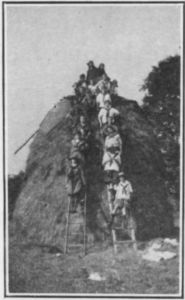 Girl Scout "Hayseeds" and the Stack They Made
Girl Scout "Hayseeds" and the Stack They Made
Too great stress cannot be laid upon the question of sanitation. Make the camp safe if you would have a healthful, happy camp, and keep it orderly if you would keep it safe. The time to make the camp safe is before and during the process of building and prior to each camp season if an old camp is used. Certain known things are fore-runners of trouble and should be avoided or safeguarded against from the start. Among these are low, damp ground, impure water, an insufficient supply of water, unsafe bathing conditions, such as deep water only, a very swift current, undertow, shallow water and a quick drop, holes, and so forth; proximity to pest breeding places such as pools of stagnant water, marshes where mosquitoes breed, uncared-for out houses, barns, and dumps; inadequate latrine facilities, and so forth.
The keeping of the camp safe is a daily matter which includes the disposal of all waste, the cleaning of the camp grounds and all buildings, the inspection of the water supply, provisions, equipment, the latter in a general way, the guarding against pests of any kind and the personal health of the campers.
Every morning all trash should be collected and properly disposed of. Burning is the only method unless[141] arrangements have been made to have all dry waste carted away. For burning light trash use a small incinerator two feet high and eighteen inches in diameter, made of iron, and with a cover circular in shape and perforated closely with holes half an inch in diameter. When in use the incinerator should stand in an open place away from all tents and buildings. The heavier trash, such as old shoes, paste-board boxes, discarded clothing, should be burned in a heap away from all buildings, care being taken that no bits of hot paper cause grass fires, or blow into the woods.
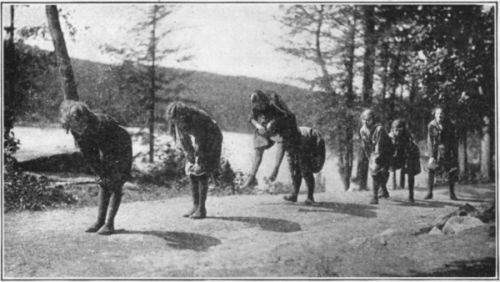 "Over the Top"
"Over the Top"
Wooden boxes in which provisions are shipped can be split up for kindling wood, or if the boxes are large and well made, kept for packing equipment for storage. Some of the well-made boxes are very serviceable to use as seats, and one could be placed in the kitchen to hold wood. Butter tubs, if washed and dried, can be used to hold vegetables or other provisions. Barrels should never be thrown away if in good condition. They are invaluable when packing dishes or kitchen ware and during the[142] summer will hold sacks of provisions such as cereal, rice, hominy, beans, and so forth.
All tin cans should be rinsed out as soon as emptied, burned on the trash heap and when cold thrown into a covered pit, or into covered barrels to be carted away at the end of the season.
There are three ways of disposing of garbage when in camp. Burn it, bury it, give it away. Sometimes all three ways are necessary in one camp. If the group is small and there is little garbage it can be thrown around the edge of a hot fire and when dried out, raked onto the hot coals.
In larger camps a portable incinerator can be used. One form has a basin over the fire pot, into which garbage is placed to be dried out and then turned into the fire.
In camps of 100 or more people where burning is difficult, pits for burying garbage have been found satisfactory if properly cared for and dug not near the camp buildings or source of water supply. They should be deep, oblong in shape, and the earth should be thrown up at one side to be used in covering the garbage as soon as it is thrown into the pit.
In a camp where there is no plumbing, liquid waste as well as garbage, can be disposed of in the following way. Dig a trench four feet long, two feet deep and thirty inches wide at one end; eight inches wide and level with the ground at the other end; line with stone, or if this is impossible, use tin, sheet iron, or brick. Put the garbage into the trench, build a fire on top of it, when the fire is very hot pour the liquid waste into the trench at the small end. If there is a great deal of garbage some of it will have to be put on top of the fire[143] which should be made of heavy logs of hard wood. Tin cans can be burnt in this fire and then treated as stated before.
The disposing of camp garbage is not a difficult matter if some system and care are used. It is necessary to have a covered pail near the kitchen door for use during the day. The contents of this pail should be burned or buried every night after supper and if necessary once during the day, preferably after dinner. If this pail is lined with two or three thicknesses of newspaper each time after emptying, it will be kept in good condition.
If garbage is to be carted out of camp, have proper receptacles for transporting it and do not let too much accumulate at any one time.
Under no circumstances allow waste food to be strewn on the ground anywhere within camp limits, or the ground around the garbage pail, pit or incinerator to be untidy.
One of the best disinfectants for latrines and garbage pits is smouldering tar paper. Break the paper into small pieces, throw into the latrine or pit, light and let smoulder.
At least twice a week camp grounds should be thoroughly inspected to make sure that there are no pest breeding places such as pools of stagnant water, old tin cans in which water will collect, trash heaps, and so forth. It is much easier to keep flies and mosquitoes away by doing away with such places, than it is to exterminate them after they have come in large numbers. If camp grounds and buildings are cleaned every day and all waste properly disposed of, there is little danger of trouble from pests.[144]
In localities where mosquitoes and flies are very troublesome other precautions should be taken. It might be necessary to have mosquito netting over the cots at night and fly paper in the kitchen and store closet. A piece of absorbent cotton saturated in citronella and hung on the tent poles at either end of the tent will sometimes keep mosquitoes away as they dislike intensely any strong odor.
If ants get into the kitchen or store closets borax sprinkled on the shelves will often send them away, or if they are very troublesome dishes of food can be stood in pans of water.
An adequate water supply is most essential for any camp, and should be one of the first things to be considered in selecting a site. Springs and wells generally supply the camper with drinking water; lakes and streams with wash water. Few springs or wells can supply enough water for all purposes when a camp is large.
Whatever the source of supply the drinking water should be tested by the Health authorities before camp opens, and at any time there is any question concerning it. Springs and wells should be cleaned out and the former protected with boards or screening if necessary.
Too much thought cannot be given to the question of the water, as to its purity and quantity. Children drink a great deal in hot weather and much has to be used for cooking and washing. If there is any danger of the drinking supply giving out, to prevent waste, allow only one or two people to draw water and then only when necessary.[145]
Keep covered tanks or coolers of drinking water in shady places, convenient for the campers. Caution all as to wastefulness and if in case of an emergency there is only a very little, place a counsellor in charge of it and deal it out by the cupful, seeing that all have an equal share. Of course, only individual cups should be used.
Should there be any doubt as to the purity of the water, boil it for twenty minutes, place in earthenware or agate vessels, cool, cover and lower the vessels down the well, or put them in the ice box, or some cool place for the water to get cold.
Water for cooking can be taken from a lake or stream. It is generally boiled.
If the only source of supply is a brook or stream, water for drinking should be taken above camp. All vessels in which it is carried or kept should be thoroughly washed each day.
No camp should remain open if the water supply is not what it ought to be.
If a camp is supplied with running water and plumbing has been installed the location and covering of the tank and the cesspool are important things to consider.
The drain pipes connected with sinks or tubs should be flushed occasionally with disinfectants, the sink drain cleaned daily with boiling water and washing soda.
Marsh land near a camp site which is otherwise desirable, if treated with crude oil or the water drained off by ditches, will not prove a menace.
Every camp must be provided with adequate latrine service. One unit for every eight or ten people is considered necessary. The type of latrine to be used will[146] depend on existing conditions at the camp site, but whatever it is the greatest care must be taken to keep them clean. Seats and covers should be scrubbed every day, houses swept and toilet paper provided. Covers should not remain open, and it should be considered a misdemeanor to throw cloths of any kind into a latrine. As a place must be provided for them it is suggested that a small portable incinerator be kept in a closed box stood in one corner of the latrine house, and that the incinerator be removed every day to a near-by open place and the contents burned.
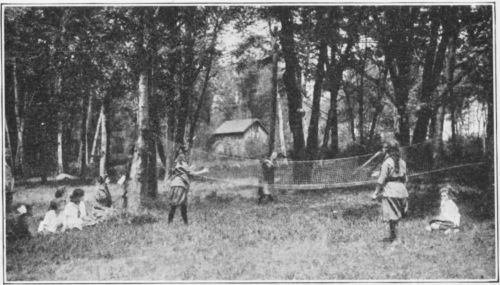 Volley Ball
Volley Ball
Latrines should be cleaned out before camp opens and the ground around them left perfectly clean. As a precaution make sure that no part of the contents is deposited anywhere near camp. If the ordinary out-of-door closet is used, see that chloride of lime is sprinkled in the pit daily.
If a small group is to be provided for in a temporary camp and a latrine must be built, the earthen closet will[147] probably give the best satisfaction. This is made by digging a trench 2 ft. wide, 3 ft. deep and in length 2 ft. for each unit. Over the trench place a box seat 17 inches high, with holes having hinged covers. Bank earth around the bottom of the box and in front of it place a board walk. Protect the seat by pitching a tent over it or encircling it with a strip of canvas 5 ft. high, fastened to posts, the ends of which pass each other forming a protected doorway. A box of earth and a small shovel should be kept in the tent and every time the closet is used earth should be thrown into it. Lime should be used daily. When necessary to dig a new trench make sure that the old one is properly filled in. A latrine of this kind must not be placed near any water supply.
A type of latrine which is being built on permanent camp sites in the Palisades Interstate Park and which has been developed by the engineers of the Park Commission, is giving such satisfaction that an outline of its construction is herewith given.
Dig a pit in which is built a concrete tank 3 ft. wide, 3 ft. deep at one end, and 3 ft. 8 inches at the other, and 17 ft. in length for eight units, the concrete 6 inches thick.
Build over it a house 6 or 7 ft. wide, the rear and one side wall of which rest on the rear and lower end wall of the pit. The deep end of the pit for 18 inches is left outside of the house. This opening, which must have an adjustable cover, is used when cleaning the pit.
Floor the building to within 20 inches of the rear wall. Cover the opening in the floor with a box seat 17 inches high leaving in it properly made toilet seats, 2 ft. apart from center to center, with covers.
Make four agitators, one for every two units, by fastening[148] a wooden paddle 5 x 7 inches onto one end of a 5-ft. length of 2-inch iron pipe. Put the pipes through a slot in the seat between the two openings, the paddle at right angles to the length of the seat, and clearing the bottom of the pit by three inches. The agitators are held in place by clamps attached to the bottom of he seat which allows the pipe handle to be moved from side to side. Vent pipes 4 inches in diameter extend from the pit up through the seat back of each cover, and through the roof for 18 inches.
Charge the pit with 175 gallons of water and 240 pounds of Kaustine, a patented chemical compound. By moving the agitator handles from side to side whenever the latrine is used all solid matter is brought in contact with the Kaustine solution and decomposed.
As with all other latrines, the house must be kept clean and the seats scrubbed each day. It is not necessary to use any disinfectants in this type of house, but it should have two doors and windows.
First Aid supplies are a necessity in camp and should always be provided. Some one person must be responsible for them and when possible this person should be either a trained nurse or a practical nurse.
| Absorbent cotton |
| Sterile gauze |
| Bandages |
| Iodine |
| Vaseline |
| Bicarbonate of soda |
| Castor oil |
| Alcohol and sugar of lead (for ivy poisoning) |
| [149]Hot water bottle |
| Alcohol |
| Aromatic Spirits of Ammonia |
| Epsom salts |
| Small alcohol stove and pan |
| Cascara |
| White enamel basin |
| Towels |
The nurse should have a tent or a corner in some building where a table and shelf covered with oil cloth and a bed can be placed and all supplies properly cared for. No one should be allowed to take any of the supplies without her permission.
It is advisable to have in every camp, pails of water standing in the mess hall, in the kitchen, or in other accessible places, or small chemical fire apparatus to be used in case of necessity. A fire drill is also an essential provision.
Place the indoor camp stove on a concrete base with zinc back of it.
In building the mess hall chimney, be sure that two flues are built, in case one needs to be used for the kitchen stove pipe, as one flue cannot be used for two fires.
Before any child is admitted to a Girl Scout camp she should have been thoroughly examined by a competent physician. These examinations should be arranged for by the Local Councils. With very slight effort it is possible to enlist the interest of physicians, particularly women physicians, in making these examinations.
The accompanying certificate (p. 52) is particularly recommended as preferable to an informal statement. This certificate, properly filled out, should be of great[150] assistance to the Camp Director in safeguarding the health of the Scouts in camp. It must be remembered that young girls are ambitious to do all that their fellows do, and very seldom are willing to admit any physical disability. The responsibility should not be on their shoulders. Camp life subjects each person to quite unusual physical exertion which in some cases may amount to a strain. The things to be especially guarded against are heart disturbances, either functional or organic; painful or too profuse menstruation; flat foot, weak backs and prolapsed intestine. Under-nutrition and anemia will usually be automatically corrected by life in the open and the consequent increased appetite. No child who is markedly undernourished, however, should be allowed to take extraordinary exercise until she has begun to gain.
Before the Scouts start for camp they should be assembled and inspected in a group by a nurse, or some other person competent to detect body and head lice. No Scout should be allowed to come to camp infested with vermin, and yet this happens repeatedly unless definite precautions are taken. As a rule this cannot be left to the examining physician. If this examination is made as early as a week ahead of the time to start for camp the children's heads can be cleansed.
To cleanse the head from lice, rub the scalp and saturate the hair with kerosene. Tie the head up in a thick, clean cloth held in place with safety pins. Leave the bandage on over night. After removing the bandage it should be plunged at once into hot soap suds, and thoroughly washed. Wash the scalp and hair with castile or ivory soap, rinsing thoroughly. Dry with clean towels. Combs and brushes should be thoroughly cleansed before using. It may be necessary to repeat this process once.[151]
The ideal should be held before each Scout of having her health record while in camp a perfect one. Should any unforeseen trouble arise, however, she must report at once to the nurse or Director.
Whenever possible, sleep with tent sides and flaps up; never with the tent closed except in case of a severe storm.
Indigestion, constipation, diarrhea, headaches, bruises, blisters, strains and sprains, insect bites, sunburn and ivy poisoning are some of the common camp ailments that have to be dealt with.
Observing the Scout Health requirements as discussed in the Handbook, "Scouting for Girls," helps very much in establishing a healthy Scout camp and keeping out of it conditions which are often due to carelessness.
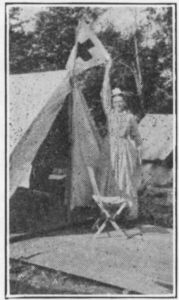 The First Aid House
The First Aid House
To buy in large quantities at wholesale and pay for the order within ten days is economy. To ship by boat and not by rail, when possible, also saves money. To have a dry, well ventilated store room and an ice room is to save still more. It is possible and feasible to order before camp opens, the necessary dry groceries and canned goods to be used in a camp of 150 during a period of four to five weeks, and to care for same in a comparatively small space.
The amounts needed can be computed from the amounts necessary for a family of four or six. In fact, the knowledge necessary to provide properly for a family under ordinary circumstances is of the greatest help in providing for a camp be it large or small. There are many good cook books which specify quantities for given numbers of people; knowing these, the numbers of campers to be fed per day, the amounts in which various kinds of dry provisions are sold at wholesale, gives one the key to the situation. By making out roughly a week's menus, a close estimate can be made.
Cereals, flours and meals can be bought by the sack and range in weight from 50 to 100 pounds. Sugar can be bought by the bag or barrel, the latter being better because it is cleaner. Navvy beans, to be used for baking, are sold in bags, 150 or 160 pounds in a bag. Baking powder is bought in 5-lb. tins. Cocoa is bought in 25-lb. drums. Macaroni comes in 22-lb. boxes. Peanut butter in 10-lb. pails. Crisco comes in 6-lb. cans; molasses in No. 10 tins, 6 tins in a case; tomatoes in No. 10 tins,[153] 6 in a case; apple butter in 30-lb. pails; cod fish in 20-lb. boxes; soap, 1 case of 100 bars; butter in 63-lb. tubs; eggs in a case of 30 dozen; prunes, apricots, peaches in 25-lb. boxes; raisins in 25-lb. boxes; cheese, 30 lbs. (whole cheese); split peas in 60-lb. bag; vanilla in pint or quart bottles; salt, 25-lb. bag; corn starch, 1 package of 2 dozen boxes; soda, cinnamon, nut meg, ginger, pepper and mustard to be bought in small quantities as needed.
Fresh milk, if obtained from a dairy, is delivered in 40-qt. cans. A quart and a cup per person per day is a good allowance for drinking and cooking purposes. If fresh milk is not obtainable, or can be had only in small quantities, a good brand of evaporated milk should be kept on hand.
Fresh vegetables are bought either by the pound, bunch, quart, peck or bushel. In so far as is possible they should be cooked the day they are delivered. If, however, it is necessary to buy vegetables at one time for two or three days' supply, use first such things as spinach, peas, beans and corn, for cabbages, carrots, beets, tomatoes and squash are more easily kept and are not so impaired in flavor by keeping.
If fresh meat or chicken is to be served it should be cooked the day it is delivered, or kept on ice until such time as it will be needed. Fresh fish should be handled with great care and not allowed to remain off the ice for any length of time. There are so many wholesome substitutes for meat that it seems entirely unnecessary for campers to have meat more than once or at most twice a week. In the summer time, it is very heating, and also the meat which is obtainable in small communities is very often not the best quality, to say nothing of being very expensive. An occasional pot[154] roast of the top of the round, or a roast of lamb, or a piece of corned beef can be used. Fresh fish when obtainable and well cooked is always most acceptable.
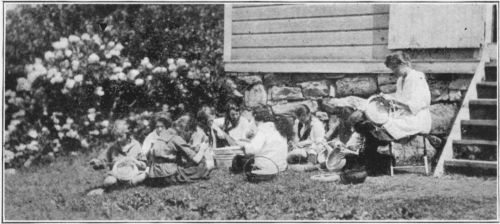 The Weavers
The Weavers
Canned meat and canned fish are not recommended.
All bags of cereal, meals or flour should be placed in covered barrels, boxes or tubs stood on a platform raised from the floor. Boxes of dried foods such as fruit, cod fish and so forth should be stacked, each kind in a pile and placed on the platform. All tinned goods should be taken out of their cases and laid on shelves. Butter, crisco, eggs, peanut butter, apple butter, and so forth, should be kept in the ice house. Cheese should be wrapped in cheese cloth wrung out in vinegar and kept in a box on a shelf in the store room, not in the ice box.
The handling of fresh milk is something which should be done with great care. After opening a large can, the milk should be stirred with a long ladle which reaches to the bottom of the can. The quantity of milk needed should be taken out and put in a pitcher. For dipping out the milk use a dipper which has been sterilized by[155] placing it in boiling water and cooled by allowing cold water to run over it. This dipper should not be used for any other purpose than taking milk from the large can and when not in use can hang in the ice room. Milk cans should always be kept covered and no milk which has once been taken out of a can should ever be poured back into it. What is left from the table should be put in a pitcher and stood in the ice house to be used for cooking. Milk which is handled in this way and which comes from a first class dairy will keep sweet for three days. It is not essential to keep fresh vegetables in an ice house. If the tops are cut off, vegetables can be kept in baskets in the store room. Under no circumstances should anything hot or even warm be put into the ice box, as the steam which arises from the combination of cold and heat will decompose food very quickly, or cause it to sour. Anything that is hot and needs to be cooled before placing in the ice box should be covered with cheese cloth kept for the purpose and stood on the store room shelves.
Bread, if bought from a bakery, can be kept in a barrel or on shelves and covered with cheese cloth. The sandwich loaves are recommended as they cut to better advantage in the bread cutter, and are more economical in the long run. These loaves weigh about three pounds apiece and cut into from 40 to 45 slices.
Ice cream salt should not be kept in the store room, but in a half-barrel or tub outside of the kitchen door. Salt causes dampness, which is not desirable. The bag of table salt should stand in a tub or box of some kind. Fruit, especially tomatoes and peaches, should be watched closely as little flies are apt to collect on them.
It is most essential that the store room be swept, the shelves brushed, and everything not of use removed from[156] it every morning. This is true with the care of an ice box or room. Not a day should pass that it is not thoroughly inspected and all that is not usable removed from it, and the room left in a perfectly clean, wholesome condition. The ice compartment should be washed out two or three times a week before the fresh ice is put into the box.
Do not buy more perishable food than can be properly taken care of and used within a day or two. Watch it closely, pick it over each day and throw out any part which shows signs of decay.
Do not neglect to replenish the larder before supplies are out, as transportation is slow. Do not forget that large quantities take much more time to cook than small quantities. Many times meals are not served on time for this reason.
Make a point of weighing, measuring and apportioning. It is economy to do so.
Nail a card in the kitchen on which is given the quantities of those things which are used constantly and the number of people each quantity will supply: sugar, butter, bread, cereal, cocoa, dried fruit.
Buy only what is needed and can be properly stored. The second grade of many foods is as good as the first in taste, and as nourishing. It costs less, and many times simply because it is not perfect in size or uniformity.
To buy in bulk is less expensive than to purchase boxed or tinned goods. This rule for campers pertains particularly to cereals, crackers, meals, flours, sugar, cocoa, raisins, etc.
When buying fresh fruits, vegetables or meat, take advantage of the market, even if it means a quick change of menus. A surplus means low prices.
Having bought what is the best or the best that can[157] be afforded, do not spoil it in the preparation, cooking or serving. A deplorable condition exists in many homes and doubtless camps as well, because the art of provisioning from first to last is not better understood.
The Girl Scout camps must prove that thrift and good food go hand in hand; also that in every department related in any way to our food, which is of such importance to health and happiness, the most approved methods are used.
The condition of one's health is probably more dependent on what one eats than on any other single thing. Certain foods are necessary to keep the body in good physical condition and certain combinations of foods are not only better for the body but more pleasing to the palate than others. There is a psychology of food which, if studied, is interesting, and which, if applied, is most helpful. How many times quantity has not satisfied an appetite when quality has. Living in the open creates an appetite, generally for quantity rather than quality; but this is no reason why the latter should be overlooked.
The facilities for cooking and preparing food for obtaining variety are limited, and for this reason the deficit must be made up in other ways. Cereals, fats, liquids, fresh vegetables, fruits and sweets are necessary, and a little meat may be added. Starchy foods are used for bulk and should include the cereals, such as rice, hominy, oatmeal, shredded wheat, cornmeal and macaroni, and potatoes.
For fat, butter of the best quality should be used on the table, and crisco for cooking. Liquids, fresh milk, the best that can be obtained, cocoa and plenty of pure[158] water; fresh vegetables, any and all kinds procurable; those which are camp standbys are string beans, beets, carrots, spinach, peas, squash, potatoes, tomatoes, cucumbers, lettuce.
Fresh fruit, if not too expensive, as it is in some parts of the country, is desirable; otherwise dried fruits must be used—apricots, peaches, prunes, apples. It is sometimes possible to secure fresh berries.
Lamb: For small groups buy a leg or hind quarter of lamb for roasting, the shoulder for stews, chops for broiling. For a large group, buy whole lambs and cut at camp; 40 or 50 pounds is enough for one meal. Before cooking, wipe off with a damp cloth and rub with salt.
Beef: A pot roast is best. Use the top of the round which can also be used for roasting or making meat pies. Twenty-five or thirty pounds for a pot roast is sufficient for 130 people. When buying beef make sure that it is not too fresh, for it will be tough; also, the fibre should not be coarse. The meat should be deep red in color and juicy.
For soup, buy shin beef.
Fowl: Chickens are too expensive for camp use. Fowl properly cooked are very nice. Buy those that are fat and yellow in color. Four pounds will serve five campers. Cut the meat from the bones before serving and use the bones for soup.
Fish: Fish must be fresh or it is not fit even to be cooked. It should be firm and look fresh. Small fish, cod, halibut or special fish in special localities are good for camp use.[159]
Sweets: Simple desserts, such as bread pudding, rice pudding, cottage pudding, apple pudding, Indian pudding, corn starch, blanc mange, ice cream, apple butter and jam, sherbets, chocolate pudding, ginger bread and cookies are used; of course, raw sugar and syrup in moderate quantities.
Meat substitutes: Baked beans, cheese, eggs.
Soups: Soup is wholesome, economical and, when well made, palatable. It is particularly good on cold days for supper. Vegetable soups without meat, and cream soups are the best for campers.
Save the water in which vegetables have been boiled for making soup; that drained from rice, potatoes, spinach, peas or string beans is best. The rice water may have added to it tomatoes and seasoning. To potato and spinach water, add milk, thickening and seasoning.
Breads: Serve rye bread, whole wheat, graham, corn bread and a limited amount of white bread; too much of the latter is not healthful.
Menus: A menu is merely a combination of a few of the above-listed foods prepared in a variety of ways. Do not serve two starches at the same time, or two creamed vegetables, or a starch and vegetables without a sauce or gravy. Bread of some kind, a liquid and a fat are served with every meal. For breakfast there should be cereal, and if desired a stewed fruit, perhaps eggs in some form, but they are not necessary. Dinner should include one starch, two fresh vegetables and a dessert, or, fish, a starch, one green vegetable and a dessert; or, meat, two vegetables and a dessert; or a meat substitute, a vegetable, and a dessert. For supper, fresh or stewed fruit, plenty of milk if possible, a sweet, and either cheese, peanut butter, a salad or a soup.[160]
| Soups | Fish | Meat Substitutes |
| Potato and Onion | Flounder | Baked Beans |
| Corn Chowder | Weak Fish | Cheese Omelet |
| Tomato | Salt Cod | Peanut Butter |
| Vegetable | Butter Fish | Komac Stew |
| Split Pea | Salmon (fresh) | Eggs |
| Clam or Fish Chowder | Mackerel | Brunswick Stew |
Meats | |
| Roast Lamb | Beef Pie |
| Lamb Stew | Meat Loaf |
| Pot Roast | Bacon |
| Roast Beef | Ham |
| Corned Beef | Salt Pork |
| Vegetables | Breads | Desserts |
| Peas | Brown Bread | Indian Pudding |
| String Beans | Rye Bread | Chocolate Pudding |
| Beets | Corn Bread | Rice Pudding |
| Carrots | Baking Powder Biscuit | Apple Cake |
| Cabbage | Graham Bread | Brown Betty |
| Potatoes | White Bread | Apple Tapioca |
| Squash | (in small quantities) | Bread Pudding |
| Onions | Spoon Bread | Berry Pudding |
| Spinach | Whole Wheat Bread | Ice Cream |
| Cucumbers | Toast | Milk Sherbet |
| Tomatoes | Griddle Cakes | Fruit Sherbets |
| Green Peppers | Ginger Bread | |
| Corn | French Toast | |
| Cauliflower | Cornstarch Pudding | |
| Macaroni | Apple Slump | |
| Spaghetti | Apple Butter | |
| Rice | Stewed Fruits | |
| Baked Hominy | Jam | |
| Cookies |
| Cereals | Beverages |
| Oatmeal | Cocoa |
| Hominy | Milk |
| Corn Meal | Lemonade |
| Post Toasties | Postum |
| Shredded Wheat | |
| Wheatena |
NOTE: It is suggested that a convenient form for keeping these foods will be a card index with a separate card for each food, together with a recipe, and quantities needed for the camp in question.
With knife chop the fat into the dry mixture thoroughly, add slowly the milk, stirring gently with a spoon. Make the dough soft and spongy but not thin enough to run. With a very little fat grease the bottom of a pan. Drop the dough from the end of a spoon onto the pan in quantities the size of a Uneeda lunch biscuit and about ¾ of an inch thick, leaving space between them. Bake in a reflector oven before a hot fire for 20 minutes, or cover tight with another pan and bury in hot ashes under a fire.
Bread for Hikers.—½ white flour, ½ yellow meal; 1-5 powdered milk; 1/10 powdered egg; salt and baking powder; bake in frying pan tightly covered and buried in ashes.
Pour boiling water onto the meal a little at a time, beating fast and hard. When the mixture is the consistency of mush, cover the kettle, place it in the outer kettle and cook all night.[162]
Cereals prepared in this way are much more digestible and palatable than when boiled quickly over a hot fire and stirred constantly.
Hominy can be cooked in this way, using I cup hominy and four cups of water; small amount of salt.
Rice also may be cooked this way. Wash the rice carefully, ½ cup to 3 cups of water, 1 scant teaspoonful of salt.
Rolled Oats for 4 personsBring water to boiling in small kettle, add salt, add oatmeal very slowly. Boil over fire 5 minutes stirring occasionally; cover tight.
Place the pieces of wood in the larger kettle, stand cereal kettle on them and pour hot water to the depth of 3 inches into larger kettle. Cover, hang over slow fire for all night. Do not uncover until ready to use.
Add baking powder and salt to flour. Add milk slowly, drop mixture from end of spoon onto the boiling stew, cover tightly and cook for 15 minutes.
Cut the bread not less than ½ inch thick. Brown over coals, not flames. Use a fork, wire toaster, or two green wood sticks.
Boil the water, put cocoa in cup, add part of the boiled water, mix thoroughly. Add to rest of water, boil 2 minutes, add milk, heat to boiling point but do not boil. Be careful[163] not to burn. If condensed milk is used, mix cocoa and two teaspoonfuls of condensed milk together and add the water, bring to the boiling point.
Make a baking-powder biscuit dough (see rule) and spread it in an oblong pan having the dough about 2 inches thick. The pan should be greased slightly. Peel and core and cut in quarters 2 large apples. Slice these thin, and place on the dough in rows, each slice held in place by pressing it down into the dough a little. The slices should be near together. Sprinkle ¾ of a cup of sugar over the top, add small pieces of butter and a little grated nutmeg. Bake in a reflector oven in front of hot fire until the apples are soft—about ½ hour.
Wash apples, remove stems and blossoms, cut across the core in slices ½ inch thick; heat pan, melt fat in it, put in apple slices, brown on one side, turn and brown on the other. Or, grease a broiler, place the slices on it and broil the apples over hot coals until tender and brown.
Peel and cut in eighths, 4 apples. Put in a kettle with 1 cup of water, ½ cup of sugar, ½ cup of molasses; cover and place on the stove or over a slow fire. Make a dough as for dumplings (see rule). Drop the dough onto the hot apples. Cover tight and cook 20 minutes. Serve with cream, milk or hard sauce. Blue berries, huckleberries, peaches, can be used in place of apples, omitting the molasses and adding a little more sugar.
All dried fruit should be thoroughly washed in cold water, covered with fresh cold water and allowed to soak all night, stewed slowly over a low fire or on the back of the stove for an[164] hour. Add, if necessary, sugar; stew 15 minutes longer and set away to cool. Do not stew fruit in tin receptacles; use enamel or agate.
Mix thoroughly, add to 1 quart of scalded milk, cook in double boiler ½ hour, stir often. Pour into buttered baking dish; allow to cool. Pour 1 cup cold water on top of pudding. Do not stir it in. Bake in a slow oven 3 hours.
Butter a bowl or deep dish, pan if necessary; put into it 1 quart of milk, 1 tablespoonful of washed rice, 1 teaspoonful of salt, ½ cup of sugar, small piece of butter; cover and cook in slow oven, stirring occasionally, for 3 hours. Remove cover last ½ hour.
Sliced bacon can be broiled by placing it on the end of a sharp stick held over the fire and turned over and over; or put into a very hot frying pan. Be careful that the fat does not catch on fire. If staying in camp for another meal, save the bacon drippings and use them for frying potatoes, cakes or use for shortening.
Wash and pick over the beans, cover with cold water and soak over night. Place on the stove and boil very gently for two hours; drain off the water, put the beans in a deep dish with a cover, or in a pan; wash the pork and cut the rind side[165] into small squares or strips. Put in the pot so the rind is above the beans; add 1 dessertspoonful of molasses, the salt and soda, cover with hot water, cover the pot and place in a moderate oven for 4 or 5 hours. It may be necessary to add more water during that time, as the beans should be covered with water for the first 3 hours. For the last half hour the cover can be removed from the pot. If baked in an open pan, cook for 3 hours; keep the beans covered with water for 2 hours and then brown during the next hour.
Heat the fry pan, melt butter in it, tear beef into small bits, put in pan, stir with fork until shriveled and very hot. Serve at once.
Melt the butter in the frying pan, add the cheese which has been sliced thin, stir until the cheese is melted, adding the milk gradually; add the salt and the beaten eggs. Cook for 5 minutes. Serve on toast or crackers.
Buy boneless cod, in boxes. Cover it with cold water. Soak over night. In the morning place on stove and boil ½ hour. Pull apart into small pieces, add cream sauce, and serve.
Heat in frying pan, melt butter in it, break egg in cup (be sure of its freshness). Add egg to melted butter, add water, salt, pepper, stir with fork, holding pan over fire until egg is flakey but not stiff.
Split the kidneys, cut the bacon slices in two, scrape and sharpen a green wood stick 2 feet long and ½ inch in diameter at the smaller end. Put onto the stick alternately the pieces of bacon and kidney, hold over the fire, turning constantly for 5 minutes. Half a kidney and one piece of bacon between a split hot roll makes a delicious sandwich.
Heat the frying pan hot, melt butter in it; peel and slice thin onions and fry them for a few moments in the hot fat; add the well-washed green pepper cut fine; fry. Peel the tomatoes, cut in pieces, add to the onions and pepper, add salt and dash of pepper; cover, stew slowly ½ hour. Add one by one the eggs, stirring them in well. Serve at once on toast or crackers.
Cook slowly for 2 or 3 hours, keeping covered.
Drop into 3 quarts boiling salted water ½ lb. of macaroni or spaghetti broken into 4-inch lengths; stir occasionally with a fork to keep from sticking. Boil ¾ of an hour, pour through a colander, drain off all hot water, pour cold water over macaroni, while in colander, return it to the kettle it was cooked in.
Pour tomato sauce over it and when hot, serve. Have ready ½ lb. cheese grated fine; put it on top of the macaroni.
Campbell's tomato soup, to which has been added chopped onions and a chopped pepper, salt and a pinch of soda, makes a very good tomato sauce and can be prepared in a short time or:
Brown three thinly sliced onions in butter the size of an egg.
Add 1 small can of tomatoes1 can Campbell's soup heated to boiling point in a frying pan. Very carefully so as not to break them, lay sardines from one box in the sauce. When hot serve on squares of toast or on crackers. A little dash of red pepper and a bit of salt improve the taste.
Cut the meat in small pieces, wash it; peel and slice the onions, scrape the carrots and slice crosswise; wash, peel and slice potatoes; place all in the kettle, cover with cold water, add 2 teaspoonfuls of salt and a dash of pepper; cover and cook slowly 2 hours; 3 hours is better, but not necessary. Be sure and cook the stew in a kettle large enough to allow room for cooking the dumplings on top of the stew.
Should be green, dark, firm, not too large around, but long and slender. Keep in the ice box. When ready to use, peel with a sharp knife from the blossom end down to the stem end. The reason for this is that the stem has in it a bitter flavor which, if drawn over the cucumber, spoils the taste. After peeling slice very, very thin, and cover with iced water, stand in a cold place. Just before serving, drain off the water and pour a French dressing over them.
All salads should be picked apart, wilted or yellow leaves removed, thoroughly washed in cold water, the water shaken[168] from the leaves, and placed in a cheese cloth or a knitted bag and laid on the ice. Salads will keep for several days if prepared in this way. It is necessary, however, to look it over every day and take out any leaves which begin to look wilted or to have yellow edges.
Tomatoes should be peeled with a very sharp knife; or, when there is time, by pouring boiling water over them and gently rubbing off skins, and setting on the ice to cool. Wash and slice not too thin, serve with dressing.
If cream sauce is to be made in small quantities, the butter should be melted, the flour added, the two rubbed into a smooth paste, the milk added slowly while the pan is on the fire. Season with salt, stir constantly so that no lumps will form. As it is difficult to make large quantities of cream sauce in this manner, it may be necessary to heat the milk in a double boiler and thicken to the consistency of rich cream with flour and butter rubbed to a smooth paste. Cook for fifteen minutes, salt to taste. For 4 or 5 persons use butter size of an egg, 1 tablespoonful flour, and 1½ cups milk. Cream sauce is used with carrots, codfish, potatoes, cabbage, dried beef, etc.
Add:
2/3 cup cold milk and bring to a boil stirring constantly; add ¼ cup of vinegar into which is rubbed 1 teaspoonful of corn-starch; boil until thick and smooth.
Put into a bowl 1 teaspoonful of salt, add 1 teaspoonful of vinegar, mix well. Add ½ teaspoonful of prepared mustard, a dash of paprika, dash of pepper and ½ cup of olive oil. Beat[169] thoroughly; if possible, add a small piece of ice which will make the dressing thick and smooth. Pour over the salad to be served and serve at once.
To one No. 10 can of tomatoes, brought to the boiling point, add three chopped green peppers, making sure no seeds are used, and seven or eight large onions sliced thin, both having been browned with a little fat in a spider. Add salt (scant tablespoonful) and a scant tablespoonful of sugar, a pinch of soda to counteract the acid and cook very slowly for three hours. This sauce can be used with macaroni, spaghetti or rice, or served with fish or baked beans as a vegetable, the long cooking making it thick.
Peel and slice thin 1 potato and 1 onion. Put in a kettle and cover with cold water. Boil for ½ hour. Add milk, salt and a dash of pepper, a little chopped parsley and green pepper.
One cube of Steero placed in a cup. Fill the cup with hot water, stir until dissolved, add salt. Instead of water, the liquid from a can of tomatoes could be used.
Wash with a brush, cut off the tops leaving at least 1 inch of stems on the beet. Do not cut the roots. Drop into boiling water and cook for 1½ hours. Drain off all water, slip off the skins which come off very easily. If too hot to handle, pour cold water over the beets. Slice crosswise, add butter and salt and serve. Beet tops, if young, can be used as greens.
Remove outer leaves, cut in quarters, shave, not using the hard center, drop into boiling salted water, enough to cover the cabbage and boil hard for one hour. Drain, add a piece of butter and serve.
New carrots are sold with the tops on. They should not be withered nor dry. Loose carrots are sold by the quantity and are less expensive. Cut off the tops, wash and scrape, cut in slices crosswise, cook in salted boiling water ½ hour. Drain off the water, pour cream sauce over carrots and serve.
Husk it, remove all silk, cut off the butt close to the ear, cook in boiling salted water for about fifteen minutes, if there is a small quantity; longer if there is a great deal.
Dip the ear of corn, husk and all, in cold water; bury in hot coals under a fire, roast for 20 minutes.
Peel, boil in salted water two hours, drain, season, serve. Or slice raw into a buttered dish, season, add a small quantity of water, cover and bake three hours.
Shell, drop into boiling water not salted. Boil for 25 minutes. Fresh peas are very green and have a sweet taste; the pods are green and tender and should look full and fat.
Baked
Wash thoroughly large potatoes; (and if there is a large quantity, put in a big pan as they are more easily handled), and bake in a hot oven from one to one and one-half hours, according to size, and temperature of the oven.
Boiled
In preparing a large quantity of potatoes, it takes too much time to scrape them, and to peel them is wasteful. In camp it is far better, if they are to be served plain boiled, to wash and scrub them thoroughly, and peel only a narrow strip around the center. Potatoes should be covered with boiling, salted water, cooked until tender, the water drained off, and allowed to remain in the kettle on the back of the stove for a few minutes to thoroughly dry out before serving. Put the largest potatoes into the pot first.
Escalloped
Peel and slice raw; place in layers in a buttered pan or dish with butter and salt between the layers. Cover with milk (the dish should be covered also); place in a slow oven for three hours; uncover the dish for the last fifteen minutes of the time.
Lyonnaise
Melt a piece of butter the size of an egg in a frying pan. Add two onions sliced thin and two good-sized cold potatoes sliced; cover, cook slowly stirring with a fork occasionally. Serve when brown.
Pick over, reject the leaves that are yellow, wilted, or very coarse; wash thoroughly in several waters, drain, cut off the roots; put in a boiler with just enough water to keep from sticking, cover tight turning occasionally with a long fork. Cook for about an hour. When tender drain off all water, chop with a knife, season and serve. For a garnish use hard-boiled eggs, sliced.
Large, yellow squashes should be cut in two, and the seeds removed. Place in pan and roast in a hot oven. When tender remove the brown skin that has been formed on top of the squash, add butter and salt and place the halves on a platter to serve. Or the squash can be scooped out of the shell, seasoned and served from a dish.
Buy only those that are crisp and green or crisp and yellow. The latter are called wax beans. Both kinds should be young, that is, having only beans of small size in them. Remove all strings by taking the stem end in the thumb and fore finger, break off near the end and take off with it the string on one side of the bean. Do the same thing at the other end of the bean. Break the bean once or twice, according to size, or split the entire length with a sharp knife. Wash and drop into boiling salted water. Boil for 1½ hours.
Butter a dish or pan, put in it alternate layers of tomatoes and bread cut in dice. The thick part of a can of tomatoes or sliced raw tomatoes can be used. Put pieces of butter on top of the bread crumbs, salt, sprinkle sugar on top, put a layer of bread crumbs over all, cover, and bake in a hot oven three-quarters of an hour. Save the tomato liquid (if canned tomatoes are used) for soup or sauce. Do not allow it to stay in the tin.
Add a pinch of soda and simmer for an hour or more; season with salt, butter and a little sugar. Bread cut in very small squares can be added to thicken the tomato.
To one quart can of tomatoes add a teaspoonful of salt, a teaspoonful of sugar, soda the size of a pea, and one tablespoonful of raw rice well washed. Bake for three hours in a deep dish, stirring occasionally with a fork. Serve as a vegetable. It is particularly nice with beef.
| Fruit | Fruit | Fruit | Cereal |
| Scrambled Eggs | Cereal | Bacon | Cocoa |
| Toast | Bacon | Griddle Cakes | Toast |
| Cocoa | Biscuits | Cocoa | Jam |
| Cocoa |
| Sandwiches: | Sweet Chocolate |
| Peanut Butter | Raisins |
| Bread and Butter | Fruit |
| Cheese | |
| Jam or Jelly |
| Komac Stew Green Corn Bread and butter Raisins Sweet chocolate Steero bouillon Cheese and eggs Raw tomatoes Biscuit and jam |
Irish stew with dumplings Bread and butter Baked apples Milk (if obtainable from nearby farm) Baked beans (canned) Brown bread Berry or Apple slump Milk |
Lamb kidneys Bacon Bread and butter Apple cake Cocoa Sardines and tomato sauce (Campbell's tomato soup) Toast Boiled rice and syrup |
| Onion and potato chowder Uneeda biscuits Toast, cheese and jam | Shrivelled beef Fried potatoes Biscuit and cocoa |
Note.—Hikers should drink very little water while hiking. This rule should be adhered to absolutely.
The day is clear, the sun casts long shadows as it rises back of the woods, all is still, when suddenly a long whistle blast is heard followed by the bugle call, "You can't get 'um up, you can't get 'um up, you can't get 'um up in the morning," and an immediate babble of voices. Out of every tent comes tumbling weird looking figures in bathrobes, pajamas, sweaters and bloomers, tousled heads and half-clad feet. A line-up on the drill field, and setting-up exercises begin under the direction of the game counsellor or physical director. Ten minutes of work and then a mad rush for tents, wash basins, and the wash house, laughter and joking, dressing and hair brushing, and four whistles sound. Housekeepers, housekeepers, housekeepers, come! There they go carrying in the lanterns that have hung on the the lamp posts—trees in this case—all night.
Are your tables ready? Get the bread, the butter, the milk, and so on and so forth. The Director appears, a sign that it is time for morning colors. The Color Guard, five girls from one tent, all in Scout uniform, "fall in," the bugler joins them, assembly sounds and everyone but the housekeepers line up on the field. "Right dress, Front," and the Color Guard, bearing the flag marches to the flag pole as the Colors are hoisted and the bugler plays "To Colors." All pledge allegiance to the flag, sing the Star Spangled Banner. The Guard leaves the field and with a "Right Face, Forward March," all file in to breakfast.
There are always announcements to be made, some questions to be asked, and after the meal is over, or just before classes, is a good time to do this.[175]
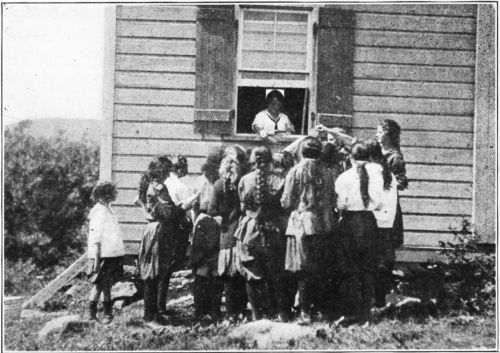 "Special Delivery." Camp Post Office.
"Special Delivery." Camp Post Office.
Inspection follows—all too soon for some. Tents must be in order, grounds around them clean, trash boxes emptied, and each girl in her tent, the chosen leader of the group, called the Patrol Leader, Court of Honor, or Orderly, at the door. The Director hears a murmur, "Here she comes, here she comes"; then all is still. A salute, a thorough look at grounds around, trash box, basins, cots, a look into a blanket or two for fear that hurry has caused some mistakes, and sometimes a look into dress suitcases, for cleanliness, and order must begin on the inside, a word of commendation, a suggestion for improvement and possibly a reprimand, follow.
The bugler announces the time for classes, each group whether far or near changing from one class to another, until the noon hour brings a free period to all.
The signalling class is under the trees back of the mess hall, the First Aid group in a shady spot on the edge of[176] the woods, the basketry class near their base of supplies but sitting on the grass in the shade, the nature lovers in the woods to find new birds and ferns and flowers—and so it goes.
During the working hours, the housekeepers have been busy performing all kinds of necessary camp work. Some Scouts enjoy all of it, others none of it, but rarely does anyone fail to do her part. Dinner is served, the Scouts marching in to the mess hall, as they do for all meals, and being excused when all have finished. Much talking and laughter, but orderliness and courtesy, with an occasional sigh when something does not please, or a prolonged "ah" when it does, make the time and all there is to eat disappear in what seems a short time.
Dinner is followed by rest hour, always difficult for some temperaments, but a real necessity in camp. Sometimes it is necessary to discipline in order to have quiet, or have counsellors on duty near the tents to insure rest. Whatever can be done to make the Scouts realize the importance of obeying this rule, should be done.
Nothing is more looked forward to than the distribution of the mail unless it is the Canteen. A whistle call and all tent representatives fairly fly to the post office window, and eagerly listen for the names of their tent mates. Which group has the most mail—are there any packages?
Letter reading, letter writing, reading, mending, laundry work, fill the time until the afternoon classes begin.
At five-thirty when the call for supper is sounded the Color Guard "fall in" and while all Scouts stand in Company formation at attention the Colors are slowly lowered. The Color Guard is changed every day, each Guard representing a different tent.[177]
After supper, canteen is opened. Perhaps a table out of doors is used as a counter, or one in the mess hall if it does not interfere with housework. Three or four Scouts assist the counsellor who has charge of the canteen and all the goodies on sale for that day are arranged in tempting fashion before the very eyes of the waiting group.
There are so many things to do after supper that each Scout is given the privilege of making her own choice, and can join a group for a row, or a walk, a game of ball or a sing, but all must be back in time for the camp fire, and goodnight songs, First Call, Taps, and evening inspection, and last to make sure that all Scouts are safe and happy and all tents in proper condition, flaps back and sides up when possible.
This closes one day. Others like it may follow, but as a rule no two days are alike. Hikes, visitors, storms, comings and goings, all vary the schedule tremendously, but all are needed to teach us how to camp.
Life is sweet, brother, . . . There's day and night, brother, both sweet things; sun, moon, and stars, all sweet things; there's likewise a wind on the heath.
For Special References on: First Aid, Cooking, Nature Study, Astronomy, Home Nursing and other Scout Activities, see references in section of Proficiency Tests in "Scouting for Girls," the official handbook of the Girl Scouts.
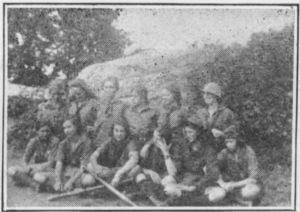 The Victorious Nine
The Victorious Nine
The Girl Scouts, a National Organization, is open to any girl who expresses her desire to join and voluntarily accepts the Promise and the Laws. The object of the Girl Scouts is to bring to all girls the opportunity for group experience, outdoor life and to learn through work, but more through play, to serve their community.
| Honorary President Mrs. Woodrow Wilson First Vice-President Mrs. James J. Storrow Treasurer Mrs. Nicholas F. Brady Counsel Douglas Campbell |
President Mrs. Arthur O. Choate Second Vice-President Mrs. Herbert Hoover Chairman, Executive Board Mrs. V. Everit Macy Director Mrs. Jane Deeter Rippen |
| Executive Board |
| Mrs. Selden Bacon |
| Mrs. Nicholas F. Brady |
| Miss Ellen M. Cassatt |
| Mrs. Arthur O. Choate |
| Francis P. Dodge |
| Miss Emma R. Hall |
| Mrs. Juliette Low |
| Mrs. V. Everit Macy |
| Mrs. William McAdoo |
| Mrs. Robert G. Mead |
| Miss Llewellyn Parsons |
| Mrs. Harold Irving Pratt |
| Mrs. Theodore H. Price |
| Mrs. W. N. Rothschild |
| Mrs. George W. Stevens |
| Mrs. James J. Storrow |
| Mrs. Charles Welch |
| Mrs. Percy H. Williams |
| Education | Chairman | Miss Sarah Louise Arnold |
| Secretary | Dr. Louise Stevens Bryant | |
| Publication | Chairman | Mrs. Josephine Daskam Bacon |
| Secretary | Dr. Louise Stevens Bryant | |
| Field | Chairman | Mrs. Robert G. Mead |
| Secretary | Miss Mary C. Clendenin | |
| Standards | Chairman | Miss Llewellyn Parsons |
| Secretary | Miss Mary C. Clendenin | |
| Business | Chairman | Mrs. Percy Williams |
| Secretary | Mr. Sidney Monroe MacDowell | |
| Finance | Chairman | Mrs. Nicholas F. Brady |
| Advisory Committee on Business and Finance | ||
| Chairman | Mr. Frederic W. Allen | |
A | |
| Achievements | 125 |
| chart record for | 126 |
| A Day in Camp | 174ff |
| American Red Cross | 92 |
| Apple cake | 163, |
| slump | 113 |
| Apples, fried | 163 |
| Application form | 56 |
| Around the Campfire | 137 |
| "A Slack Rag of Canvas" | 18 |
B | |
| Bacon | 164 |
| Basins | 67 |
| Basketry | 55 |
| Bath houses | 83 |
| Bathing place | 85 |
| Bathing suits | 82ff |
| Beans, baked | 164 |
| Bedding | 76 |
| Beds | 64ff |
| Beef, shriveled | 165 |
| Before the Campfire is Lighted | 103 |
| Beets | 169 |
| Beginners in swimming | 85 |
| "Be Prepared", the Signalling Class | 125 |
| "Between Wood and Field" | 10 |
| Biscuit | 161 |
| Blankets | 48, 64, 65, 130 |
| Board rate | 62 |
| Boats and boating | 79ff, 83, 102 |
| Boiled salad dressing | 168 |
| Books on Camps and Camping | 178ff |
| Bread Line, the | 58 |
| Breads | 161 |
| Bryant, Louise Stevens | 7 |
| Builders, the—House Built by Girl Scouts | 118 |
| Buoys | 87 |
| "Business End of Camp Hall" | 29 |
| "By the Shining Big Sea Water" | 25 |
| Byron, Lord | 9 |
C | |
| Cabbage | 169 |
| Cabins, of wood, canvas | 37 |
| Camp Budget | 58ff |
| All other | 60 |
| Boats | 60 |
| Canteen | 60 |
| Cartage | 60 |
| Casual labor | 60 |
| Equipment | 59 |
| Motor upkeep | 60 |
| Opening and closing | 60 |
| Printing | 60 |
| Rental or purchase price of land | 59 |
| Salaries | 60 |
| Stamps | 60 |
| Storage | 60 |
| Telephone | 60 |
| Transportation | 59 |
| Wages | 60 |
| Camp canteen | 54 |
| Camp closing | 47 |
| Camp Directors and Counsellors | 15ff |
| Camper, the | 22ff |
| Campfires | 121, 131ff; |
| to build in rain | 134 |
| Camp foods | 160 |
| Camp, for single Scout troop | 33 |
| Camp house, the | 28ff |
| Camp Health and Camp Safety | 140ff |
| Camp implements | 69 |
| Camp Living Room | 27 |
| Camp log | 55 |
| Camp Menus and Recipes | 157ff |
| Camp Post Office | 175 |
| Camp Program | 93ff |
| Camp Records and Accounts | 50ff |
| Camp Regulations | 39 |
| Camp Sanitation | 140 |
| Camp sings | 113ff |
| Camp songs | 114ff |
| Candles | 71 |
| Candy | 76 |
| Canoes | 87, 122ff |
| Canteen | 76ff |
| Canteen record | 53 |
| Carrots | 170 |
| Cereals | 161 |
| Chaucer | 51 |
| Cheese and eggs | 165 |
| Cheese cloth | 73 |
| Cleaning squad | 65 |
| Closing Camp | 47 |
| [184]Clove Hitch | 42 |
| Cocoa | 112 |
| Codfish, creamed | 165 |
| "Colorado, In high and dry" | 20 |
| Cooking utensils, for campers | 133 |
| Corn | 170 |
| Cornmeal | 161 |
| Counsellors, camp | 15ff |
| Crafts and occupations | 108 |
| Cream sauce | 168 |
| Crew for Life Saving Corps | 87 |
| Crib | 79ff |
| Cucumbers | 167 |
D | |
| Daily program for Girl Scout camp | 97 |
| Dancing | 106ff |
| Deschutes River Fishing Trip | 135ff |
| Desserts | 163ff |
| Directors, camp | 15ff |
| Dishes, washing | 45, |
| for kitchen | 67ff |
| Disinfectants for latrines, for garbage pits | 143 |
| Dives | 100ff |
| Donations | 57 |
| Double boiler | 72 |
| Dried fruit | 163 |
| Dumplings | 162 |
E | |
| Eats | 80 |
| Eggs | 165 |
| Entertainments and diversions | 112ff |
| Equipment for: | |
| boating | 79ff> |
| general | 64ff |
| personal | 74ff |
| swimming | 79 |
| waterfront protection | 85 |
F | |
| Feeding the Multitude | 152 |
| Field Day Program | 55 |
| Fire extinguishers | 42 |
| Fires, out door | 29 |
| Fireplace | 34 |
| Fire prevention | 149 |
| First Aides: Several Kinds of bandages | 131 |
| First Aid, essential supplies | 148 |
| house | 151 |
| Food, for hiking | 129 |
| Foreword | 7 |
| Flatware for table | 68 |
| Float | 83 |
| Floor Plan for Mess Hall | 35 |
| Floor, tent with | 32, |
| without | 20, 33 |
| Flowers | 74 |
| French dressing | 168 |
| Furnishings | 69ff |
G | |
| Games | 72, 105ff |
| Garbage, disposal of | 134, |
| trench for | 142ff |
| General Camp Activities | 98ff |
| General routine from opening to closing camp | 40ff |
| "Girl Scout Hayseeds and the Stack they Made" | 139 |
| Girl Scouts' Laws and Promise | 6 |
| "Good Morrow, Lord Sun" | 90 |
| Goodnight story | 88 |
| Grappling irons | 87 |
H | |
| Handbook of Girl Scouts | 7, 93, 112, 179, 180 |
| Handcrafts | 108 |
| Health Certificate | 51ff |
| Health Winner, the, in camp | 149ff |
| Hikes, | 127ff; |
| daytime | 127, |
| week end | 128, |
| overnight | 130 |
| Horseback riding | 107 |
| Housekeeping squad | 94 |
| Housekeeping outdoors | 43ff |
I | |
| Ice box | 36ff |
| Identification tag | 57 |
| Implements | 69 |
| Indian pudding | 164 |
| Individual account card | 57 |
| Insurance | 49 |
K | |
| Keeping of records | 55ff |
| Kidney and bacon | 166 |
| Kitchen | 28ff, 34 |
| Kitchen furnishings | 69ff |
| Kitchen stove | 49 |
| [185]Komac stew | 166 |
L | |
| Lamps | 67 |
| Land drill | 71, 80 |
| Lanterns | 48, 70ff |
| Latrines, making, care of | 145ff |
| Lavengro | 177 |
| Laws, of Girl Scouts | 6 |
| Laying the fire | 86 |
| Lean-tos | 33, 105, 110, 112 |
| "Lean-to Going Up" | 110 |
| Lettuce | 167 |
| Lice (head) to remove | 150 |
| Life boats | 86ff |
| Life Saving Corps | 85 |
| Red Cross, Women's | 85 |
| Lighting | 70ff |
| Linen | 72 |
| Location | 13ff |
| Log houses | 34ff |
M | |
| Macaroni, with cheese and tomato | 166 |
| Making camp on overnight hike | 78 |
| Master of Aquatics | 85ff |
| McClure, Emily | 7 |
| Meats, fish and meat substitutes | 164ff |
| Menus for overnight hike | 173 |
| Mess Hall, tent | 23, |
| floor plan for | 35 |
| Mills, Captain Fred C., | 7, 85 |
| Miscellaneous records | 55 |
| Monarchs of all they Survey | 92 |
| Morale, camp | 22ff |
| Motto, Girl Scout | 6 |
N | |
| Nearly Finished | 122 |
| Newspapers | 73ff |
O | |
| Oatmeal | 162 |
| Oil heater, Standard | 36 |
| Onions | 170 |
| "Over the Top" | 141 |
P | |
| Packages for Scouts | 77 |
| Pack for hiking | 129 |
| Peas | 170 |
| Personality | 19 |
| Personal Equipment | 74 |
| Personnel, of Life Saving Corps | 88 |
| Pests | 143 |
| Petty cash record | 53 |
| Physical examination of Girl Scout | 49 |
| Pillows | 48, 67, |
| cases | 72 |
| Pitching tents | 40ff |
| Planning Committee | 11ff |
| Planning for camp | 9ff |
| Plays, for use in camp | 178 |
| Play, place in program | 93 |
| Potatoes | 170ff |
| Program for housekeeping squad | 95 |
| Program, camp | 93ff |
| Promise, Girl Scout | 6 |
| Provisions, | 47ff, |
| care of | 154 |
| Provisioning | 152 |
| Publications of Girl Scouts | 180 |
R | |
| Recipes | 161ff |
| Record of provisions | 53ff |
| Record tag | 50 |
| Red Cross Life Saving Corps | 85 |
| Regulations for Camp | 39 |
| Religious Policy | 16ff |
| Rice pudding | 164 |
| Ring buoys | 87 |
| Row boats | 87 |
| Rowing | 75 |
| Rules for swimming | 91 |
S | |
| Salads | 167ff |
| Sardines and tomato sauce | 167 |
| Sauces and dressings | 168ff |
| Scalloped tomatoes | 172 |
| "Scouting for Girls" | 7 |
| Scout Laws | 6, 94 |
| Scout Promise | 6, 94 |
| Scrambled eggs | 165 |
| Scrubbing up Before Meals | 48 |
| Serving table | 41 |
| Setting out for the water hike | 84 |
| Sheets | 72 |
| Shoes, for hiking | 128 |
| Site | 14ff |
| Slab House | 33 |
| Slogan, Girl Scout | 6 |
| Soups | 169 |
| [186]Special Delivery | 175 |
| Spinach | 171 |
| Sports | 99 |
| Squad, housekeeping | 94ff |
| Squash | 171 |
| Stew, Irish | 167 |
| Store closet | 36 |
| Stove | 69ff |
| String beans | 171 |
| Suits, bathing | 82 |
| Sun Clock | 94 |
| Sunday dinner | 22 |
| Supervision of bathing | 91ff |
| Swimmers, equipment for | 82ff, 85ff |
| Swimming crib | 69, 79ff, 81 |
| Swimming strokes | 100 |
| Swimming test | 90 |
T | |
| Table manners | 46 |
| Tag for Scouts arriving in camp | 38 |
| Team Work In Potato Paring | 44 |
| "Tent Green" | 12 |
| Tents | 28ff |
| chart for | 50ff |
| conical | 12, 30 |
| floors | 16, 32 |
| mess | 28, 58 |
| pitching | 32, 40 |
| pyramidal | 30 |
| size | 30ff |
| taking down | 47 |
| wall | 10, 18, 30ff |
| without floors | 33 |
| The Morning After | 82 |
| The Town Pump | 46 |
| Toast | 162 |
| Toilet accessories | 76 |
| To Keep the Home Fires Burning | 133 |
| Tomatoes | 172ff |
| salad | 168 |
| sauce | 169 |
| Top of the Morning | 100 |
| Tower, for bathing | 86 |
| Training, life saving | 89 |
| Transportation | 12ff |
| Trash, disposition of | 72, 140ff |
| Twin Lake Council Application Form | 56 |
U | |
| "Under the Greenwood Tree" | 2 |
| Underwear | 76 |
V | |
| Vegetables | 69ff |
| Victorious Nine | 179 |
| Volley ball | 146 |
W | |
| Wall tent | 18, 32 |
| Wash house | 37ff |
| Washing dishes | 45 |
| Water front protection | 85ff |
| Water glasses | 87 |
| Water sports day, program for | 104ff |
| Water supply | 144ff |
| Weighing scales | 72 |
| Well built floors | 16 |
| Women's Life Saving Corps, American Red Cross | 101 |
| Woodcraft | 109ff |
| camp discipline | 112 |
| camp site | 111 |
| trail making | 111 |
| trip planning | 111 |
| Wood cutters | 105 |
| Wilkeson, Catherine | 7 |
| "Wise Virgins" | 67 |
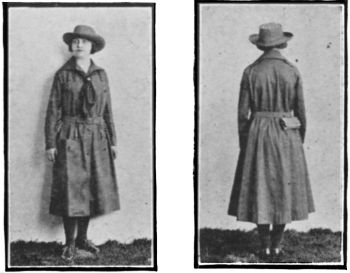 Long Coat "The Combination Dress"
Long Coat "The Combination Dress"
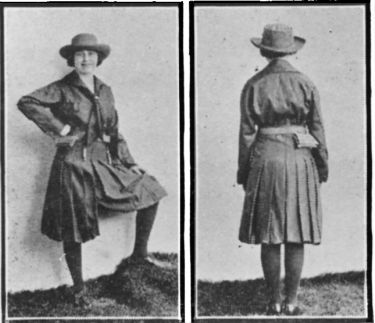 Shirt Waist and Bloomers
Shirt Waist and Bloomers
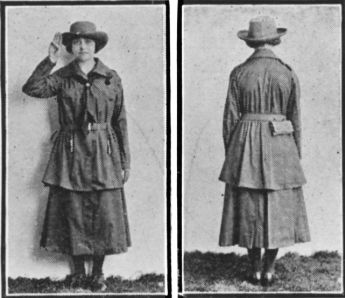 Short Coat and Skirt
Short Coat and Skirt
Operating under National supervision the Girl Scout Supply Department carries a complete and attractive line of equipment for girls. It is the purpose of this branch to give the Scout her equipment at lowest possible cost. Official equipment is sold to members of Registered Troops on formal presentation by Scout of her voucher signed by her Captain.
Price lists will be furnished upon application and money must be sent with order as the equipment is handled on a strictly cash basis. Owing to the irregularity of the market these prices will change from time to time but a revised price list will be printed every two months until the market is more stable.
Sizes should be given when ordering uniforms; this applies also to hats and belts. Find out from jeweler size of ring needed.
These will be furnished you free of charge upon application and are specially prepared forms which make ordering easy. Give your full name and address and if ordering from a local council be sure to give the name of your council and then your own name.
This is a form to be used by the individual Scout when purchasing equipment. It is the certification by the Captain that the Scout is entitled to buy equipment, and no equipment can be sold except on presentation of this voucher.
A size 7 hat measures 215/8" in circumference inside, or the actual distance around the child's head. For each 3/8" in head size order hat 1/8 size larger.
It requires at least 10 days after receipt of order to obtain flag from manufacturer. Be sure to write plainly the exact lettering you wish.
| Size | Material | Price | |
| No. 1 | 22" x 36" | Cotton and Wool | $ 2.50 |
| No. 2 | 2½ x 4 ft. | Wool | 6.35 |
| No. 3 | 3' x 5' | " | 7.35 |
| No. 4 | 4' x 6' | " | 9.10 |
| No. 5 | 5' x 8' | " | 10.65 |
| No. 6 | 6' x 10' | " | 20.00 |
| No. 1—10c | per | letter |
| No. 2—13c | " | " |
| No. 3—15c | " | " |
| No. 4—16c | " | " |
| No. 5—20c | " | " |
| No. 6—25c | " | " |
| Plain—½" x 8ft—30c. |
| Jointed 1" x 8 ft—With Eagle for American Flag,.............$4.90 |
| Jointed 1" x 8 ft., With Solid Spear for Troop Flag,...............$3.20 |
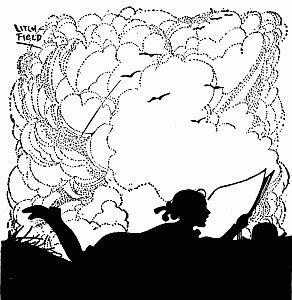
| What
If You are a |
LEFAXFACTS ON LEAVES(Loose Leaf) Lefax represents positively the last word in record-keeping. Here are found data sheets covering all of the important scientific branches, as well as sheets of general information. |
Lefax blank forms take care of your own notes and data. They are reasonable in price and cover every possible field.
Lefax Monthly Magazine is printed Lefax size and is so arranged that any article may be instantly removed and incorporated in your records.
The Lefax page is a convenient size, 6¾ x 3¾ inches.
The Lefax Filing Index which appears on all sheets makes systematic filing easy. All the data sheets are also classified according to the Dewey-Decimal System. Full particulars will be gladly sent on request.
Note—The Constitution and By-Laws of the Girl Scouts have been printed in the Lefax form. Have you seen this booklet?

[A] Supply Captain's name.
Obvious punctuation errors repaired.
Page 9, Table of Contents, "182" changed to "183" because page 182 is blank and the index starts on 183.
The remaining corrections made are indicated by dotted lines under the corrections. Scroll the mouse over the word and the original text will appear.
End of the Project Gutenberg EBook of Campward Ho!, by Unknown
*** END OF THIS PROJECT GUTENBERG EBOOK CAMPWARD HO! ***
***** This file should be named 33767-h.htm or 33767-h.zip *****
This and all associated files of various formats will be found in:
https://www.gutenberg.org/3/3/7/6/33767/
Produced by David Edwards, Emmy and the Online Distributed
Proofreading Team at https://www.pgdp.net (This book was
produced from scanned images of public domain material
from the Google Print project.)
Updated editions will replace the previous one--the old editions
will be renamed.
Creating the works from public domain print editions means that no
one owns a United States copyright in these works, so the Foundation
(and you!) can copy and distribute it in the United States without
permission and without paying copyright royalties. Special rules,
set forth in the General Terms of Use part of this license, apply to
copying and distributing Project Gutenberg-tm electronic works to
protect the PROJECT GUTENBERG-tm concept and trademark. Project
Gutenberg is a registered trademark, and may not be used if you
charge for the eBooks, unless you receive specific permission. If you
do not charge anything for copies of this eBook, complying with the
rules is very easy. You may use this eBook for nearly any purpose
such as creation of derivative works, reports, performances and
research. They may be modified and printed and given away--you may do
practically ANYTHING with public domain eBooks. Redistribution is
subject to the trademark license, especially commercial
redistribution.
*** START: FULL LICENSE ***
THE FULL PROJECT GUTENBERG LICENSE
PLEASE READ THIS BEFORE YOU DISTRIBUTE OR USE THIS WORK
To protect the Project Gutenberg-tm mission of promoting the free
distribution of electronic works, by using or distributing this work
(or any other work associated in any way with the phrase "Project
Gutenberg"), you agree to comply with all the terms of the Full Project
Gutenberg-tm License (available with this file or online at
https://gutenberg.org/license).
Section 1. General Terms of Use and Redistributing Project Gutenberg-tm
electronic works
1.A. By reading or using any part of this Project Gutenberg-tm
electronic work, you indicate that you have read, understand, agree to
and accept all the terms of this license and intellectual property
(trademark/copyright) agreement. If you do not agree to abide by all
the terms of this agreement, you must cease using and return or destroy
all copies of Project Gutenberg-tm electronic works in your possession.
If you paid a fee for obtaining a copy of or access to a Project
Gutenberg-tm electronic work and you do not agree to be bound by the
terms of this agreement, you may obtain a refund from the person or
entity to whom you paid the fee as set forth in paragraph 1.E.8.
1.B. "Project Gutenberg" is a registered trademark. It may only be
used on or associated in any way with an electronic work by people who
agree to be bound by the terms of this agreement. There are a few
things that you can do with most Project Gutenberg-tm electronic works
even without complying with the full terms of this agreement. See
paragraph 1.C below. There are a lot of things you can do with Project
Gutenberg-tm electronic works if you follow the terms of this agreement
and help preserve free future access to Project Gutenberg-tm electronic
works. See paragraph 1.E below.
1.C. The Project Gutenberg Literary Archive Foundation ("the Foundation"
or PGLAF), owns a compilation copyright in the collection of Project
Gutenberg-tm electronic works. Nearly all the individual works in the
collection are in the public domain in the United States. If an
individual work is in the public domain in the United States and you are
located in the United States, we do not claim a right to prevent you from
copying, distributing, performing, displaying or creating derivative
works based on the work as long as all references to Project Gutenberg
are removed. Of course, we hope that you will support the Project
Gutenberg-tm mission of promoting free access to electronic works by
freely sharing Project Gutenberg-tm works in compliance with the terms of
this agreement for keeping the Project Gutenberg-tm name associated with
the work. You can easily comply with the terms of this agreement by
keeping this work in the same format with its attached full Project
Gutenberg-tm License when you share it without charge with others.
1.D. The copyright laws of the place where you are located also govern
what you can do with this work. Copyright laws in most countries are in
a constant state of change. If you are outside the United States, check
the laws of your country in addition to the terms of this agreement
before downloading, copying, displaying, performing, distributing or
creating derivative works based on this work or any other Project
Gutenberg-tm work. The Foundation makes no representations concerning
the copyright status of any work in any country outside the United
States.
1.E. Unless you have removed all references to Project Gutenberg:
1.E.1. The following sentence, with active links to, or other immediate
access to, the full Project Gutenberg-tm License must appear prominently
whenever any copy of a Project Gutenberg-tm work (any work on which the
phrase "Project Gutenberg" appears, or with which the phrase "Project
Gutenberg" is associated) is accessed, displayed, performed, viewed,
copied or distributed:
This eBook is for the use of anyone anywhere at no cost and with
almost no restrictions whatsoever. You may copy it, give it away or
re-use it under the terms of the Project Gutenberg License included
with this eBook or online at www.gutenberg.org
1.E.2. If an individual Project Gutenberg-tm electronic work is derived
from the public domain (does not contain a notice indicating that it is
posted with permission of the copyright holder), the work can be copied
and distributed to anyone in the United States without paying any fees
or charges. If you are redistributing or providing access to a work
with the phrase "Project Gutenberg" associated with or appearing on the
work, you must comply either with the requirements of paragraphs 1.E.1
through 1.E.7 or obtain permission for the use of the work and the
Project Gutenberg-tm trademark as set forth in paragraphs 1.E.8 or
1.E.9.
1.E.3. If an individual Project Gutenberg-tm electronic work is posted
with the permission of the copyright holder, your use and distribution
must comply with both paragraphs 1.E.1 through 1.E.7 and any additional
terms imposed by the copyright holder. Additional terms will be linked
to the Project Gutenberg-tm License for all works posted with the
permission of the copyright holder found at the beginning of this work.
1.E.4. Do not unlink or detach or remove the full Project Gutenberg-tm
License terms from this work, or any files containing a part of this
work or any other work associated with Project Gutenberg-tm.
1.E.5. Do not copy, display, perform, distribute or redistribute this
electronic work, or any part of this electronic work, without
prominently displaying the sentence set forth in paragraph 1.E.1 with
active links or immediate access to the full terms of the Project
Gutenberg-tm License.
1.E.6. You may convert to and distribute this work in any binary,
compressed, marked up, nonproprietary or proprietary form, including any
word processing or hypertext form. However, if you provide access to or
distribute copies of a Project Gutenberg-tm work in a format other than
"Plain Vanilla ASCII" or other format used in the official version
posted on the official Project Gutenberg-tm web site (www.gutenberg.org),
you must, at no additional cost, fee or expense to the user, provide a
copy, a means of exporting a copy, or a means of obtaining a copy upon
request, of the work in its original "Plain Vanilla ASCII" or other
form. Any alternate format must include the full Project Gutenberg-tm
License as specified in paragraph 1.E.1.
1.E.7. Do not charge a fee for access to, viewing, displaying,
performing, copying or distributing any Project Gutenberg-tm works
unless you comply with paragraph 1.E.8 or 1.E.9.
1.E.8. You may charge a reasonable fee for copies of or providing
access to or distributing Project Gutenberg-tm electronic works provided
that
- You pay a royalty fee of 20% of the gross profits you derive from
the use of Project Gutenberg-tm works calculated using the method
you already use to calculate your applicable taxes. The fee is
owed to the owner of the Project Gutenberg-tm trademark, but he
has agreed to donate royalties under this paragraph to the
Project Gutenberg Literary Archive Foundation. Royalty payments
must be paid within 60 days following each date on which you
prepare (or are legally required to prepare) your periodic tax
returns. Royalty payments should be clearly marked as such and
sent to the Project Gutenberg Literary Archive Foundation at the
address specified in Section 4, "Information about donations to
the Project Gutenberg Literary Archive Foundation."
- You provide a full refund of any money paid by a user who notifies
you in writing (or by e-mail) within 30 days of receipt that s/he
does not agree to the terms of the full Project Gutenberg-tm
License. You must require such a user to return or
destroy all copies of the works possessed in a physical medium
and discontinue all use of and all access to other copies of
Project Gutenberg-tm works.
- You provide, in accordance with paragraph 1.F.3, a full refund of any
money paid for a work or a replacement copy, if a defect in the
electronic work is discovered and reported to you within 90 days
of receipt of the work.
- You comply with all other terms of this agreement for free
distribution of Project Gutenberg-tm works.
1.E.9. If you wish to charge a fee or distribute a Project Gutenberg-tm
electronic work or group of works on different terms than are set
forth in this agreement, you must obtain permission in writing from
both the Project Gutenberg Literary Archive Foundation and Michael
Hart, the owner of the Project Gutenberg-tm trademark. Contact the
Foundation as set forth in Section 3 below.
1.F.
1.F.1. Project Gutenberg volunteers and employees expend considerable
effort to identify, do copyright research on, transcribe and proofread
public domain works in creating the Project Gutenberg-tm
collection. Despite these efforts, Project Gutenberg-tm electronic
works, and the medium on which they may be stored, may contain
"Defects," such as, but not limited to, incomplete, inaccurate or
corrupt data, transcription errors, a copyright or other intellectual
property infringement, a defective or damaged disk or other medium, a
computer virus, or computer codes that damage or cannot be read by
your equipment.
1.F.2. LIMITED WARRANTY, DISCLAIMER OF DAMAGES - Except for the "Right
of Replacement or Refund" described in paragraph 1.F.3, the Project
Gutenberg Literary Archive Foundation, the owner of the Project
Gutenberg-tm trademark, and any other party distributing a Project
Gutenberg-tm electronic work under this agreement, disclaim all
liability to you for damages, costs and expenses, including legal
fees. YOU AGREE THAT YOU HAVE NO REMEDIES FOR NEGLIGENCE, STRICT
LIABILITY, BREACH OF WARRANTY OR BREACH OF CONTRACT EXCEPT THOSE
PROVIDED IN PARAGRAPH 1.F.3. YOU AGREE THAT THE FOUNDATION, THE
TRADEMARK OWNER, AND ANY DISTRIBUTOR UNDER THIS AGREEMENT WILL NOT BE
LIABLE TO YOU FOR ACTUAL, DIRECT, INDIRECT, CONSEQUENTIAL, PUNITIVE OR
INCIDENTAL DAMAGES EVEN IF YOU GIVE NOTICE OF THE POSSIBILITY OF SUCH
DAMAGE.
1.F.3. LIMITED RIGHT OF REPLACEMENT OR REFUND - If you discover a
defect in this electronic work within 90 days of receiving it, you can
receive a refund of the money (if any) you paid for it by sending a
written explanation to the person you received the work from. If you
received the work on a physical medium, you must return the medium with
your written explanation. The person or entity that provided you with
the defective work may elect to provide a replacement copy in lieu of a
refund. If you received the work electronically, the person or entity
providing it to you may choose to give you a second opportunity to
receive the work electronically in lieu of a refund. If the second copy
is also defective, you may demand a refund in writing without further
opportunities to fix the problem.
1.F.4. Except for the limited right of replacement or refund set forth
in paragraph 1.F.3, this work is provided to you 'AS-IS' WITH NO OTHER
WARRANTIES OF ANY KIND, EXPRESS OR IMPLIED, INCLUDING BUT NOT LIMITED TO
WARRANTIES OF MERCHANTIBILITY OR FITNESS FOR ANY PURPOSE.
1.F.5. Some states do not allow disclaimers of certain implied
warranties or the exclusion or limitation of certain types of damages.
If any disclaimer or limitation set forth in this agreement violates the
law of the state applicable to this agreement, the agreement shall be
interpreted to make the maximum disclaimer or limitation permitted by
the applicable state law. The invalidity or unenforceability of any
provision of this agreement shall not void the remaining provisions.
1.F.6. INDEMNITY - You agree to indemnify and hold the Foundation, the
trademark owner, any agent or employee of the Foundation, anyone
providing copies of Project Gutenberg-tm electronic works in accordance
with this agreement, and any volunteers associated with the production,
promotion and distribution of Project Gutenberg-tm electronic works,
harmless from all liability, costs and expenses, including legal fees,
that arise directly or indirectly from any of the following which you do
or cause to occur: (a) distribution of this or any Project Gutenberg-tm
work, (b) alteration, modification, or additions or deletions to any
Project Gutenberg-tm work, and (c) any Defect you cause.
Section 2. Information about the Mission of Project Gutenberg-tm
Project Gutenberg-tm is synonymous with the free distribution of
electronic works in formats readable by the widest variety of computers
including obsolete, old, middle-aged and new computers. It exists
because of the efforts of hundreds of volunteers and donations from
people in all walks of life.
Volunteers and financial support to provide volunteers with the
assistance they need are critical to reaching Project Gutenberg-tm's
goals and ensuring that the Project Gutenberg-tm collection will
remain freely available for generations to come. In 2001, the Project
Gutenberg Literary Archive Foundation was created to provide a secure
and permanent future for Project Gutenberg-tm and future generations.
To learn more about the Project Gutenberg Literary Archive Foundation
and how your efforts and donations can help, see Sections 3 and 4
and the Foundation web page at https://www.pglaf.org.
Section 3. Information about the Project Gutenberg Literary Archive
Foundation
The Project Gutenberg Literary Archive Foundation is a non profit
501(c)(3) educational corporation organized under the laws of the
state of Mississippi and granted tax exempt status by the Internal
Revenue Service. The Foundation's EIN or federal tax identification
number is 64-6221541. Its 501(c)(3) letter is posted at
https://pglaf.org/fundraising. Contributions to the Project Gutenberg
Literary Archive Foundation are tax deductible to the full extent
permitted by U.S. federal laws and your state's laws.
The Foundation's principal office is located at 4557 Melan Dr. S.
Fairbanks, AK, 99712., but its volunteers and employees are scattered
throughout numerous locations. Its business office is located at
809 North 1500 West, Salt Lake City, UT 84116, (801) 596-1887, email
business@pglaf.org. Email contact links and up to date contact
information can be found at the Foundation's web site and official
page at https://pglaf.org
For additional contact information:
Dr. Gregory B. Newby
Chief Executive and Director
gbnewby@pglaf.org
Section 4. Information about Donations to the Project Gutenberg
Literary Archive Foundation
Project Gutenberg-tm depends upon and cannot survive without wide
spread public support and donations to carry out its mission of
increasing the number of public domain and licensed works that can be
freely distributed in machine readable form accessible by the widest
array of equipment including outdated equipment. Many small donations
($1 to $5,000) are particularly important to maintaining tax exempt
status with the IRS.
The Foundation is committed to complying with the laws regulating
charities and charitable donations in all 50 states of the United
States. Compliance requirements are not uniform and it takes a
considerable effort, much paperwork and many fees to meet and keep up
with these requirements. We do not solicit donations in locations
where we have not received written confirmation of compliance. To
SEND DONATIONS or determine the status of compliance for any
particular state visit https://pglaf.org
While we cannot and do not solicit contributions from states where we
have not met the solicitation requirements, we know of no prohibition
against accepting unsolicited donations from donors in such states who
approach us with offers to donate.
International donations are gratefully accepted, but we cannot make
any statements concerning tax treatment of donations received from
outside the United States. U.S. laws alone swamp our small staff.
Please check the Project Gutenberg Web pages for current donation
methods and addresses. Donations are accepted in a number of other
ways including including checks, online payments and credit card
donations. To donate, please visit: https://pglaf.org/donate
Section 5. General Information About Project Gutenberg-tm electronic
works.
Professor Michael S. Hart was the originator of the Project Gutenberg-tm
concept of a library of electronic works that could be freely shared
with anyone. For thirty years, he produced and distributed Project
Gutenberg-tm eBooks with only a loose network of volunteer support.
Project Gutenberg-tm eBooks are often created from several printed
editions, all of which are confirmed as Public Domain in the U.S.
unless a copyright notice is included. Thus, we do not necessarily
keep eBooks in compliance with any particular paper edition.
Most people start at our Web site which has the main PG search facility:
https://www.gutenberg.org
This Web site includes information about Project Gutenberg-tm,
including how to make donations to the Project Gutenberg Literary
Archive Foundation, how to help produce our new eBooks, and how to
subscribe to our email newsletter to hear about new eBooks.